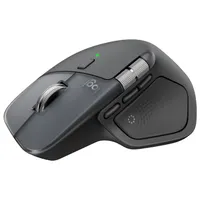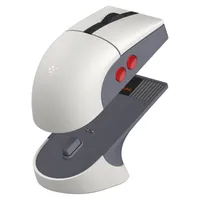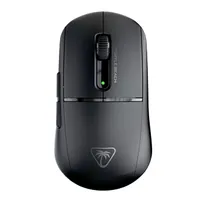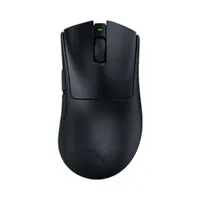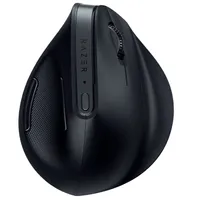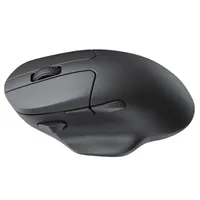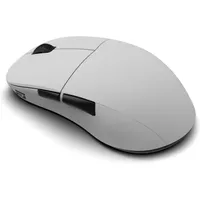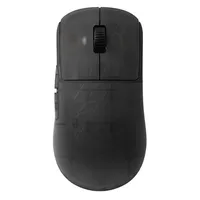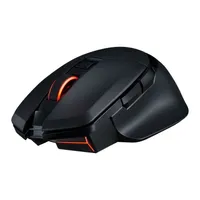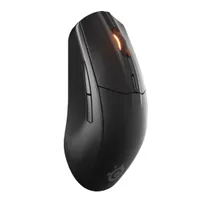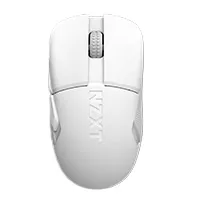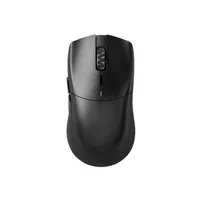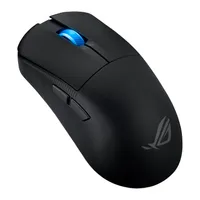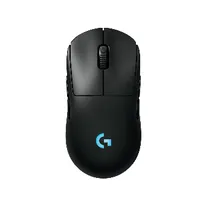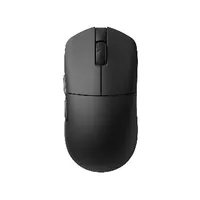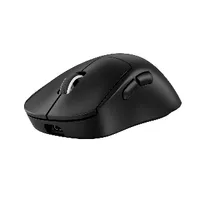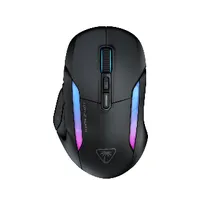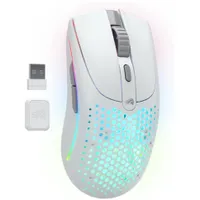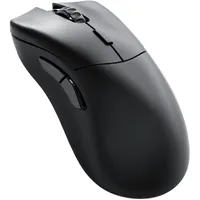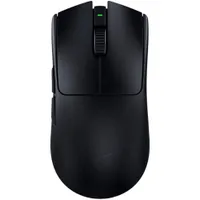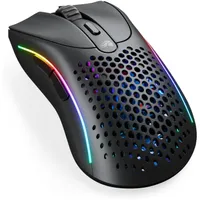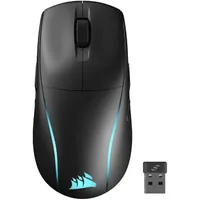Best wireless gaming mouse in 2025: These are the rodents I love getting my mitts on
Let go of the tethers and embrace the freedom of living life cable-free.
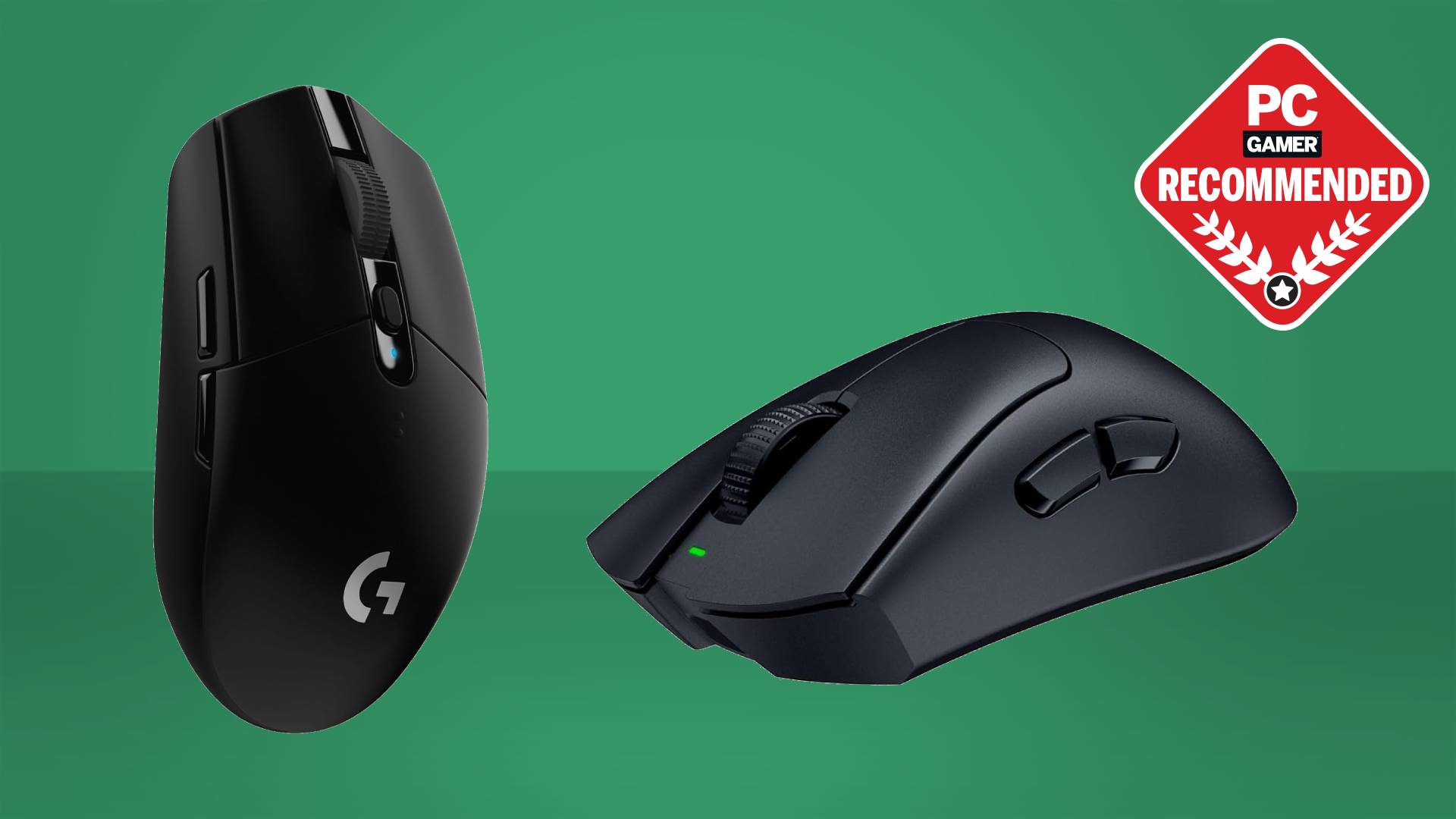
Wireless gaming mice deliver the precision of the best gaming mouse without the hassle of wires. No drag, no tugging on the cable when it gets caught under the corner of your monitor, just cable-free action to suit your gaming style. And right now, the best wireless gaming mouse is the Razer Deathadder V4 Pro, thanks to its incredibly smooth sensor, beautiful coating, and lovely dongle. Yes, you read that right.
If you're watching your pennies, the best budget wireless gaming mouse is Logitech's G305 Lightspeed. It doesn't have lots of features, but it doesn't have a high price tag, either.
Deciding which model to buy should be based on the same criteria as buying a wired gaming mouse, such as the number of buttons you need and how light or heavy you want it to be. There are a few wireless-specific questions you'll need to ask, though, like the type of connection and battery life.
The quick list
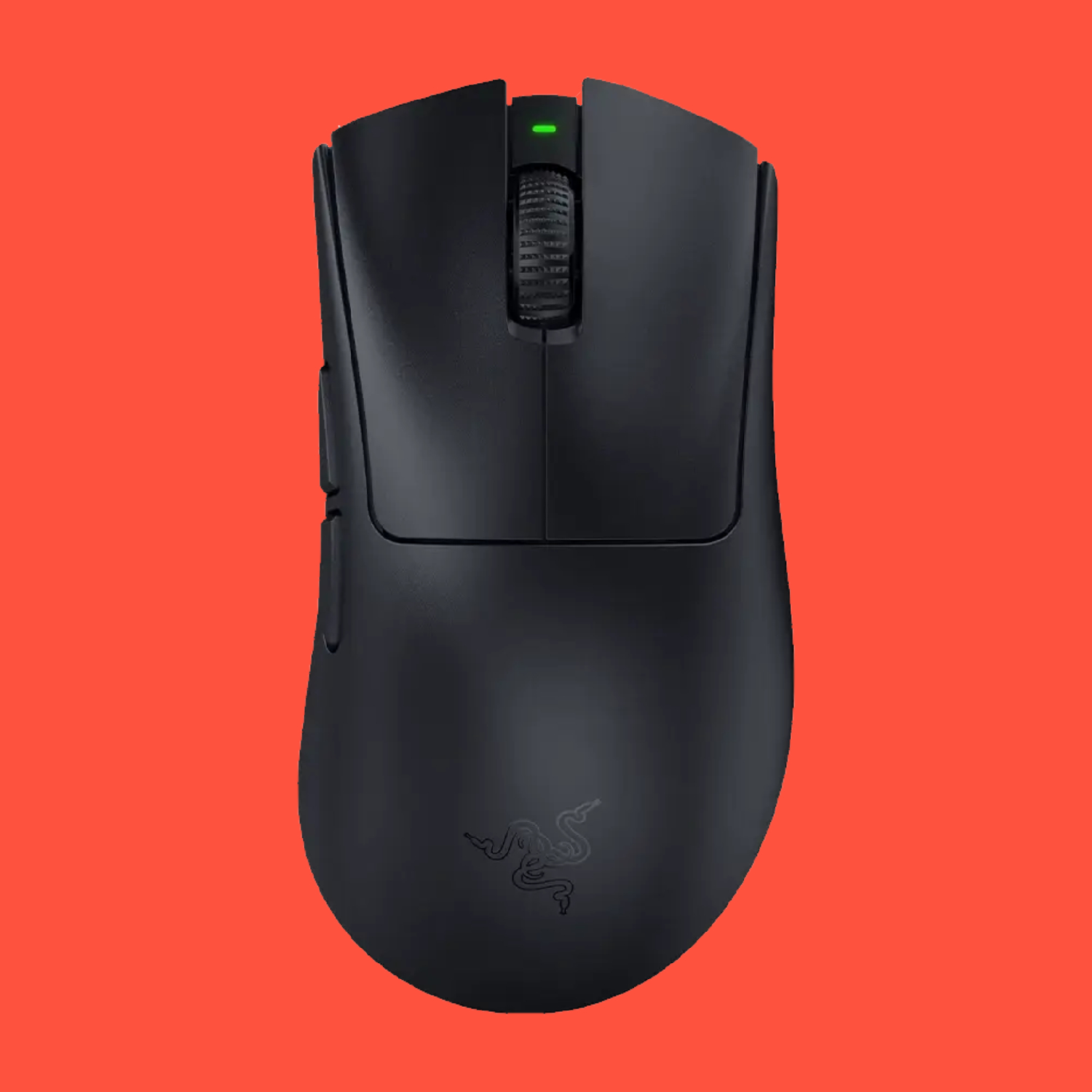
The best overall
You don't have to be a pro to appreciate this incredible gaming mouse, we promise. With a fabulous coating, a sensor that puts all others in the shade, and a dongle that delivers, Razer has tweaked the DeathAdder recipe once more to take the absolute top spot in this guide.
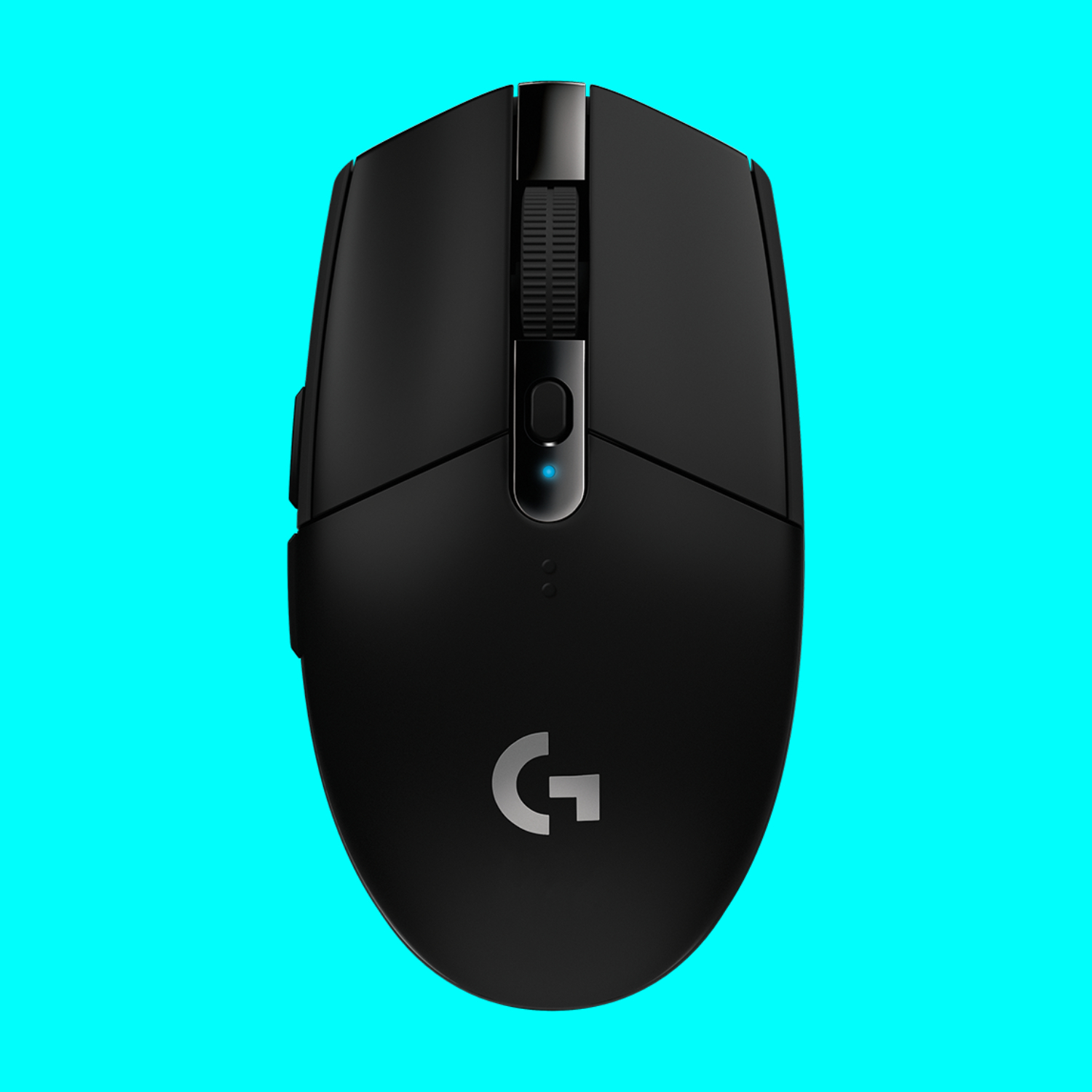
The best budget
A superb back-to-basics gaming mouse, the G305 Lightspeed is a super affordable way to nab a great Logitec sensor. It's not a complex mouse, but it will last ages on a single AA battery, and it's as light as anything.
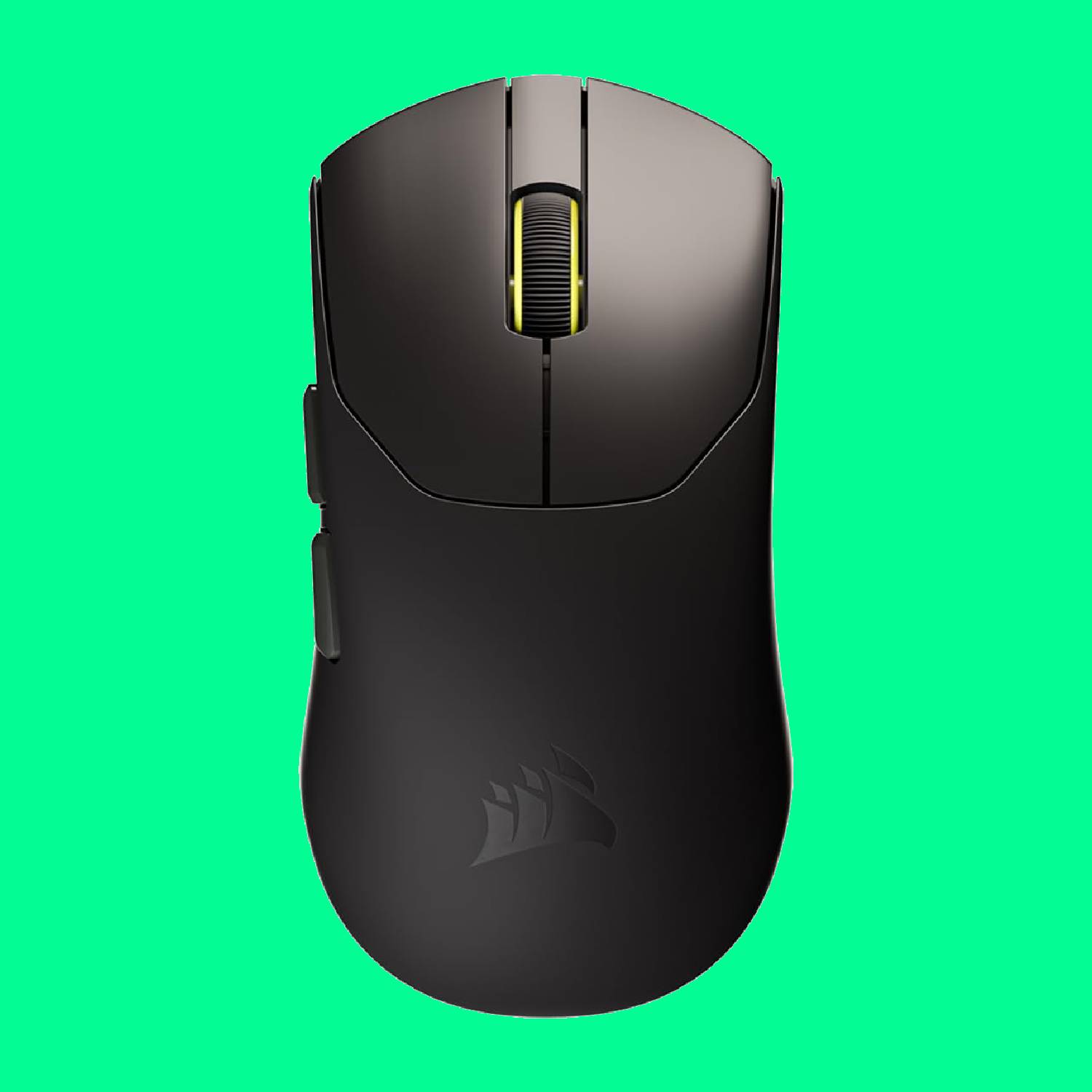
The best lightweight
This mouse has taken lightweight a step further than we've seen before and is one of the absolute lightest rodents you'll find today. It's priced well and free of all bells and whistles, and its sensor and wireless connection is incredibly performant too.
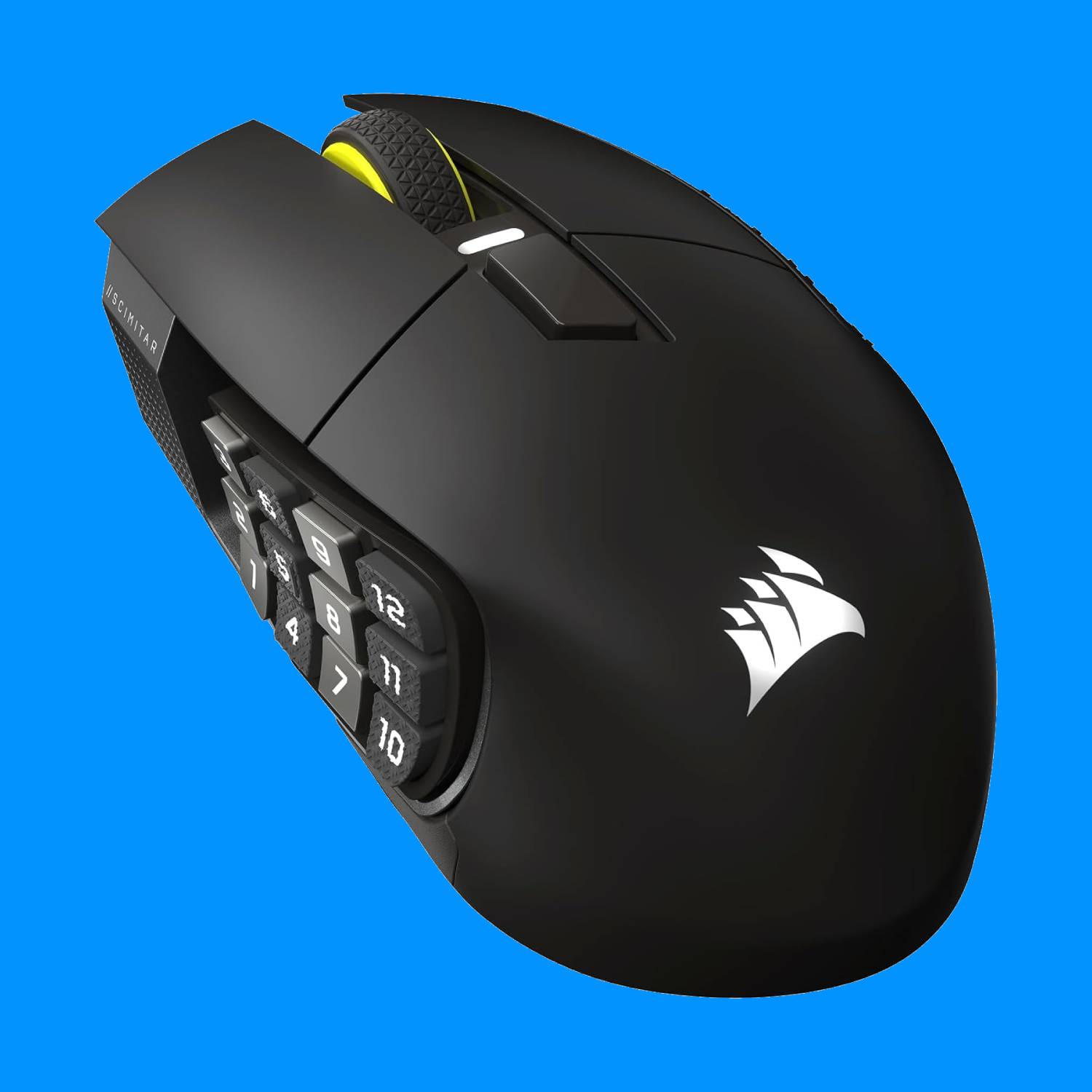
The best MMO
The Corsair Scimitar Elite Wireless SE has more than enough buttons for any MMO/MOBA gamer, and it even supports Stream Deck functions making it a great choice for streamers, too. Its side-button panel is also movable, so you can position it just right.
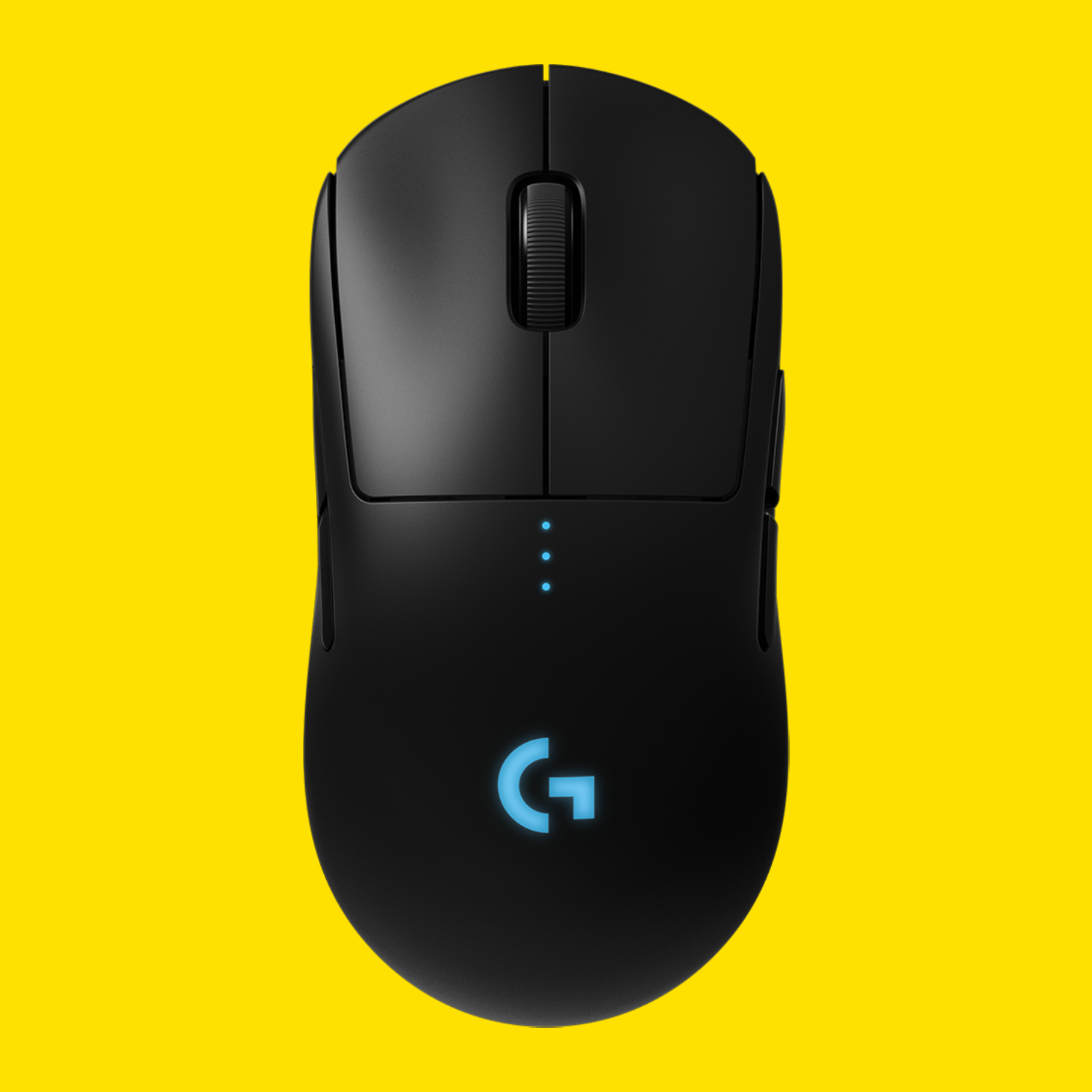
The best ambidextrous
This might look like a right-handed mouse, but thanks to some swappable side buttons, it's actually an ambidextrous wonder. The G Pro 2 is also a great pick, but you can buy the OG G Pro for much less and it's damn near as good.

The best ergonomic
The Keychron M5 brings genuine gaming performance to the ergonomic vertical shape. Not only are you getting all the benefits of an ergo mouse—primarily comfort and reduced risk of RSI—but you're also getting a great sensor, all for a very reasonable price.
⬇️ Click to load more of the best gaming mice⬇️
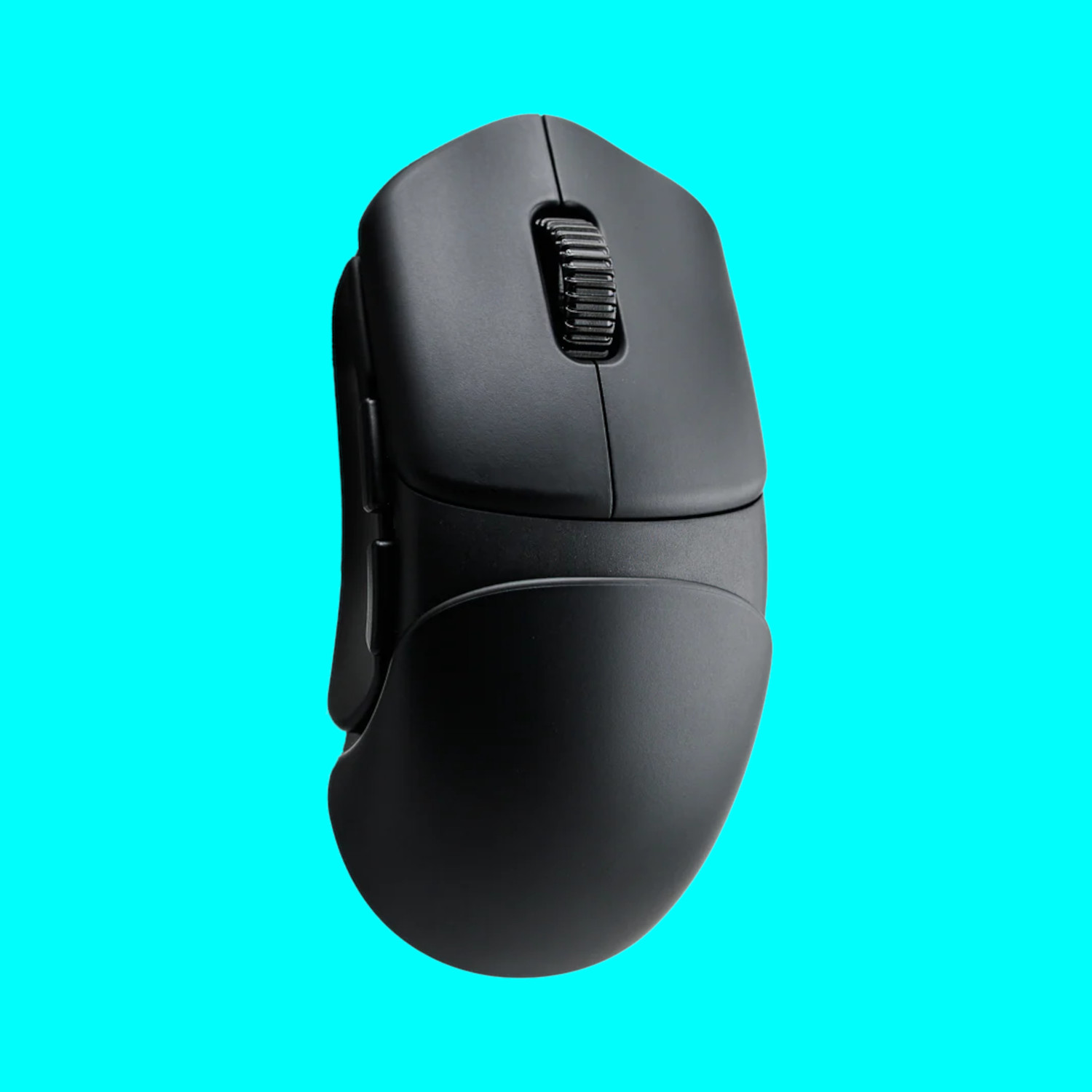
The best customizable
At first glance, the Pathfinder just looks like a well-specced modern gaming mouse, with a fast sensor, low weight, and 8 kHz wireless polling. What sets it apart from the crowd is that the rear and side panels can all be swapped about to create a mouse that fits your hand perfectly.

Dave has been mousing since the grinty ball days of the Amiga and was converted to the claw grip the moment he played Shareware Doom for the first time. Having professionally flung them around his test desk for the best part of twenty years, he knows what makes a good wireless mouse, what a responsive gaming mouse needs to be, and just how many buttons you really need on your PC's rodent.
18 November, 2025: We added a new category to this guide, the best customizable gaming mouse, with the Orbital Pathfinder being our top recommendation for this new entry. There aren't many mice on the market that allow you to swap panels and shell parts to get the perfect shape for your hand, but that's exactly what the Pathfinder lets you do, and it's very well specced to boot.
1 October, 2025: Added two new Corsair mice to our list, swapping them out for the previous Turtle Beach and Razer picks, which are now sitting in our Also Tested section. The Corsair Sabre V2 Pro is the best lightweight wireless gaming mouse because, well, it weighs just 36 g, and that's an incredible feat for such a solid and performant rodent. The Corsair Scimitar Elite Wireless SE is the best for MMOs because it's a copiously buttoned mouse that has a ton of functionality, and even lets you move around its side button panel to suit your hand and thumb position.
30 July, 2025: We've crowned the Razer Deathadder V4 Pro as the new king of this guide, or to put it more accurately, added it in as our pick for the best gaming mouse overall. It's a refinement on an already-wonderful recipe, but thanks to its deliciously smooth sensor, an excellent feeling coating, and upgrade scroll wheel, among others, the DeathAdder V4 Pro is now the gaming mouse to beat as far as we're concerned.
The best wireless gaming mouse
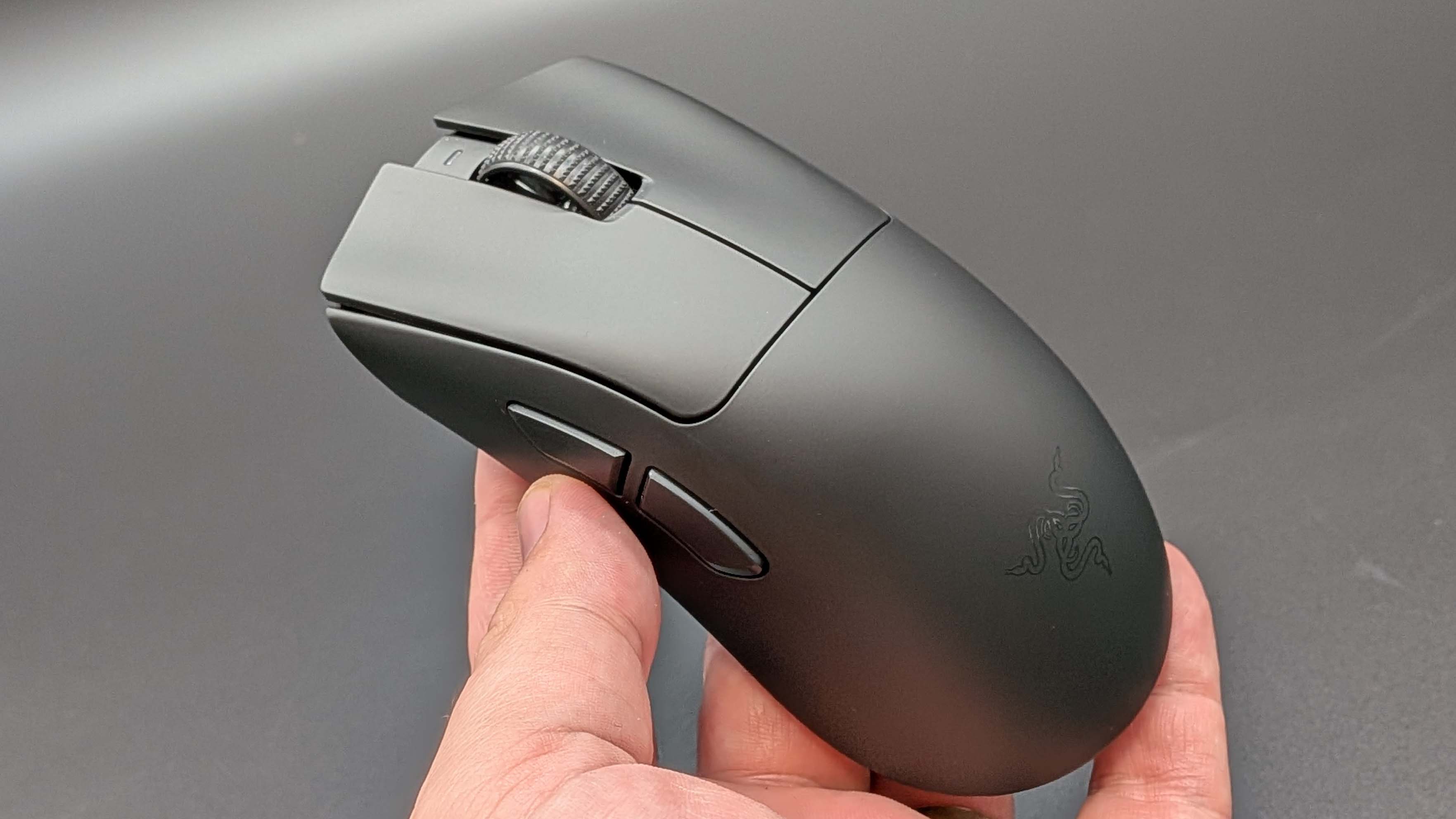

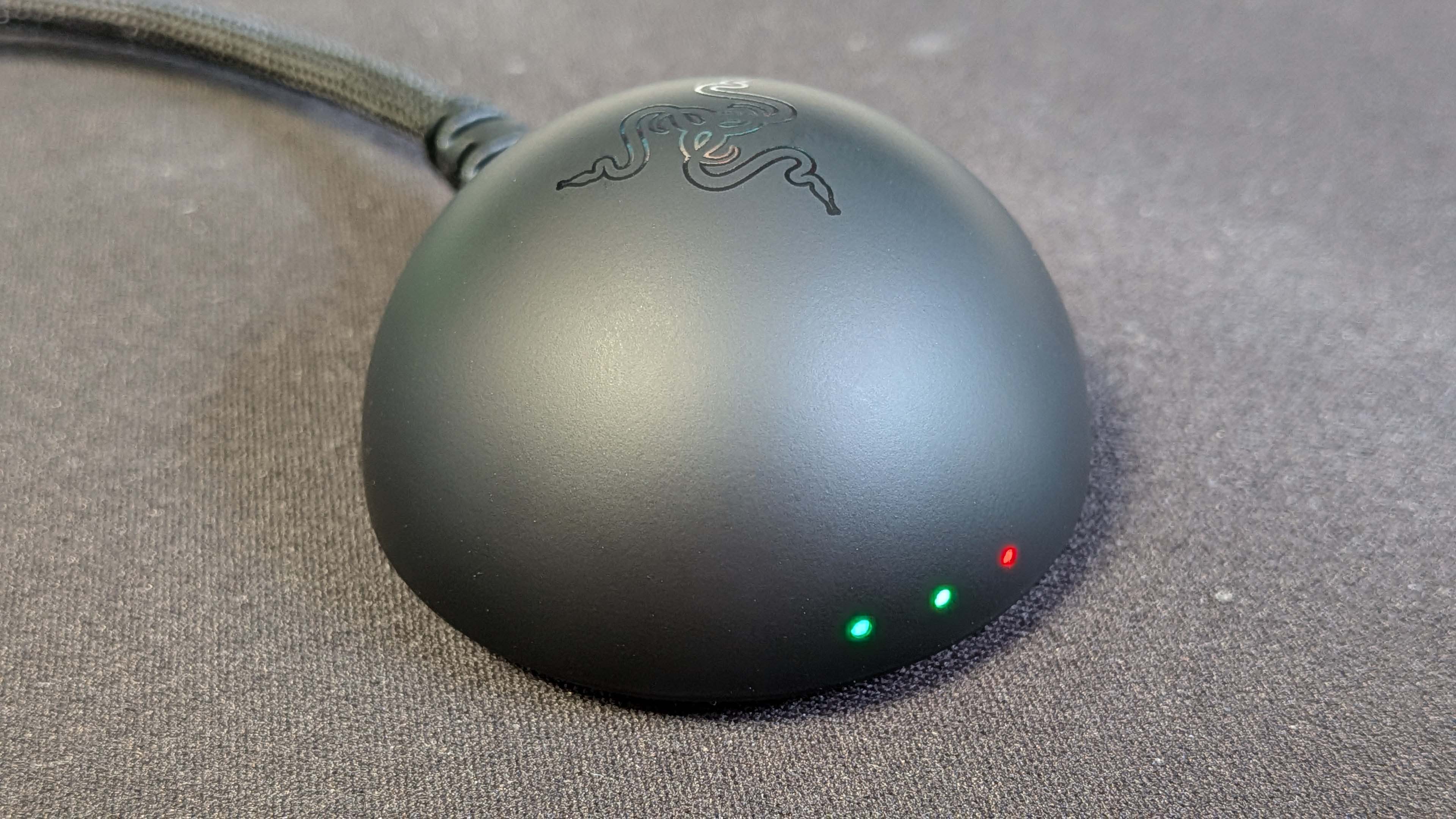
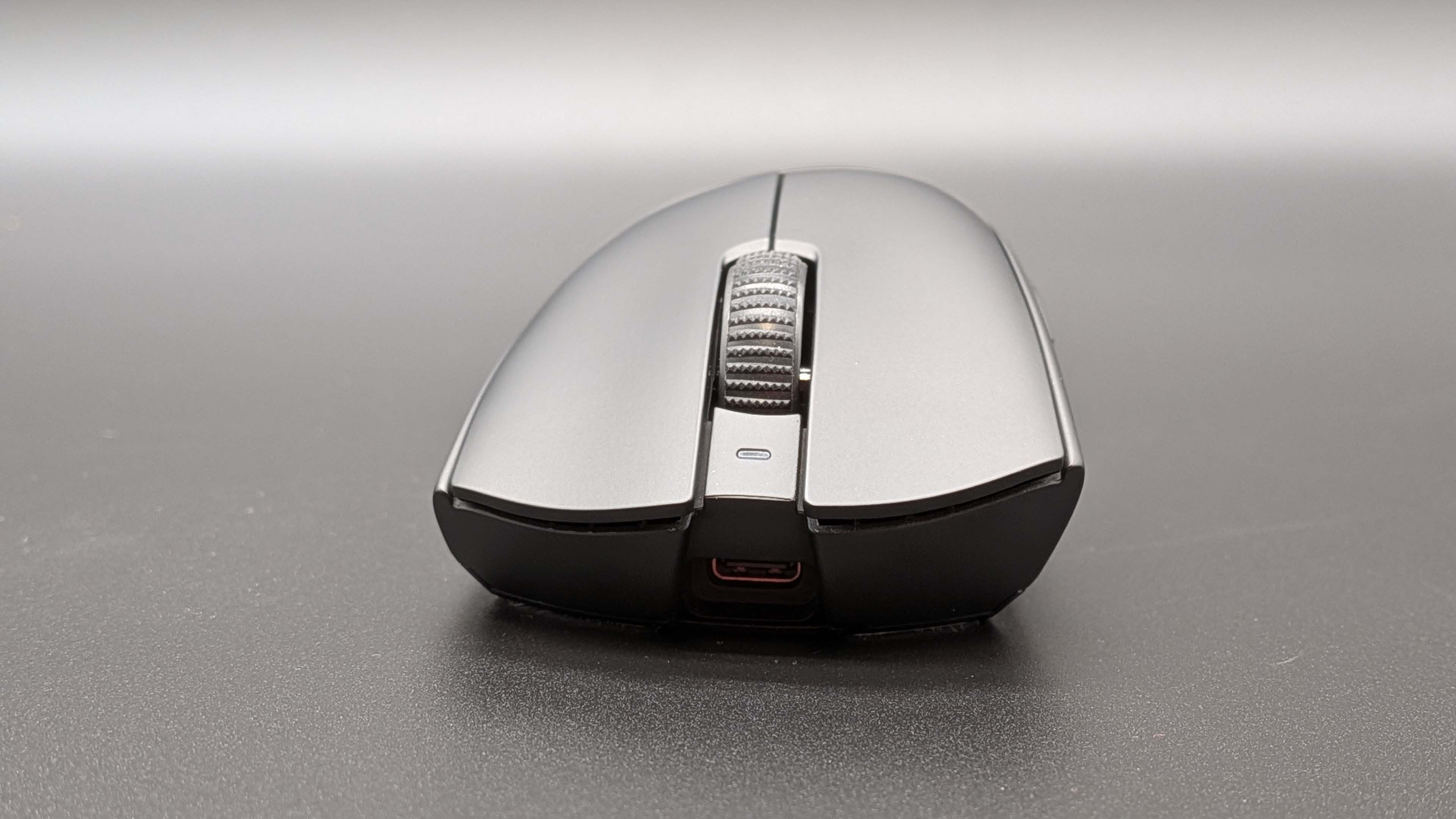
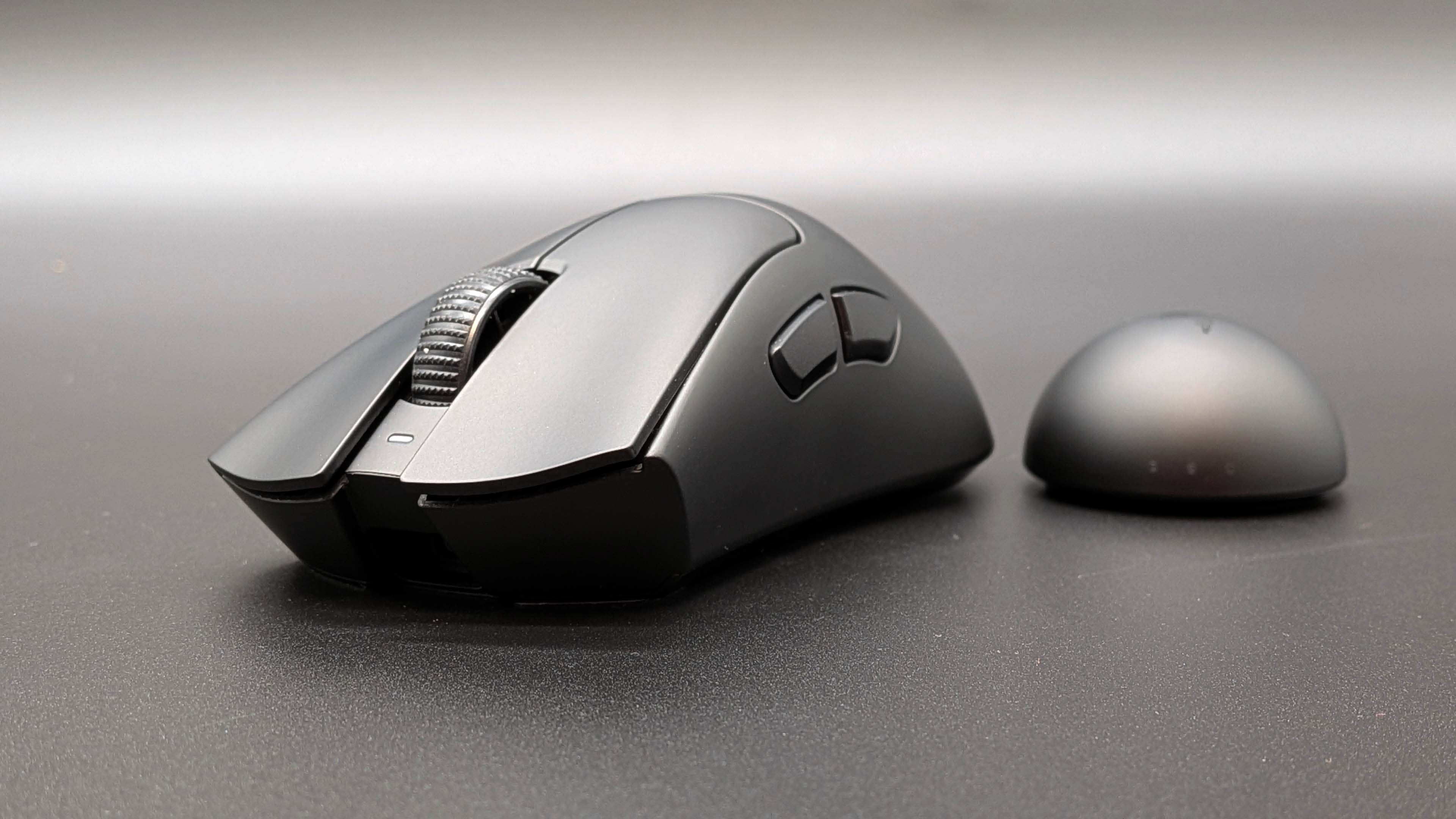
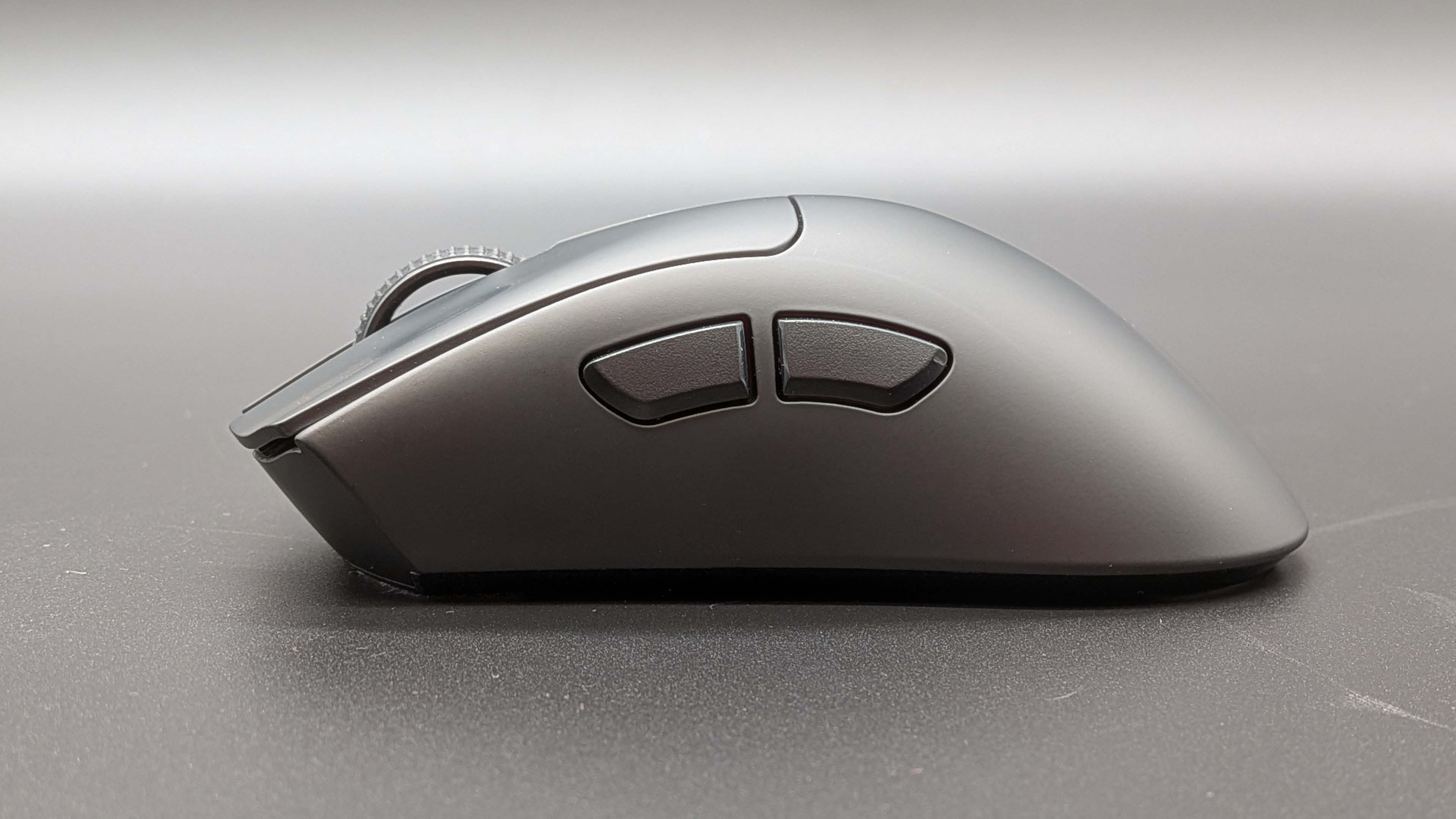
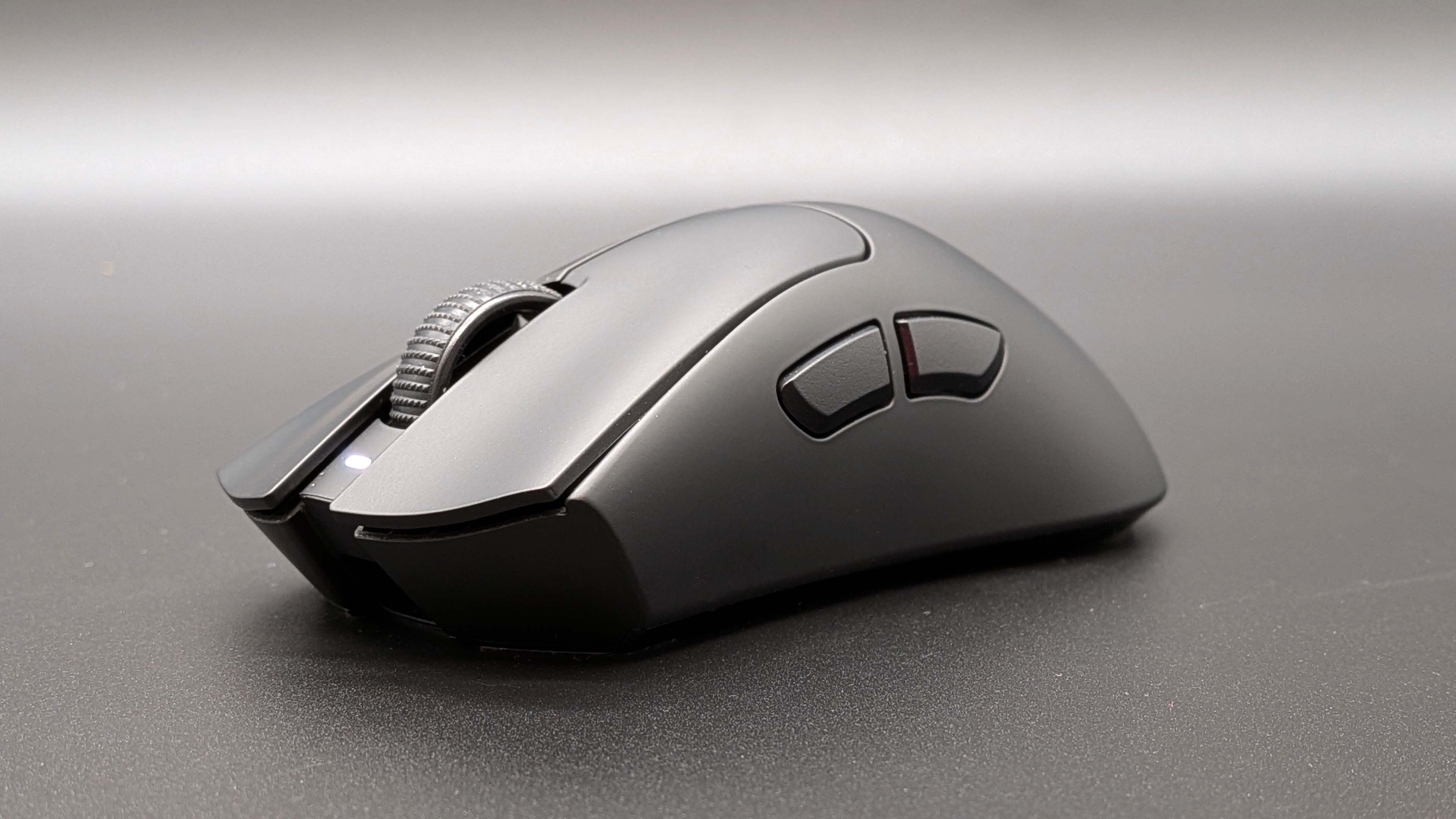
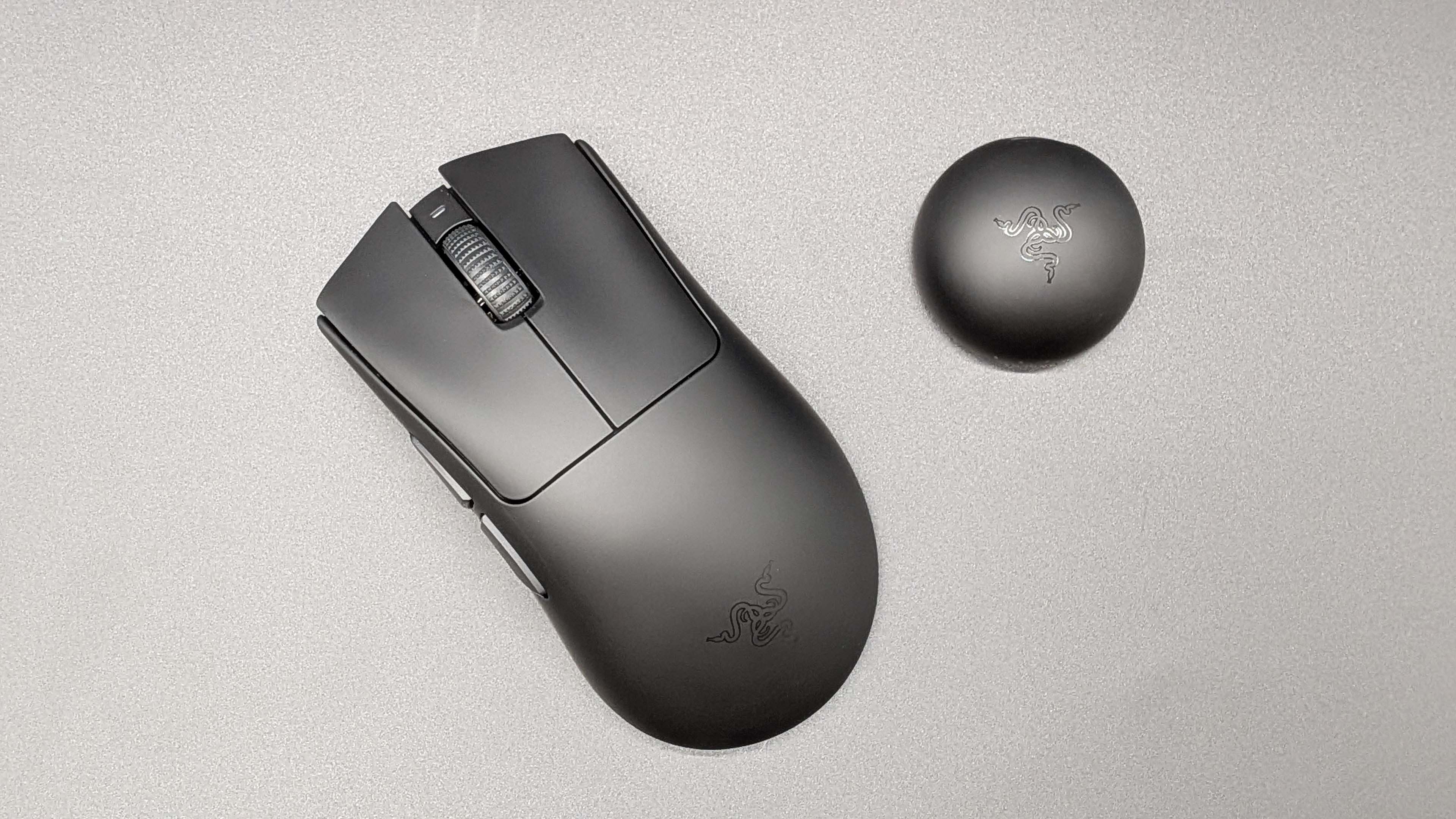
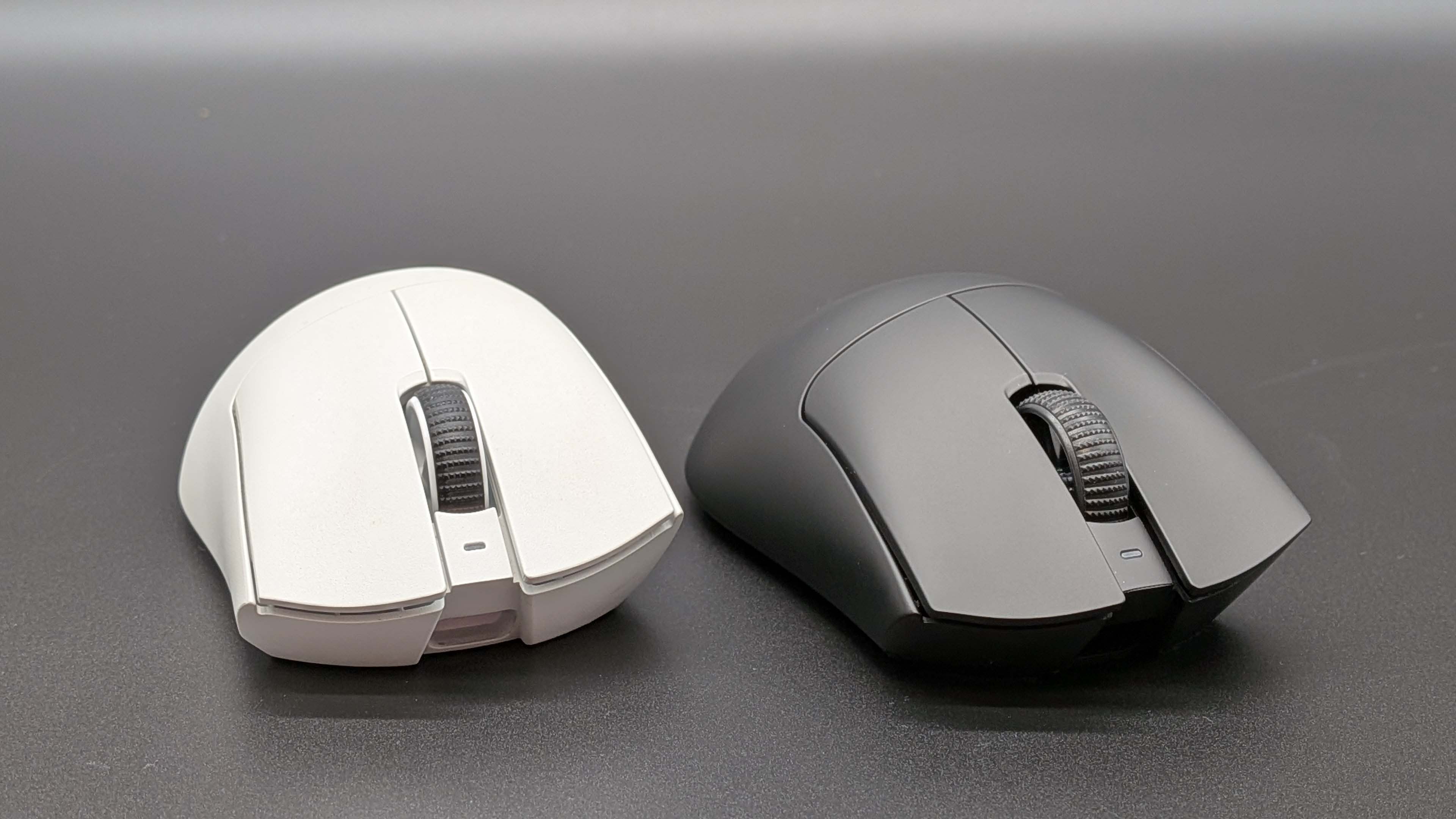
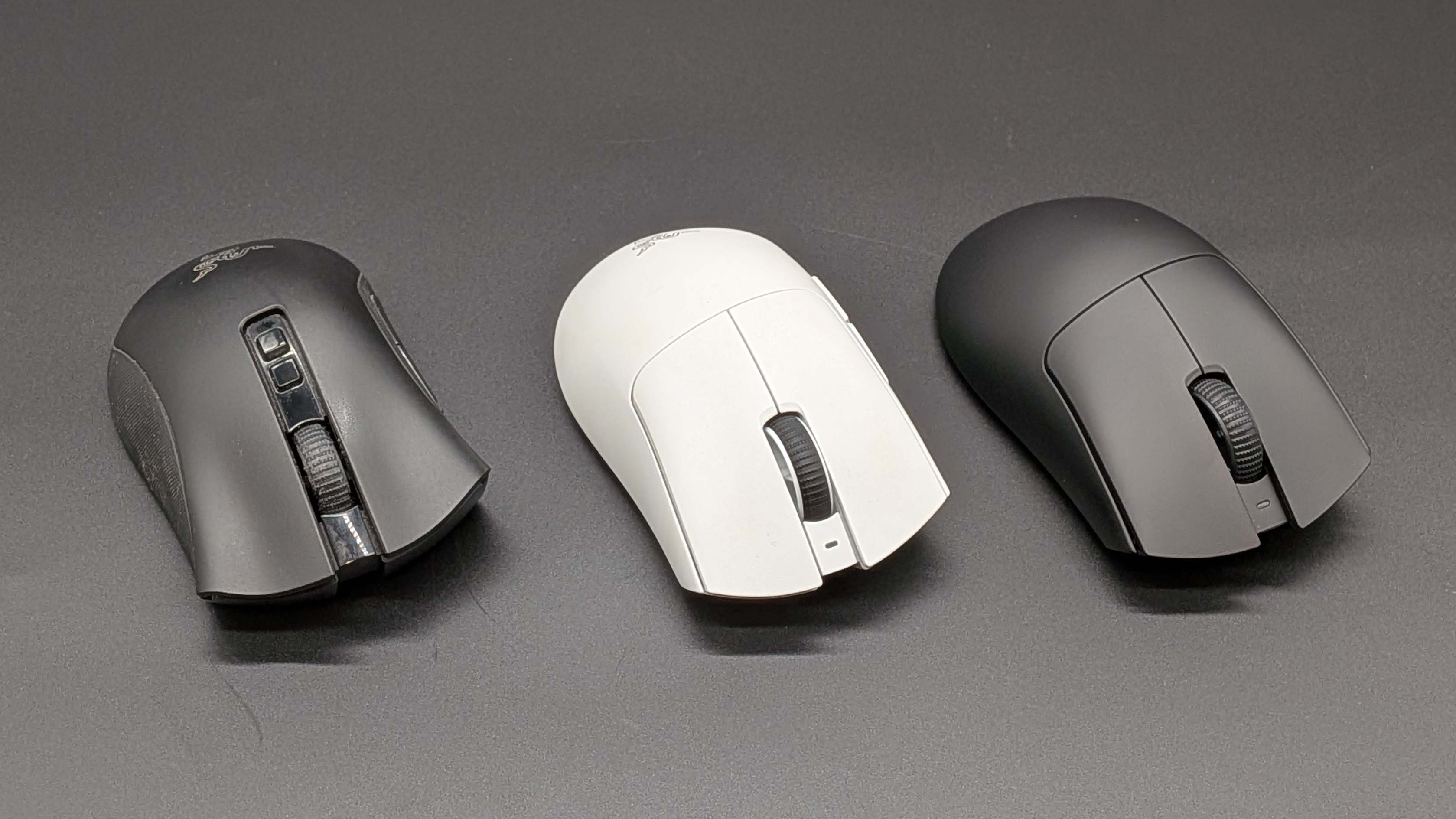
Specifications
Reasons to buy
Reasons to avoid
✅ You want the bleeding edge of gaming mouse tech: Everything about the DeathAdder V4 Pro is cutting edge, which probably goes some way towards explaining the price. It's the sharpest rodent in town, so if you must have the very best, here is where you want to be.
❌ You don't need all those pro qualifications: Should you simply want an affordable mouse that's very well-specced and great for gaming, rather than built (and priced) for the very best, there are other candidates below that may well suit your needs better than the DeathAdder.
The top spot in this guide used to belong to a DeathAdder. Then it was replaced by, err, a DeathAdder—the V3 HyperSpeed, to be precise. But now, say hello to our new best gaming mouse overall, the Razer DeathAdder V4 Pro.
Razer has been improving on the DeathAdder recipe for years, and this latest version is by far its best iteration yet. For a start, it's got a Focus Pro 45K Optical Gen-2 sensor, which is so fast and smooth under duress it puts all others in the shade.
Combine that with a teeny-tiny 56 g weight, and the DeathAdder V4 Pro is as fast as a very fast thing indeed. But thankfully, Razer hasn't skimped on the ergonomics either.
The outer coating is simply the smoothest, slickest thing we've ever had our hands on, even though it makes use of 90% "post-consumer recycled materials and bio-based polyamide fiber." I only know what half those words mean, but what I do know is the DeathAdder V4 Pro feels ultra-premium.
As it should, for the money. At $170/£170, it's far from the cheapest mouse on this list, and it's worth asking yourself if you need to spend this much on a gaming mouse when so many cheaper options do an admirable job for the cash.
Still, our best overall category is concerned with the tippity-top of performance balanced with price, and given what you're getting here, $170 isn't unreasonable. You even get a desk-based orb-shaped dongle for that HyperSpeed 8,000 Hz polling connection, which might be a bit of a pain for laptop users, but for desktop, it's truly a lovely thing.
Of course, if you whack the polling up to its full 8K, you're going to be substantially denting the battery life. The Razer is rated to a 150 hour maximum, but push it to its limits and you're going to get more like 22. Razer's software, however, has a Smart Polling Rate switcher for this mouse in particular, which automatically bumps up the polling speed for gaming, and drops it down when you're back on your desktop.
To be honest, the DeathAdder V4 Pro is so full of features, I'm starting to run out of room. It's got Dynamic Sensitivity, which is capable of changing your DPI on the fly based on the speed of your movements, a redesigned optical scroll wheel that's as smooth as you like and extremely accurate, and Gen-4 switches that are super clicky and positive to the touch. It's the whole kit and kaboodle, basically, with no stone left unturned on its spec sheet.
The Razer DeathAdder V4 Pro represents the absolute cutting edge of gaming mouse tech right now, all wrapped up in a refined package that really does make you feel like you've got your money's worth. It's not cheap, but its impeccable feature list and its unparalleled ergonomics means it's the best gaming mouse you can currently buy. And that's a fact.
Read our full Razer DeathAdder V4 Pro review.
The best budget wireless gaming mouse
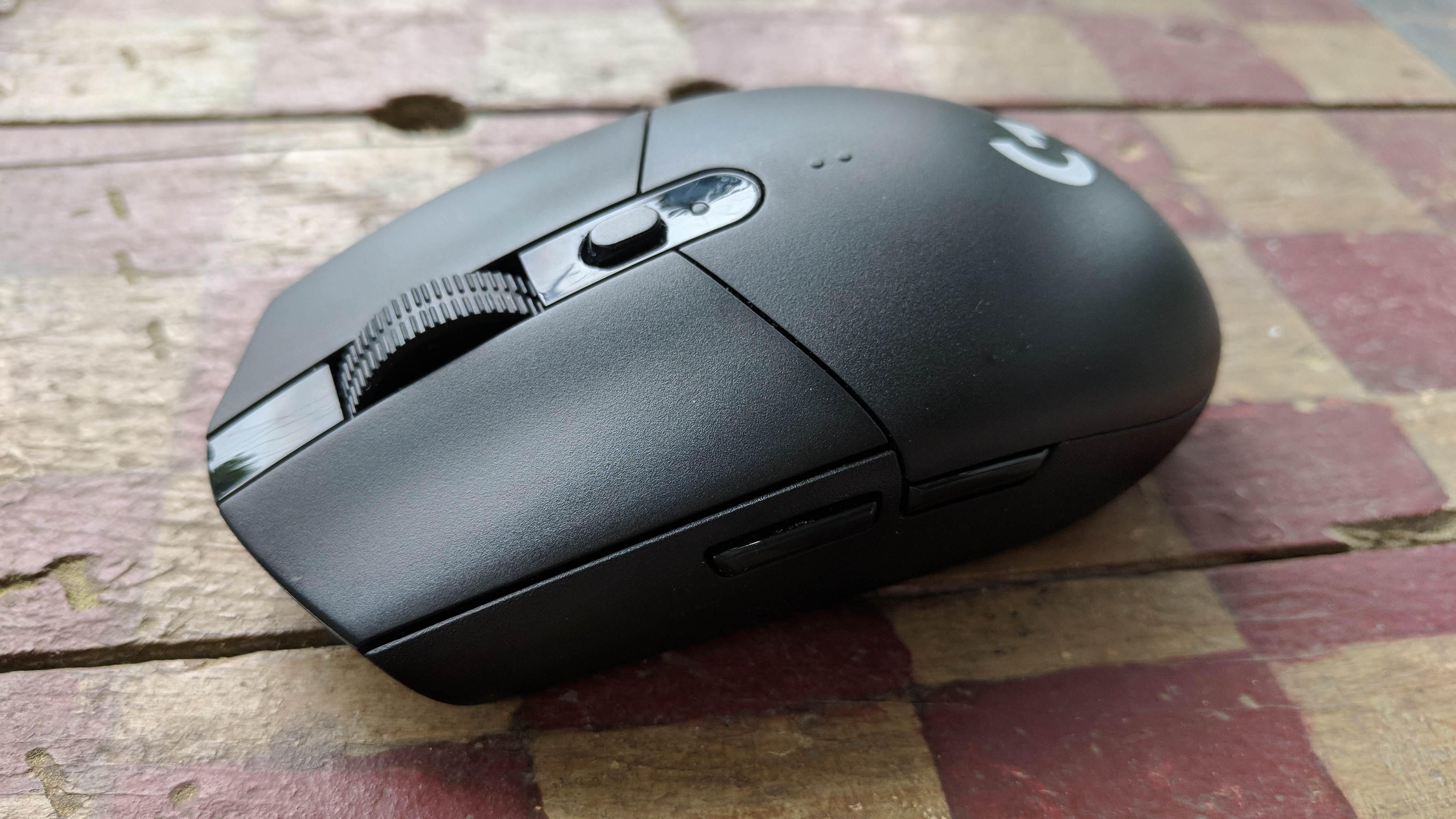
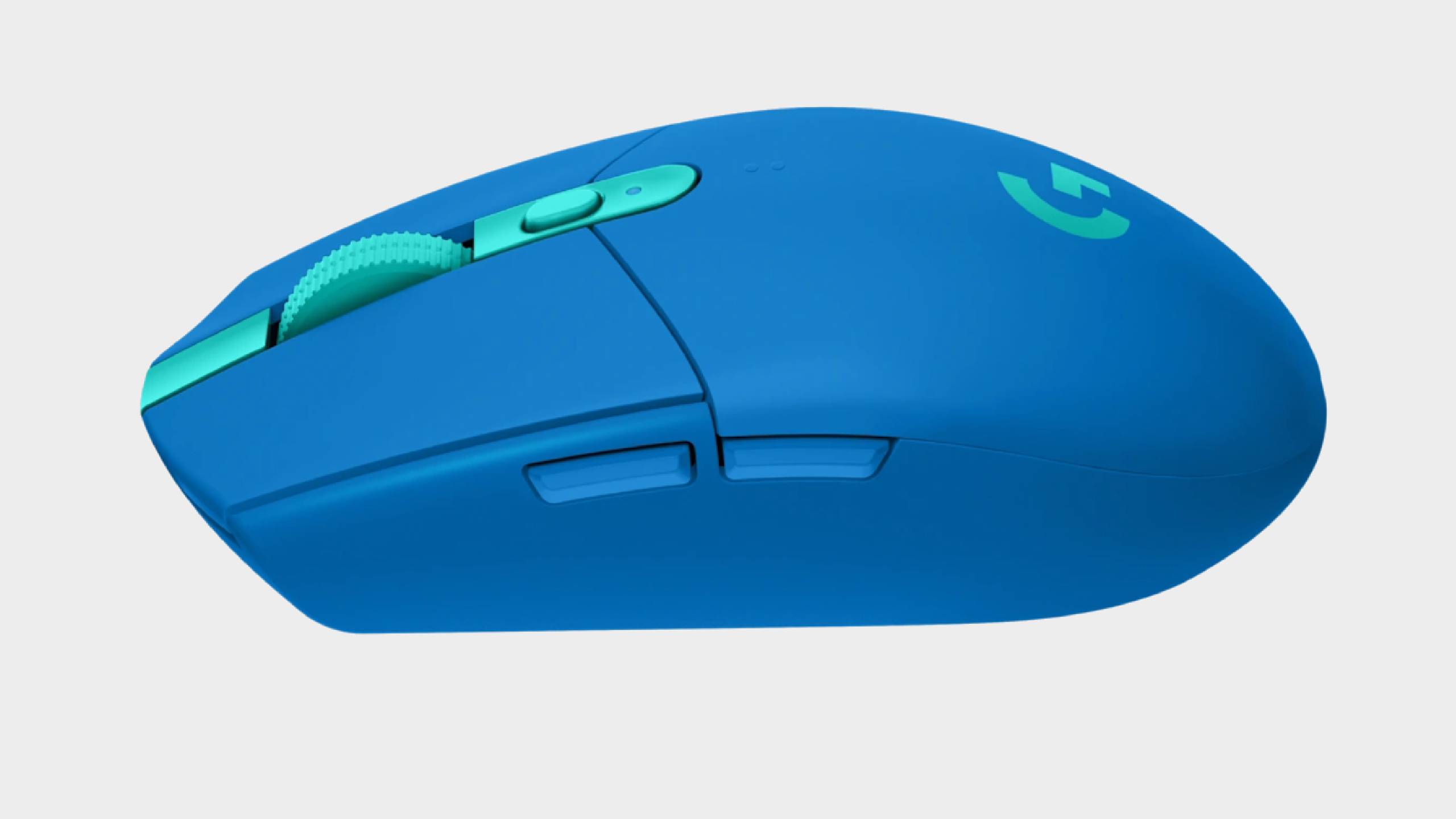
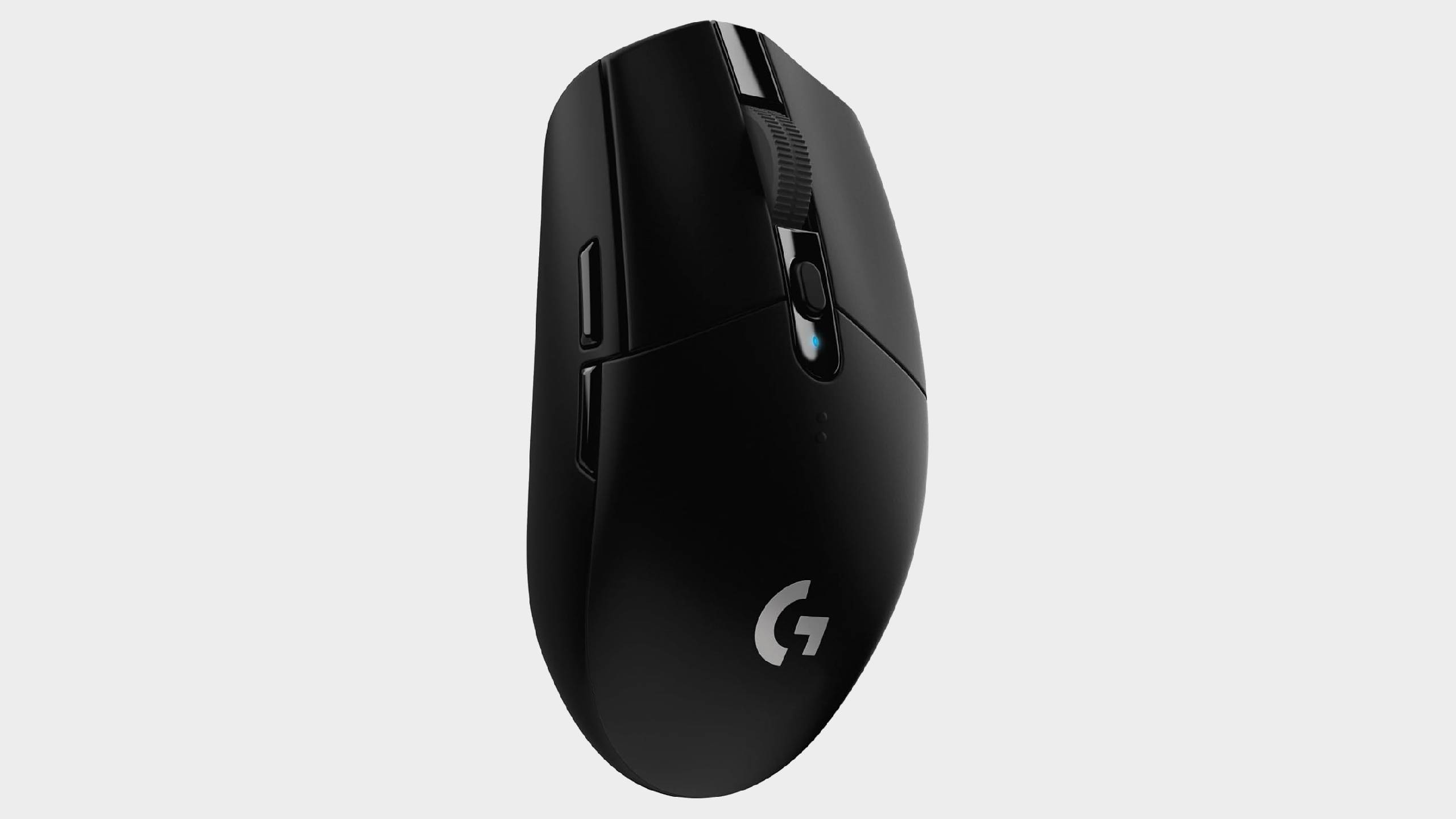
2. Logitech G305 Lightspeed
Our expert review:
Specifications
Reasons to buy
Reasons to avoid
✅ You want a wireless gaming mouse that's affordable but still brilliant: Logitech has done an excellent job at balancing price and features with the G305, and you might never want for anything better.
❌ You want something that feels really plush: The low price comes at a cost, and that's the feel of some of the materials. Still, it doesn't feel bargain basement, just not perhaps as lovely as some of the more premium offerings.
With the Logitech G305 Lightspeed, Logitech has created the best budget wireless gaming mouse: a high-performance peripheral that doesn't cost the earth. Its budget price has it competing against some of the better wired mice, but there's very little compromise in performance or design here to complain about, meaning you can ditch the cable for less.
The G305 uses Logitech's Hero sensor, an iteration of the fantastic sensor Logitech's best mice, from the classic G502 down to the G Pro X Superlight. It can last more than 200 hours on a single AA battery (which helps keep the cost down vs. being rechargeable). And that's when it's in its high-performance, 1,000 Hz polling mode, by the way.
Still, it's perhaps arguably a little old-school in the face of most wireless gaming mice these days, which make use of an internal rechargeable lithium battery. That's the only real downside here, though, so we can forgive it this small transgression.
The tiny wireless dongle can be stored inside the body of the mouse, but critically, the left- and right-click buttons are separate pieces from the removable palm rest, ensuring a reliable and satisfying click.
The shape of the G305 is based on a small, ambidextrous design that Logitech has been using for years. While components like the scroll wheel and buttons don't feel as premium as those in the G502, they're still far better than anything you'll find in a cheap gaming mouse.
Ultimately, the quality and performance of the G305 are the main killer features for its price, and really, they're the main things you should be looking for in any gaming mouse, wireless, budget, or otherwise. The G305 has been around for a while now, but at this rate, it looks like it'll stick on this list for a while to come. It's practically a classic, but it still feels like it's got the goods in 2025.
The best lightweight wireless gaming mouse
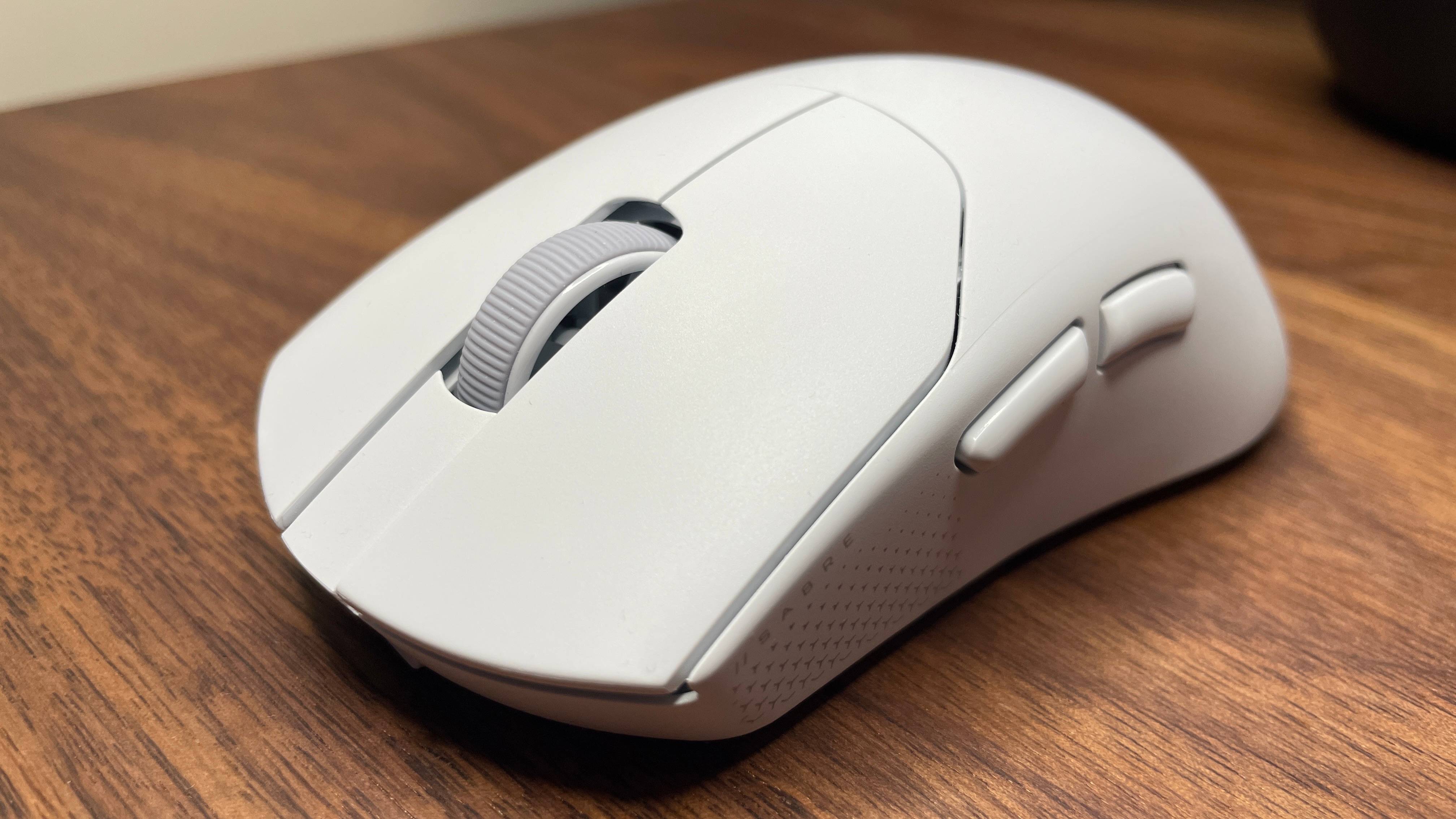
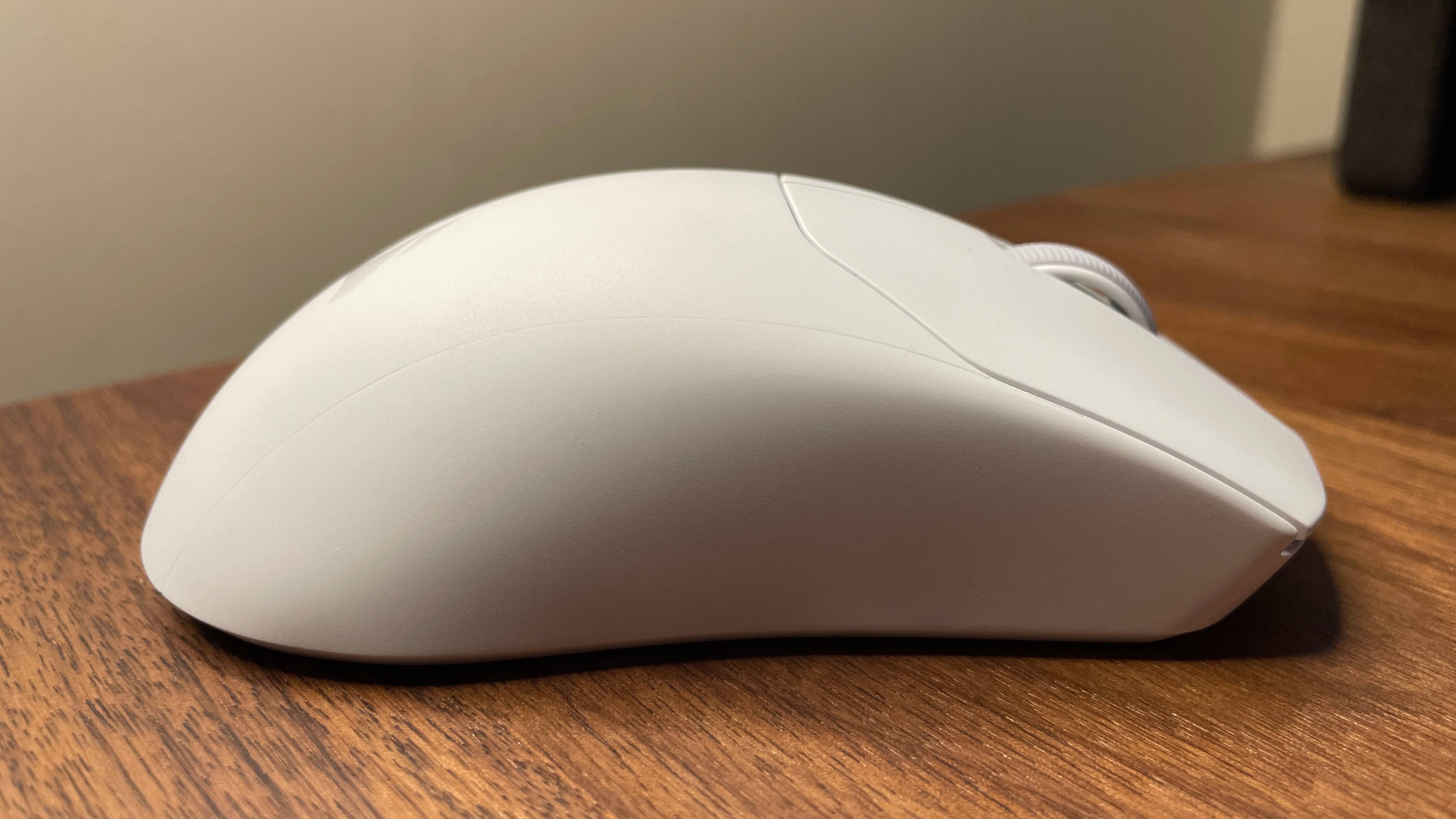
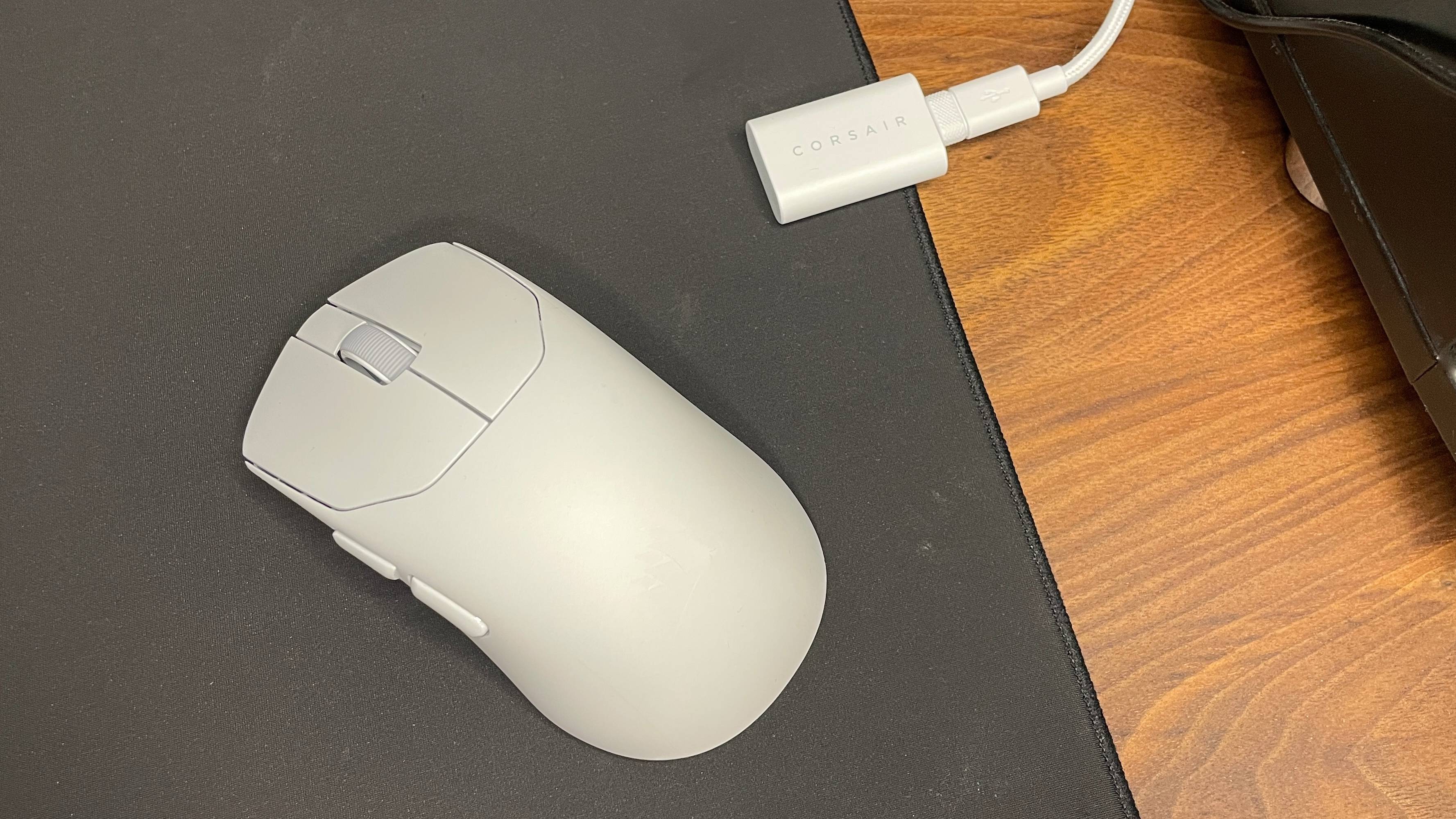
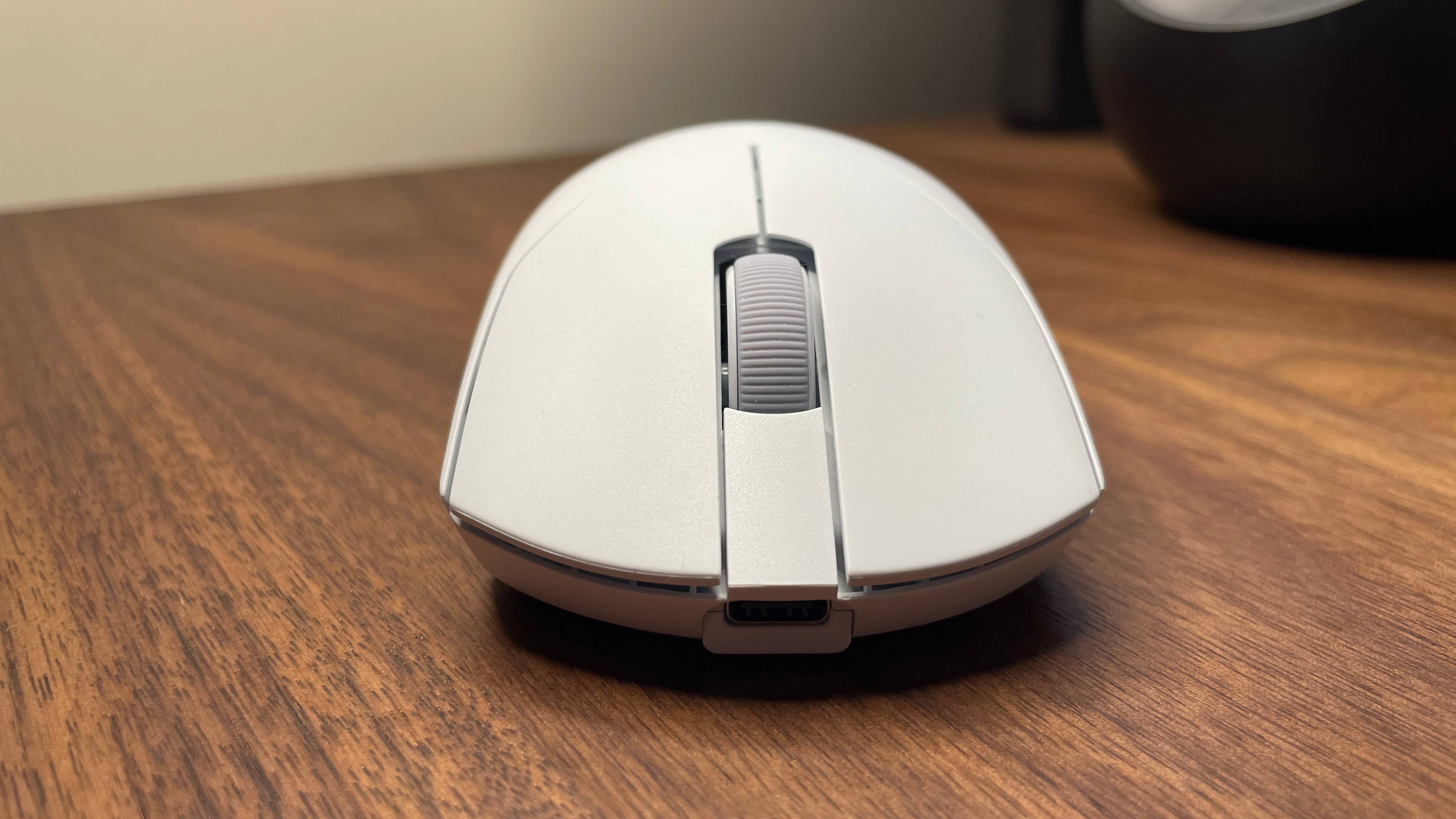
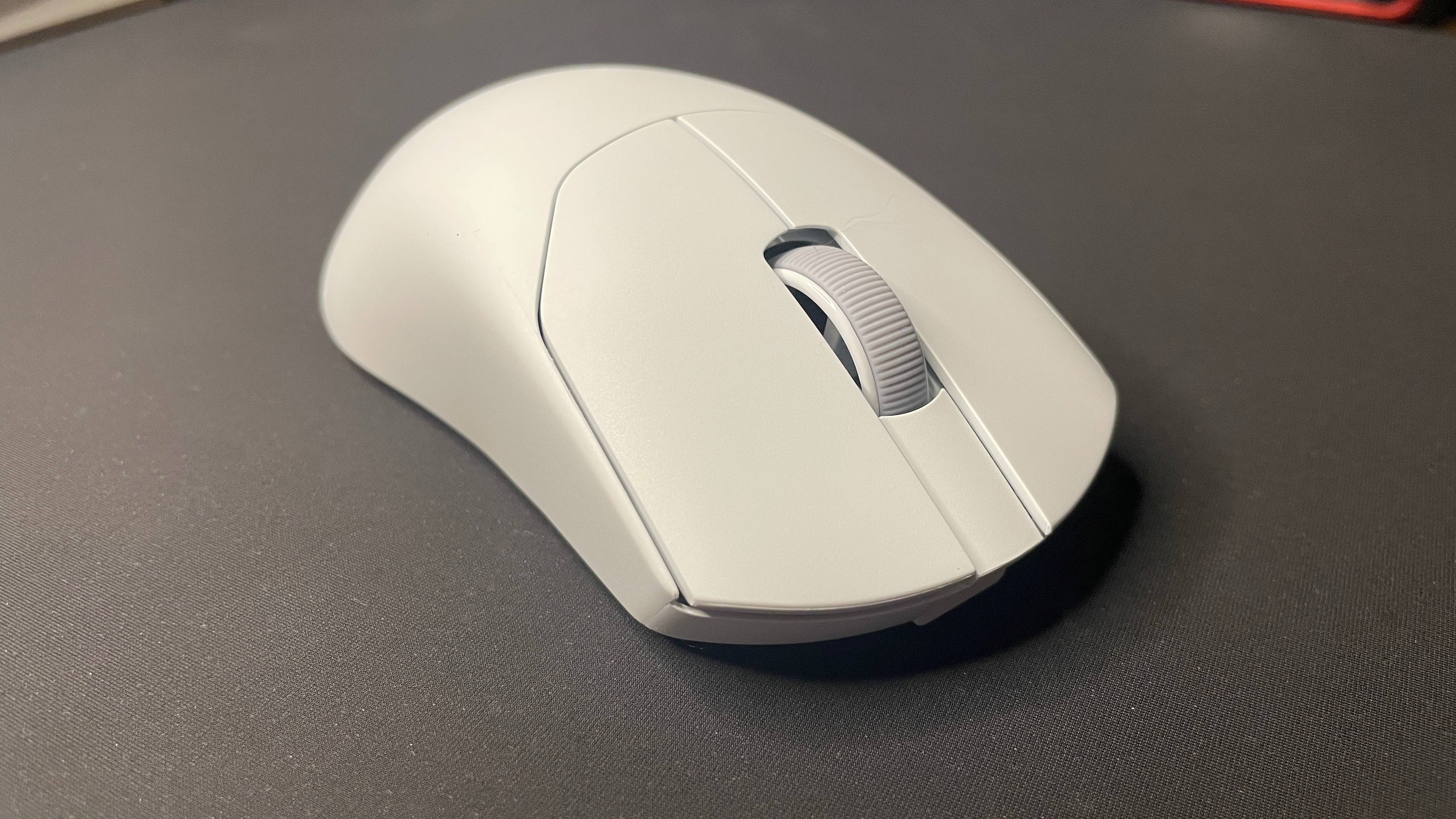
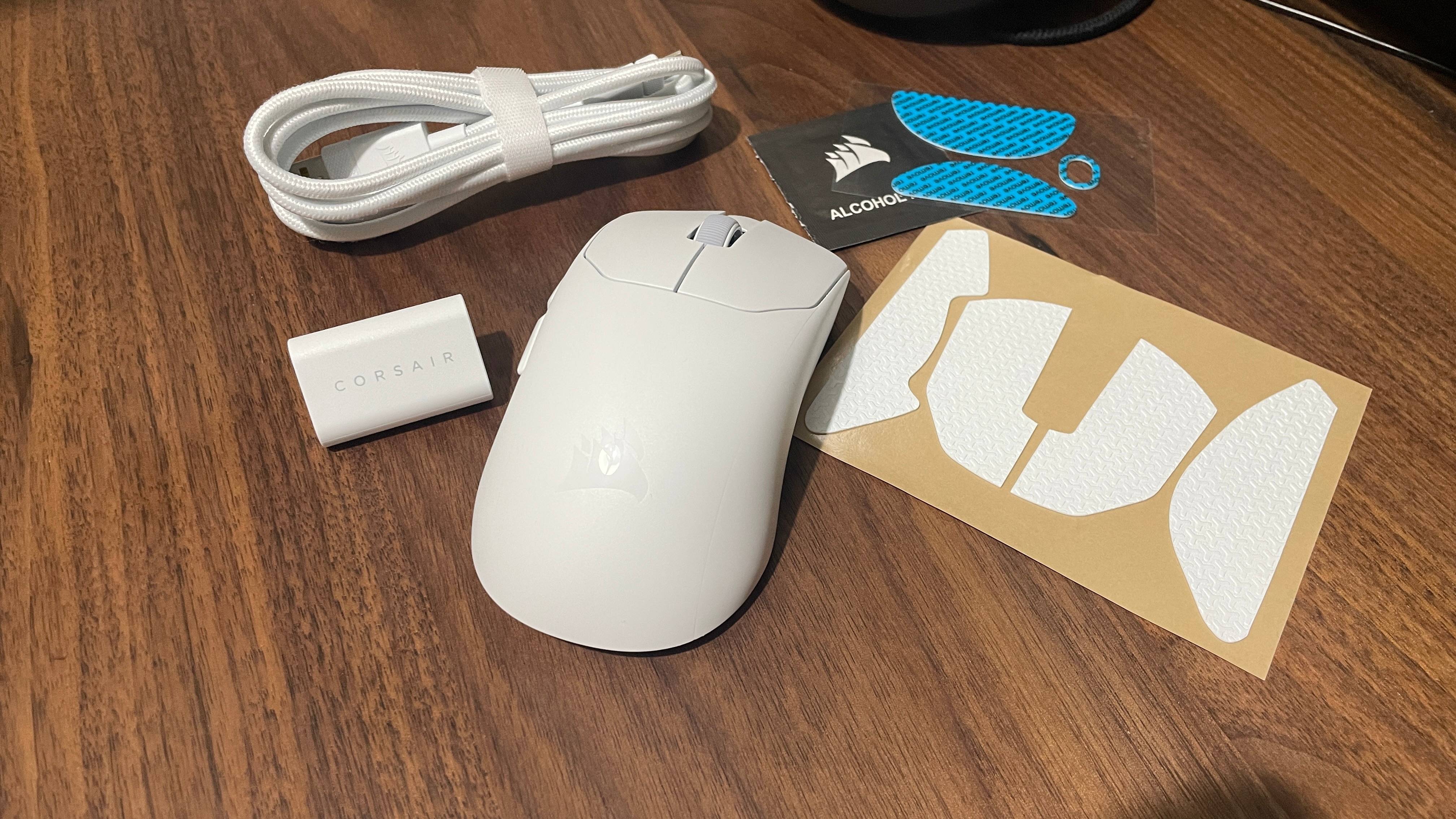
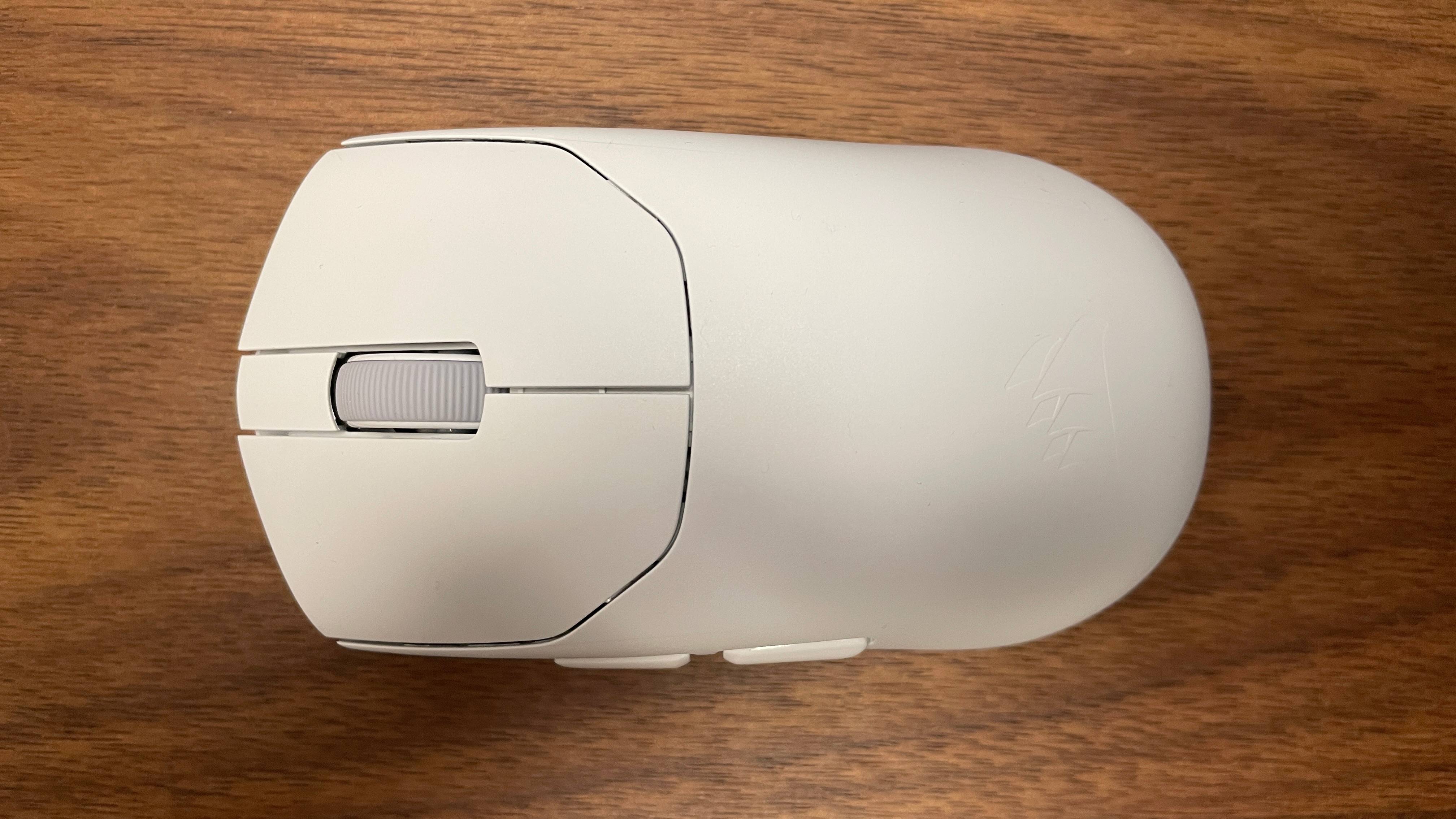
Specifications
Reasons to buy
Reasons to avoid
✅ You care about aim the most: If you want to eliminate every impediment possible from lining up that headshot, the light weight of this mouse should help.
❌ You want tons of battery life: While 70 hours is fine, it's not quite what you can get in some other (but heavier) gaming mice.
The Corsair Sabre V2 Pro Ultralight Wireless is the best lightweight gaming mouse, and that's because not only is it incredibly light but it's also surprisingly sturdy. 'Ultralight' gaming mice have been getting even more, well, light over the last couple of years, and Corsair really seems to be taking that to its limits here.
Weighing just 36 g, the Sabre V2 Pro is 11 g lighter than our previous pick for the ultralight crown, the Turtle Beach Burst II Air, and it's way lighter than most other mice on the market. Even the (fantastic) Logitech G Pro X Superlight and Superlight 2 are over 20 g heavier.
We're not quite sure what sorcery has gone on behind the scenes, but there must have been some spells cast to get the Corsair mouse so light without poking it full of little holes. That's been the MO for a lot of mice: empty out the shell with dozens of holes to get that light weight. Not here: this mouse is full-bodied and feels plenty sturdy.
After your hand and brain get used to the seriously light weight, it doesn't feel too strange and you really start to notice the benefits in FPS games. Having to contend against just 36 g of tech under your fingertips to move your crosshair makes for quicker and easier headshots. The sensor and wireless connection is pretty stellar here, too, which is kind of a prerequisite for competitive FPS games.
Make no mistake, that is the target market here: gamers who are into competitive shooters. And such gamers tend to care little for extra bells and whistles. So Corsair hasn't given the Sabre V2 Pro any. It's just a solid lightweight mouse—no RGB, no extra buttons other than LMB/RMB/middle/forward/back, and not even an installable app for configuration.
There is an app, mind, it's just web-based, which is great because it means you don't have to bloat your PC or keep anything running in the background. Just set your DPI and polling rate (up to 33,000 DPI and 8,000 Hz, respectively), hit save, and you're good to go. It offers a little more than that, but it's really very minimal—just how it should be for a competitive gaming mouse.
Apart from having no dedicated DPI button (you use a button combo to cycle) and only being able to save one profile to the mouse, the only real downside—at least, for most who will probably prefer PTFE feet—is that it comes with UPE skates. These are more durable but they're a little less glide-y, but it's not the biggest difference imaginable.
Slapping on some third-party PTFE skates, if and when they're available, might be a good shout. But even without that, the Corsair Sabre V2 Pro is far and away the best lightweight wireless gaming mouse on the market right now.
Read our full Corsair Sabre V2 Pro review.
The best MMO wireless gaming mouse
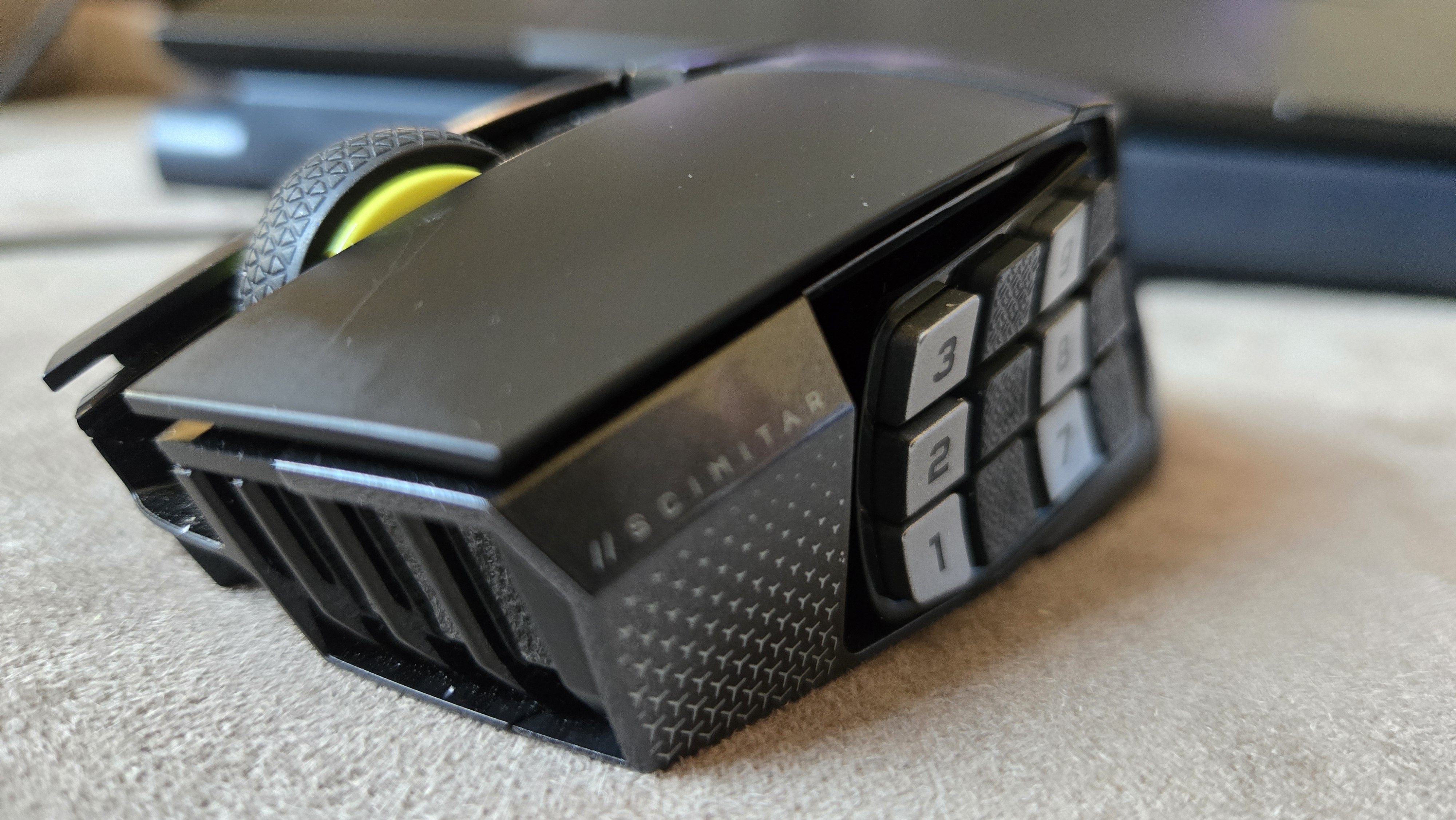
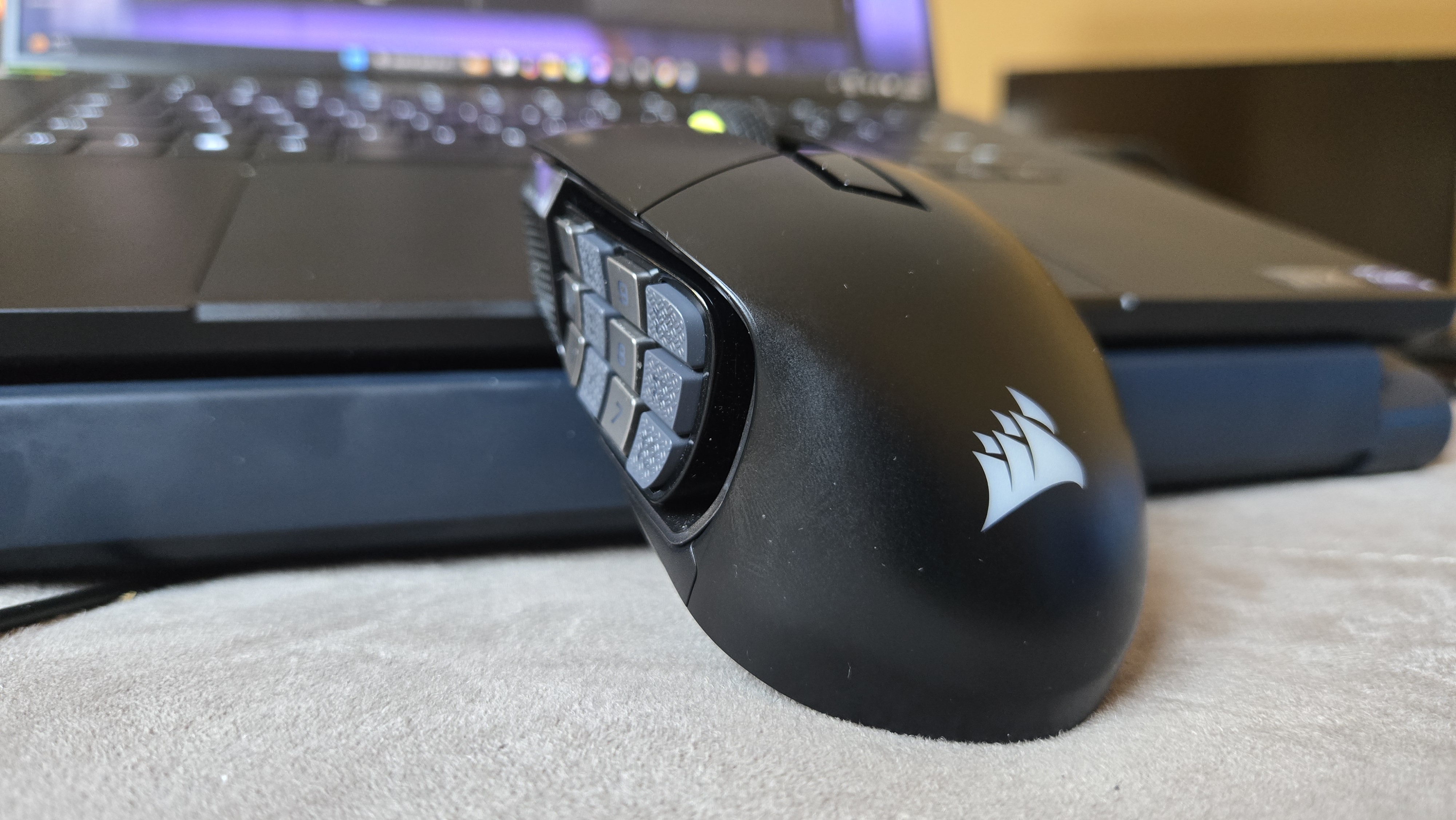
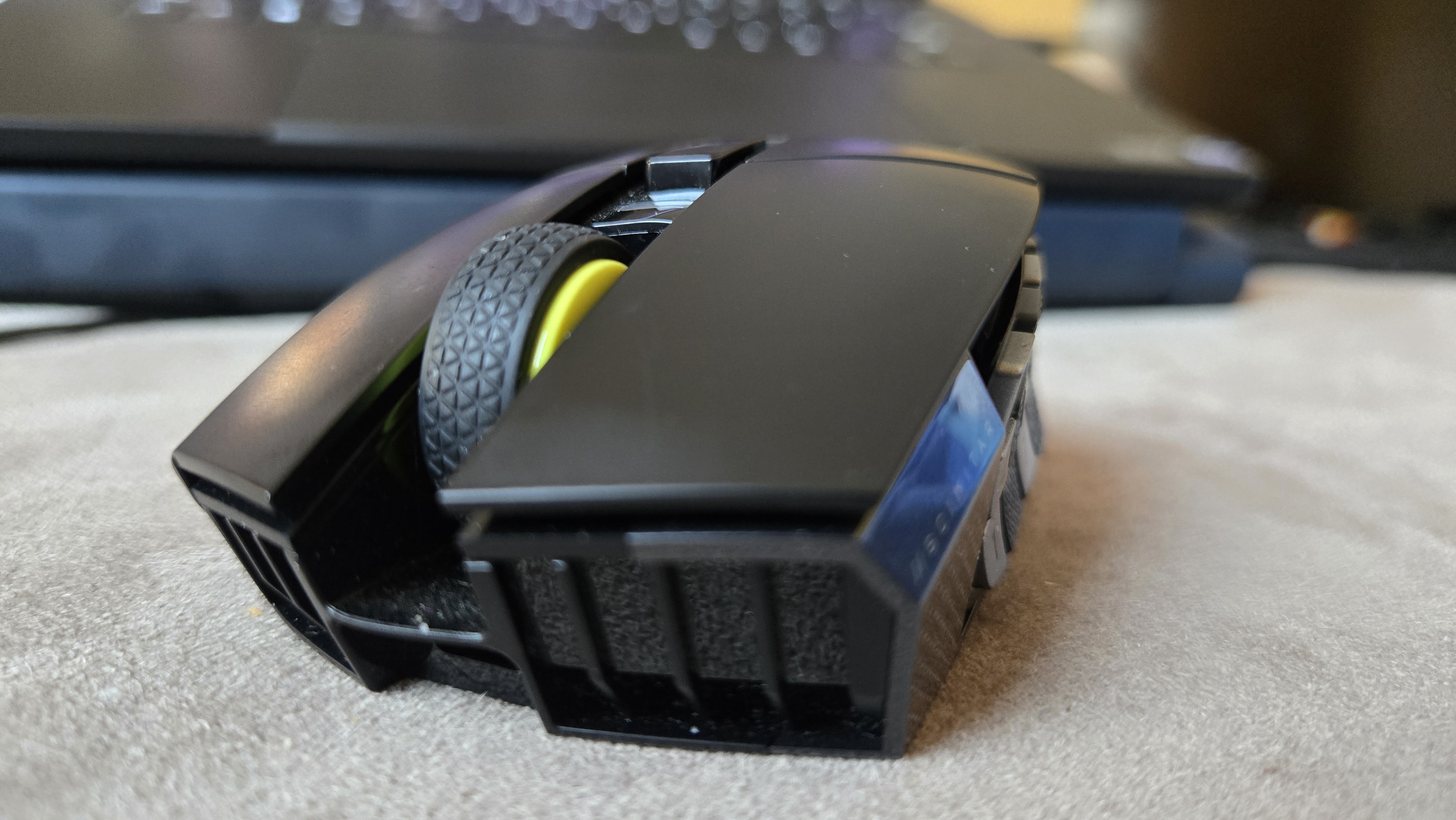
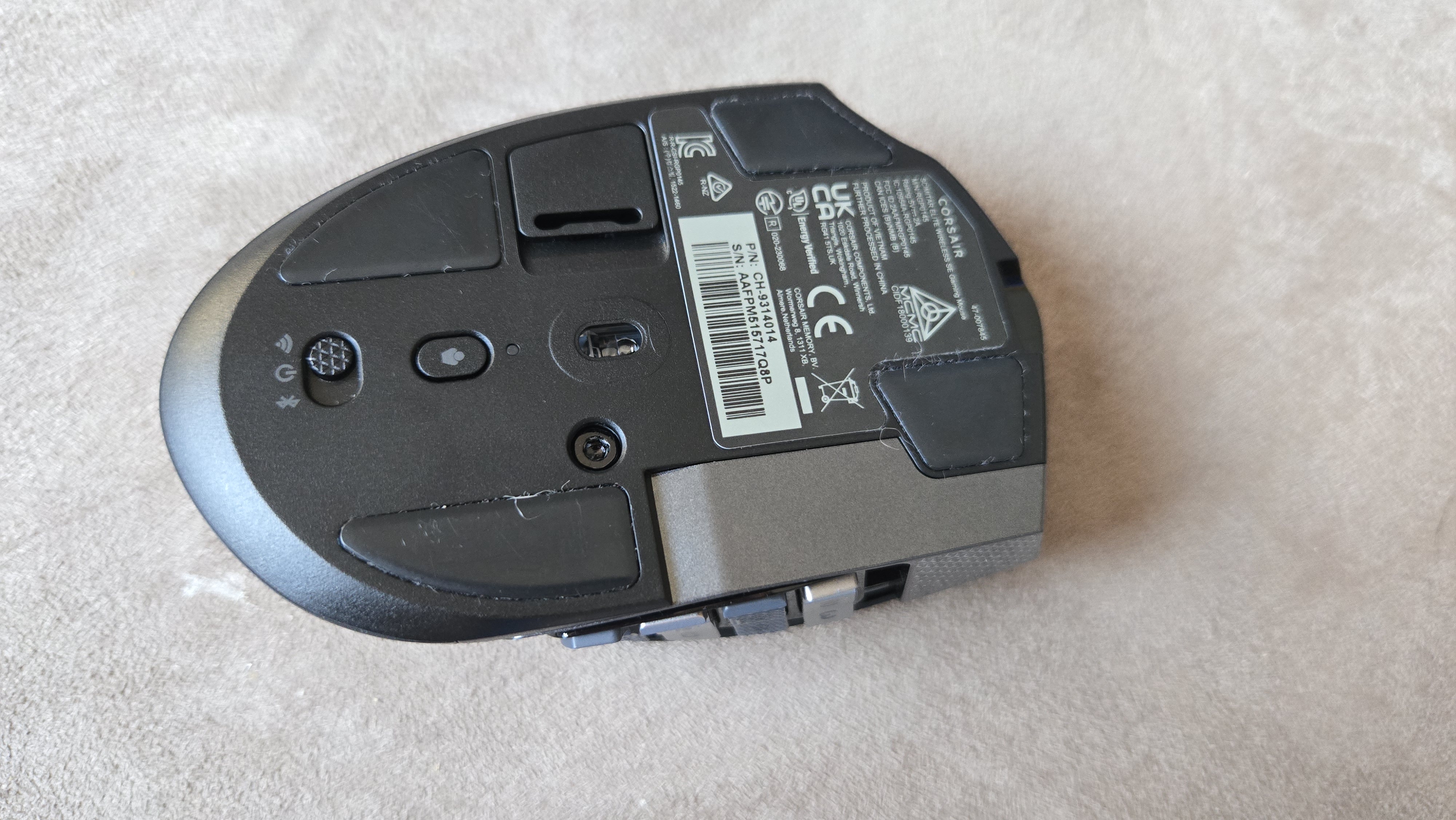
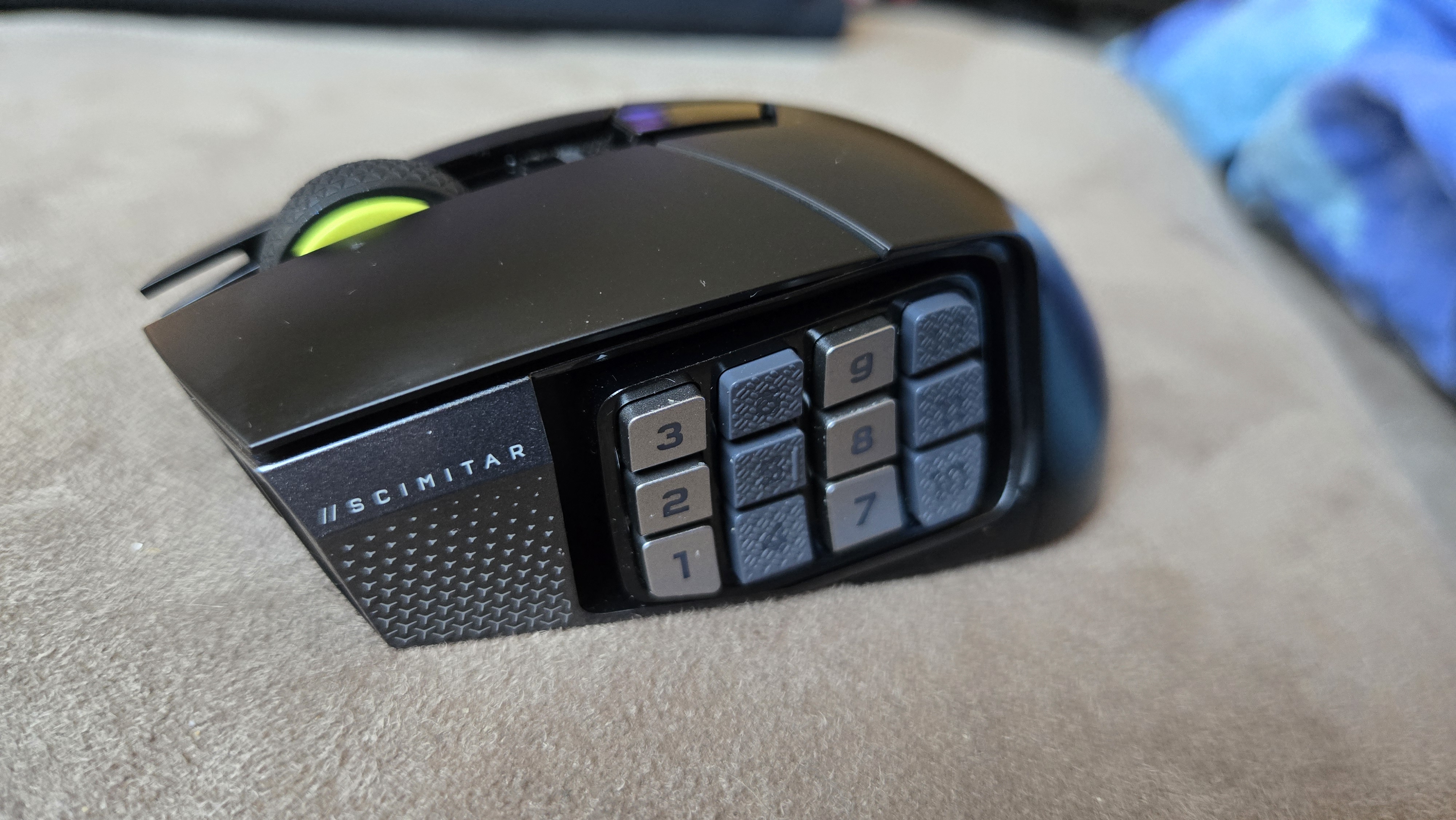
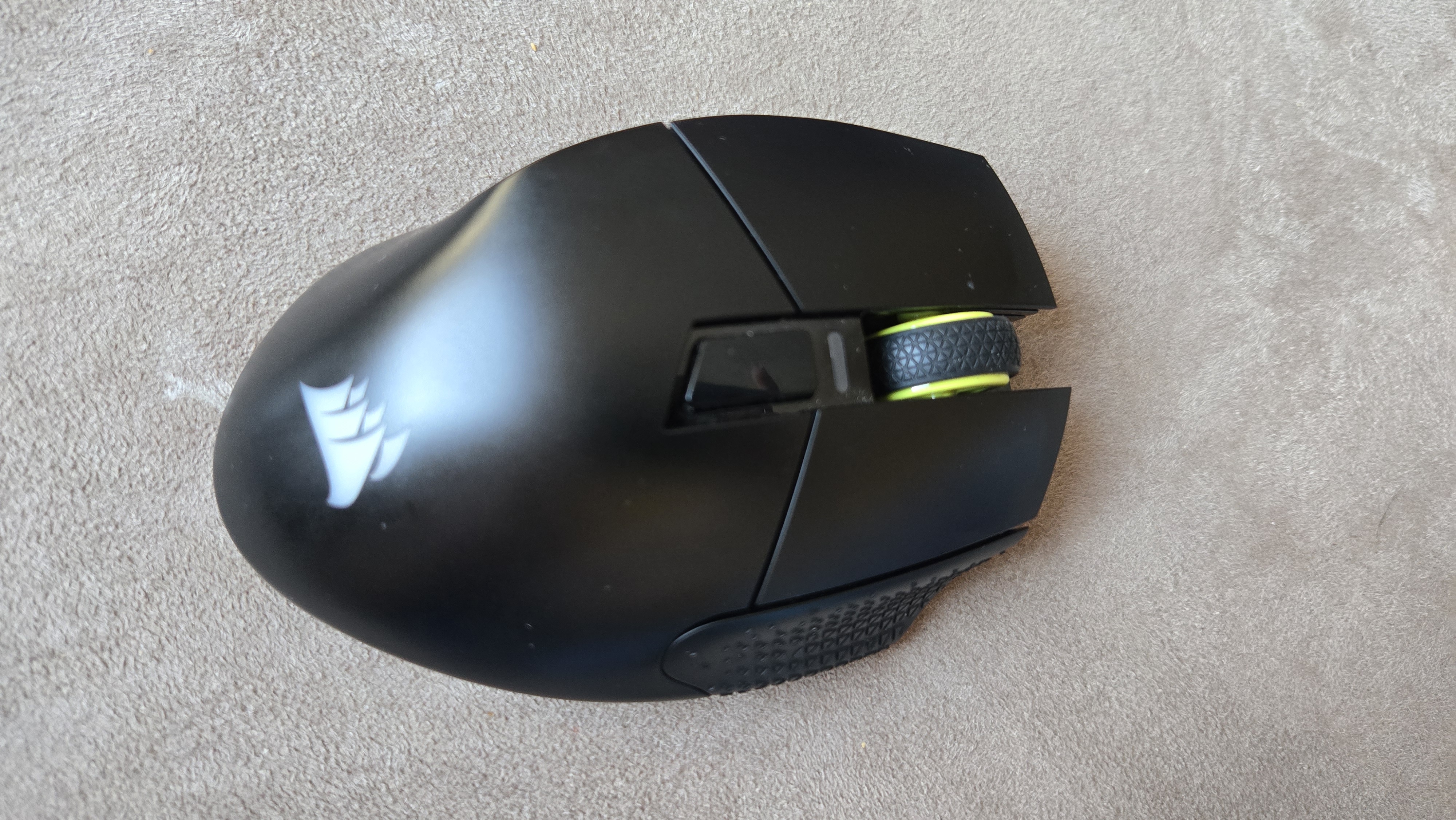
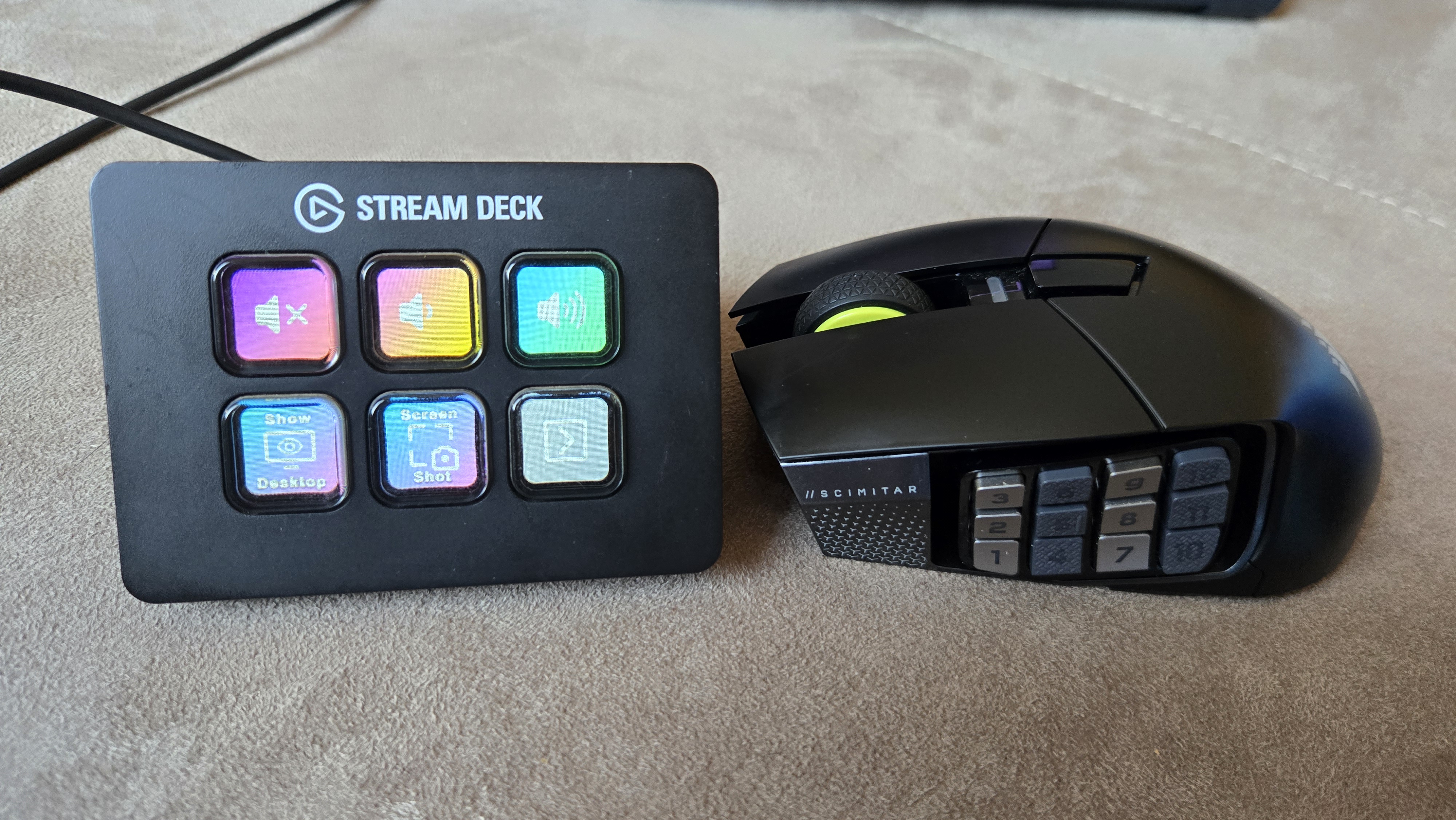
Specifications
Reasons to buy
Reasons to avoid
✅ You need more buttons: If you find that you're contorting your fingers to reach some hotkeys, this mouse has a solution.
❌ You want a lightweight mouse: At 161 g, this mouse certainly isn't light. That shouldn't be a problem for MMO gamers and general use, but won't be ideal for competitive shooters.
The best wireless gaming mouse for MMMOs and MOBAs is the Corsair Scimitar Elite Wireless SE. MMO mice have been around for a while now, but few have offered just as much, in just the right way, as this one.
If you're after a lightweight and barebones mouse for clicking heads, this probably isn't the one for you, but if you find yourself having to reach across your keyboard to hit a keybind, an MMO mouse like this is ideal. That's because it shoves a whole bunch of bindable buttons on the side of your mouse where your thumb sits—12 buttons, to be precise.
One problem with some MMO mice is that it can be difficult for your thumb to figure out which button is which, as they're all smushed together. With this one, though, the button rows alternate textures to help you differentiate between them, and they're spaced apart nicely. You can also move the entire button panel around and fix it in place to get it in the perfect spot for your thumb.
This isn't just useful for gaming, either, but also for some productivity apps that benefit from keybinds, and even streaming. On the latter point, streamers will be happy to know the Scimitar Elite Wireless SE comes with Stream Deck integration. This means you can not only set up the side buttons to trigger standard keyboard functions, media controls, and other macros, but also Stream Deck functions such as swapping between scenes in OBS.
There are, of course, a couple of sacrifices for all this customisability and functionality, but these aren't too big of a deal—at least, not for MMO gamers and the likes. For one, it weighs 161 g which is a far cry from some of the lightest gaming mice on the market such as the 36 g Corsair Sabre V2 Pro. And it also only caps out at 1,000 Hz polling with a 33,000 DPI sensor.
These aren't bad polling and sensor stats, especially for an MMO mouse, they're just not the latest and greatest for gaming in competitive shooters and similar genres. But that's not the target market here. The target is button-happy MMO/MOBA gamers and productivity users, and for those use cases the Corsair Scimitar Elite Wireless SE reigns king.
Read our full Corsair Scimitar Elite Wireless SE review.
Best wireless ambidextrous gaming mouse
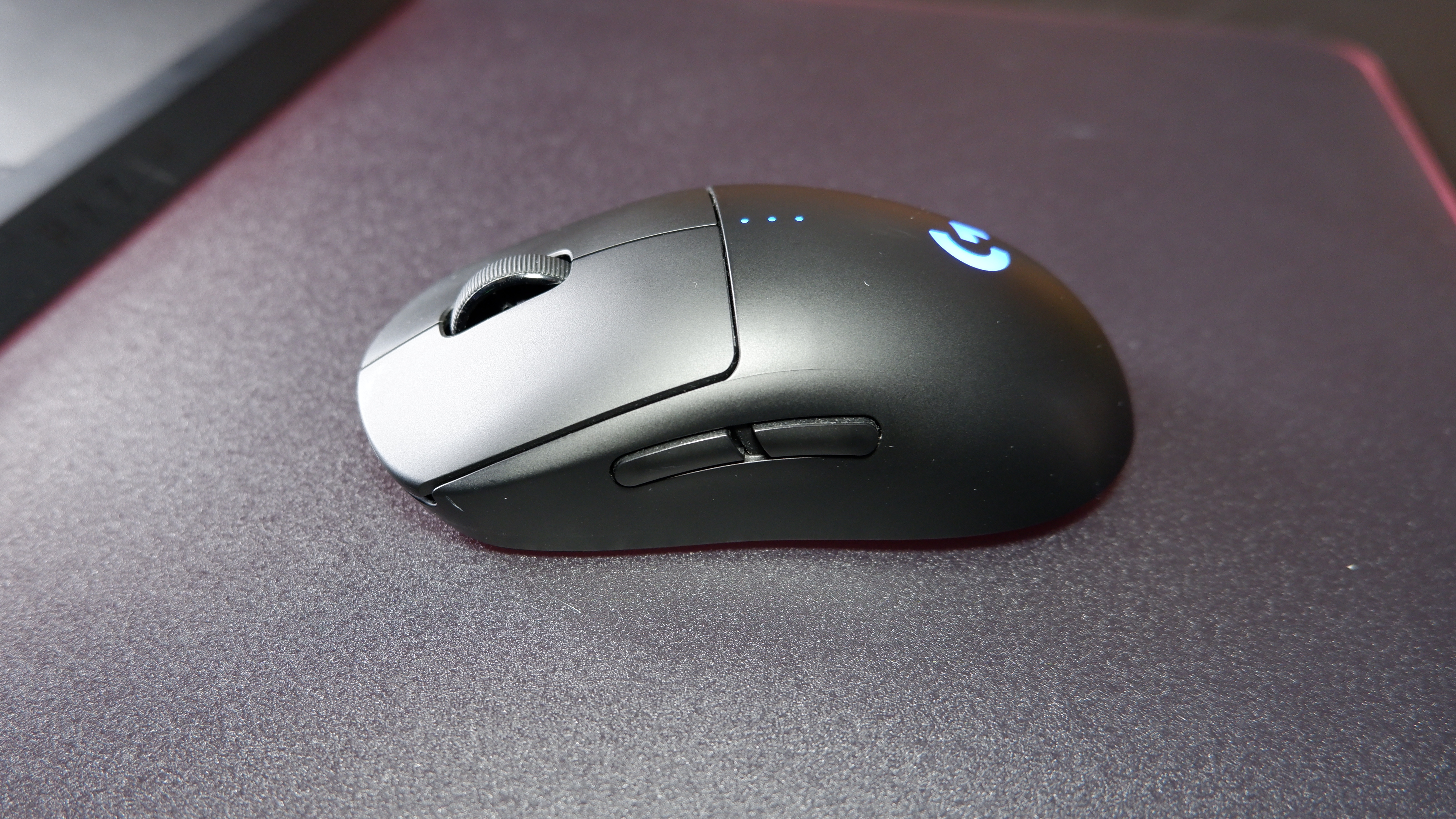
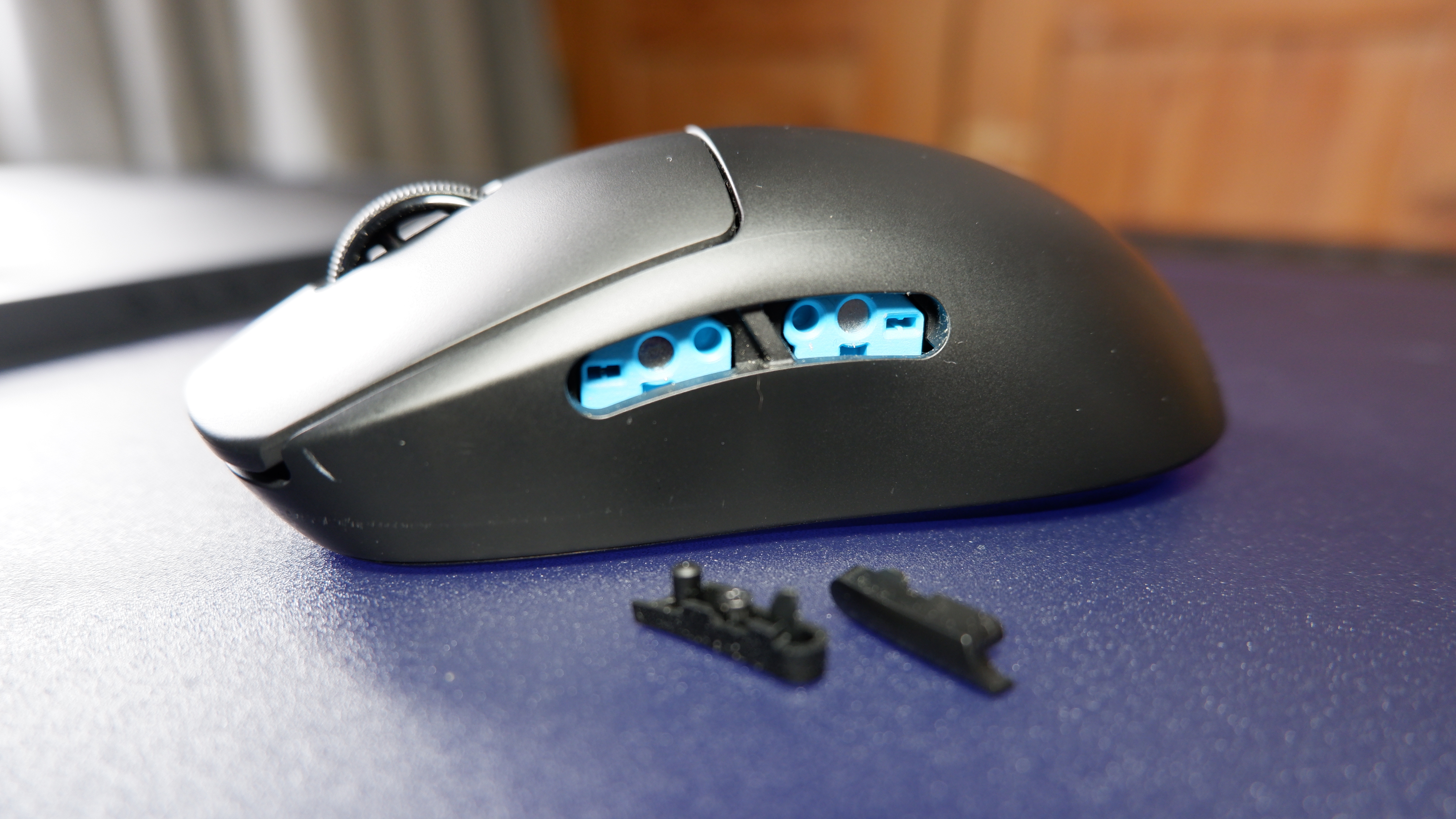
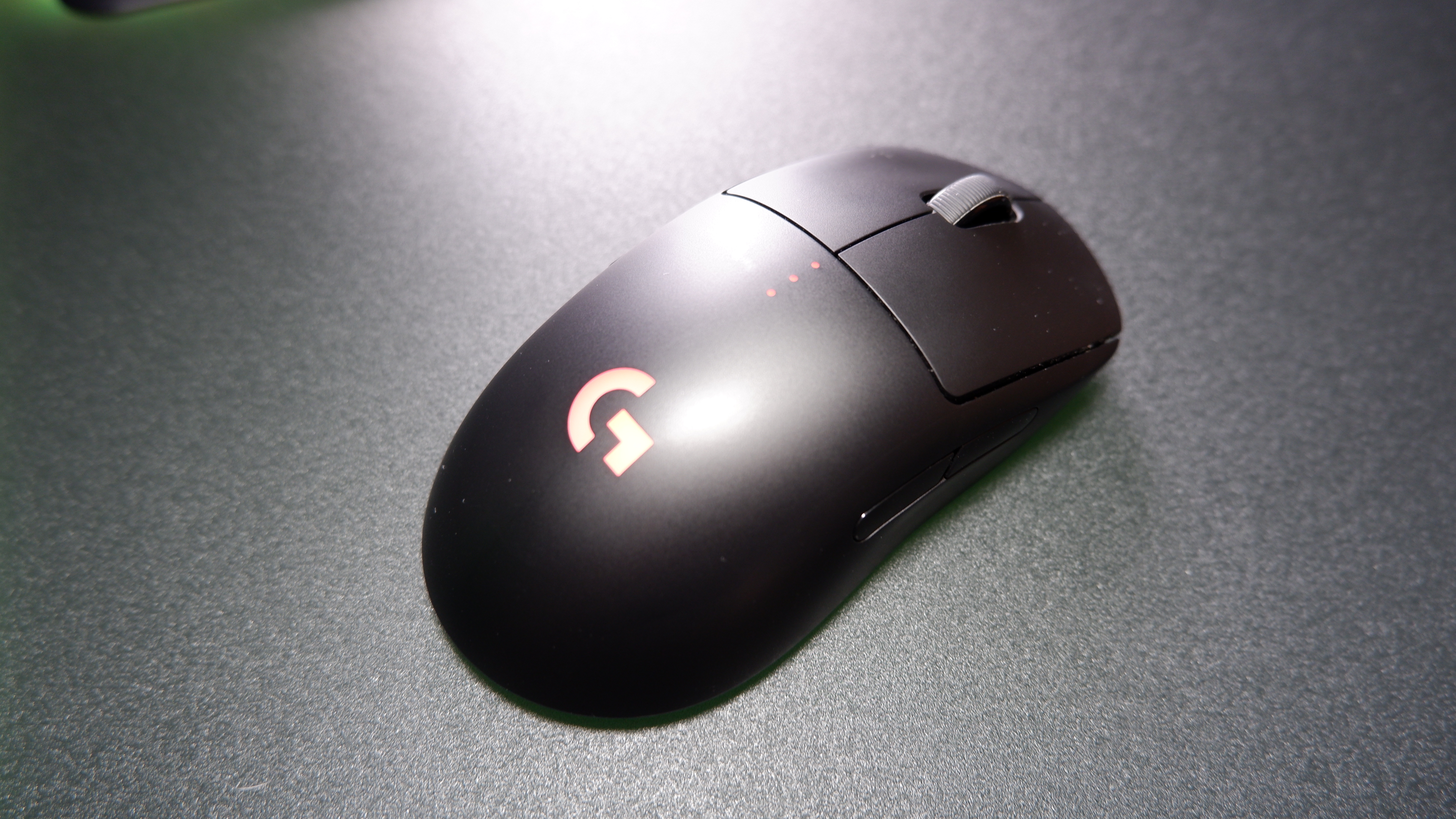

5. Logitech G Pro
Our expert review:
Specifications
Reasons to buy
Reasons to avoid
✅ You're a leftie: Seems kinda obvious, doesn't it? But we've tested a fair few ambidextrous mice, and the G Pro sits top among them for a reason: It's simply brilliant no matter which hand you favour.
✅ You want reliability: Our Jacob has been furiously clicking his Logitech G Pro sample for five years now, and not once has it complained. It's remarkably robust and a superb daily driver.
❌ You want USB-C: Here's the main reason why you might want to pay extra for the Logitech G Pro 2 instead. The Micro-USB connection of the OG G Pro is fine, but if you want USB Type-C, it's the more expensive upgraded model for you.
For left-handed gamers, it can sometimes feel like their choices are limited when it comes to gaming mice, as the majority are designed for righties. Rejoice then, dear lefties, because the Logitech G Pro isn't just the best ambidextrous mouse, but one of the best mice you can buy full stop.
Before we begin, I should point out that the Logitech G Pro 2 Lightspeed also exists, and it's a fine mouse. But we've elected to pick the older model instead, because it's still widely available and you can usually find it for half the price. The G Pro 2 features a number of small upgrades that don't really change anything fundamental about the mouse for most users, so the super-attractive price point of the original G Pro wins the day.
What you get here is a form factor that allows for right- and left-handed grips, thanks to an ambidextrous chassis design and swappable magnetic side buttons. But don't think we're recommending this mouse merely because of its ambi-handed party trick, because truth be told, this is a phenomenal gaming mouse for just about anyone.
At its heart lies one of Logitech's Hero 25K sensors, and it's no word of a lie to say it's one of our favourite mouse sensors of all time. It's speedy, super responsive, and built to last, much like the rest of this mouse. Okay, it might not be a 55-gram ultralightweight, but at 80 grams it's far from heavy, and many on the team would say that the mega-light mouse market is an exercise in diminishing returns anyway.
Our Jacob has been using his Logitech G Pro for five years as a daily driver, and it's still going as strong as the day he pulled it from the box. Logitech knows how to make a tough yet brilliant gaming mouse, and the G Pro holds the distinction of being one of our longest-term test models still in daily usage.
Plus, Jacob has his absolute pick of gaming mice to choose from, and this is the one he keeps coming back to. How's that for an endorsement?
There is one slight fly in the ointment, however, and it's the charging port. It's plenty robust, but unfortunately, Micro-USB. If you want USB Type-C, it's the G Pro 2 you should be looking at—and really, that's one of the only reasons you should consider buying the newer model over the older one.
Still, even with that caveat, there's no better ambidextrous mouse than the original Logitech G Pro. It's not just a great gaming mouse for left-handers, it's a great gaming mouse full stop.
Best ergonomic wireless gaming mouse
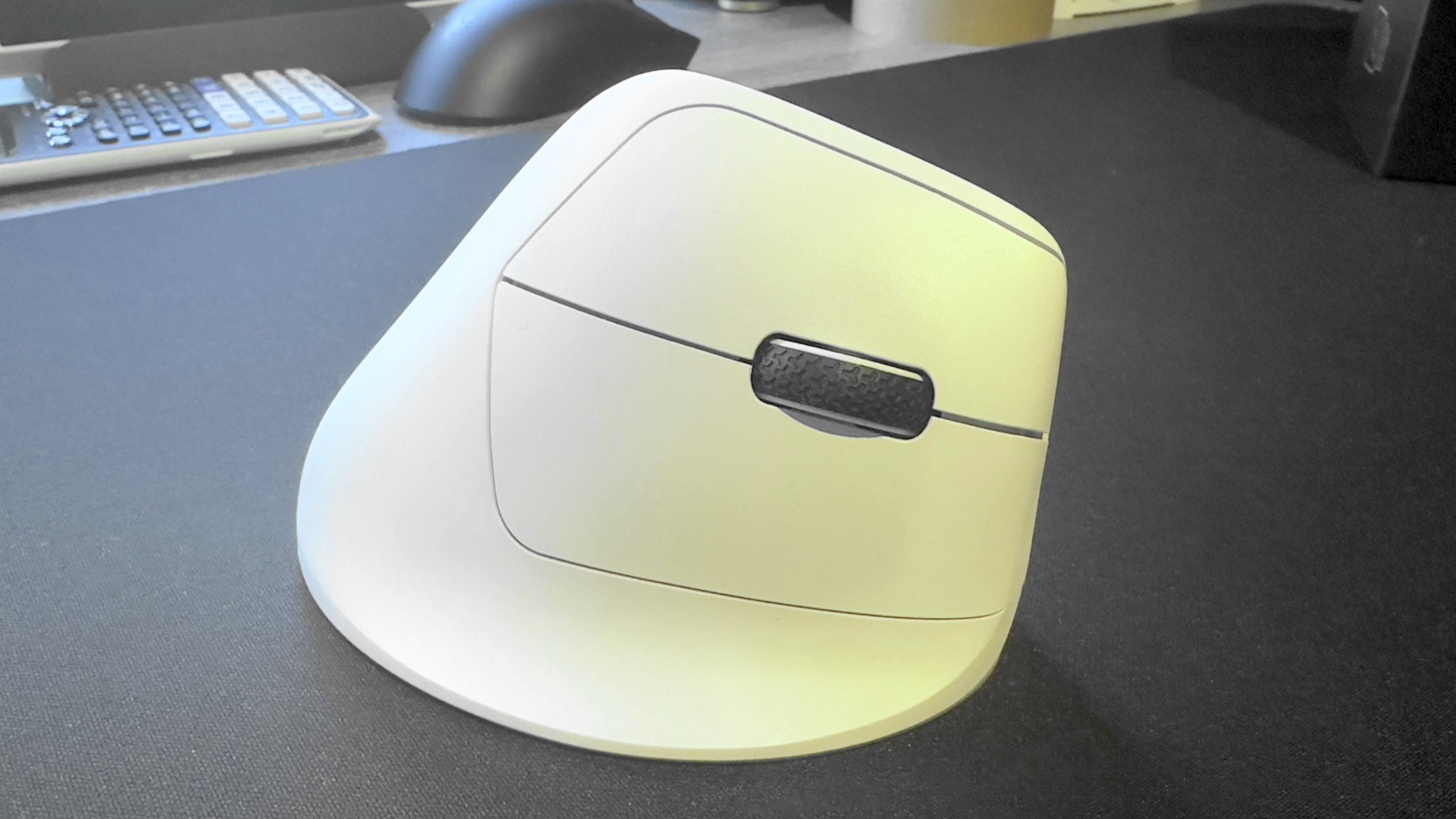
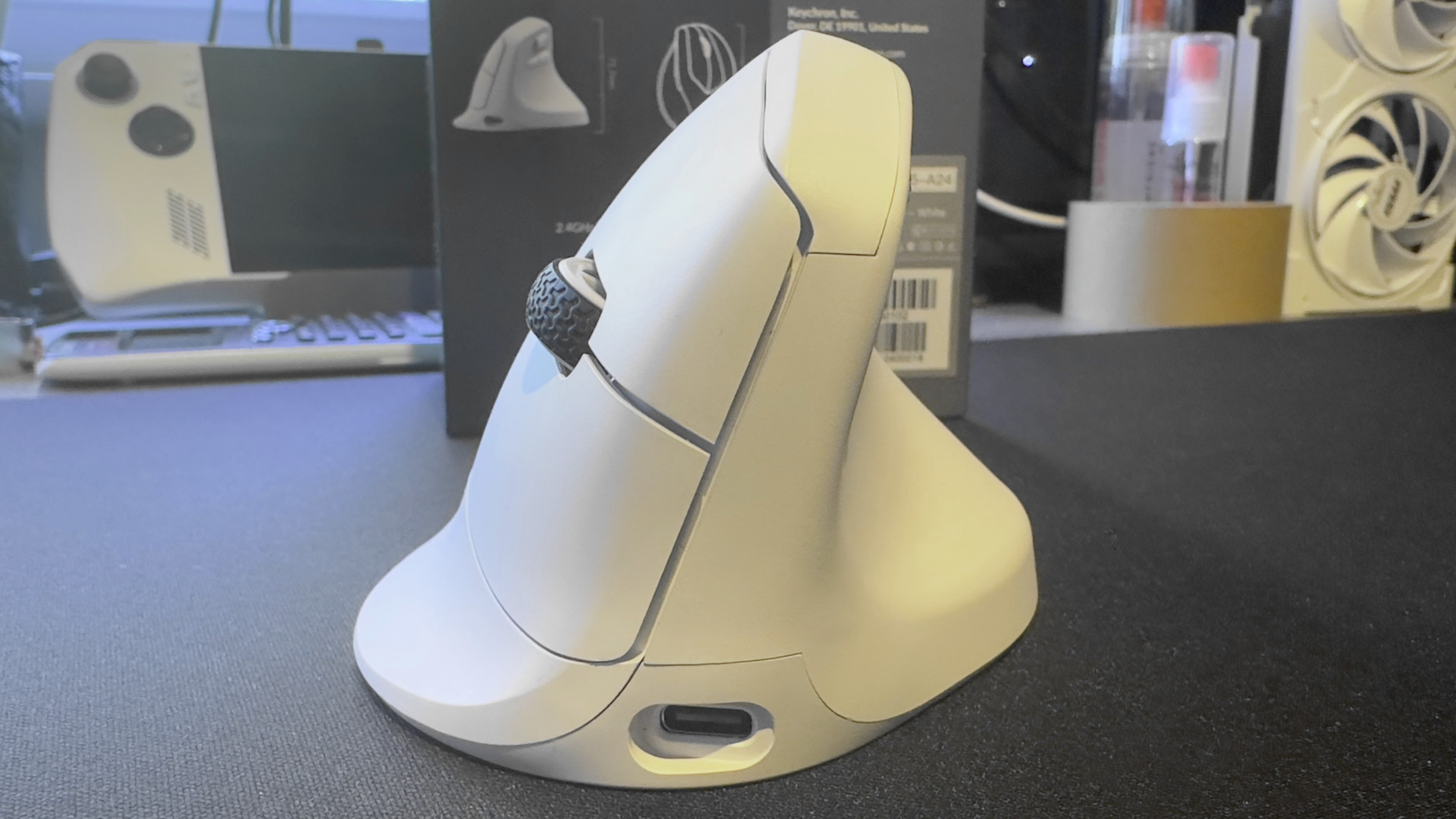
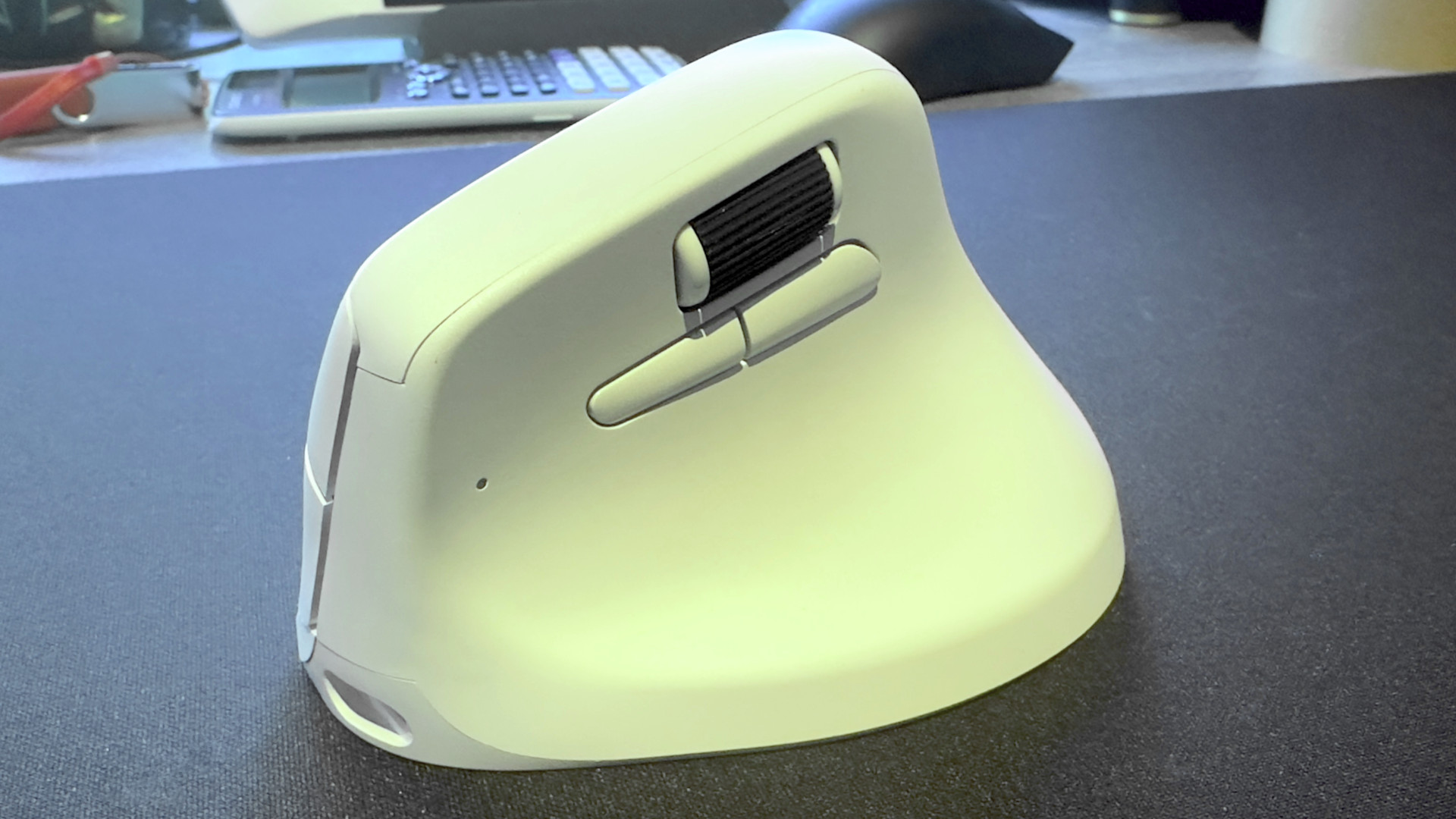
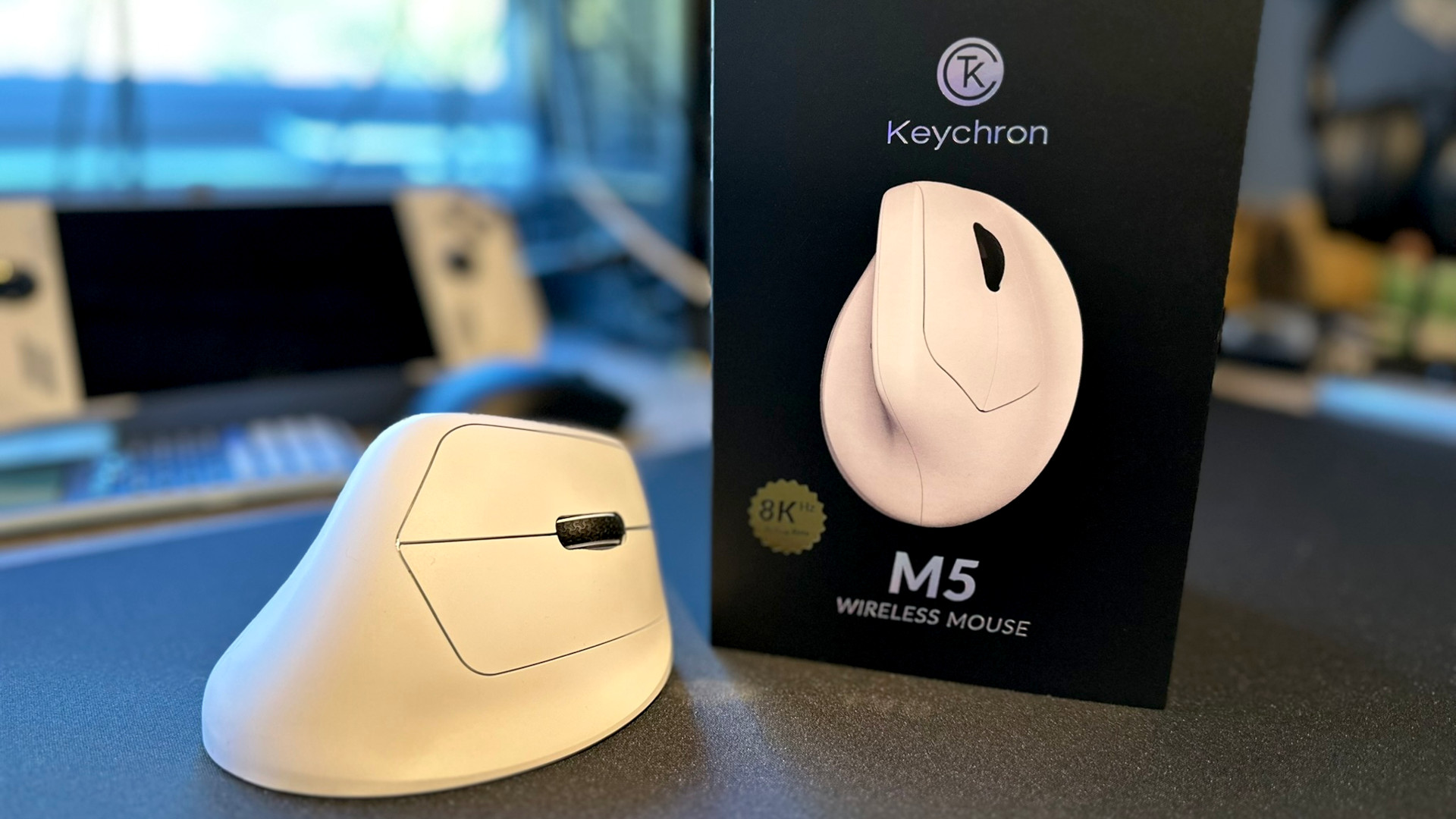
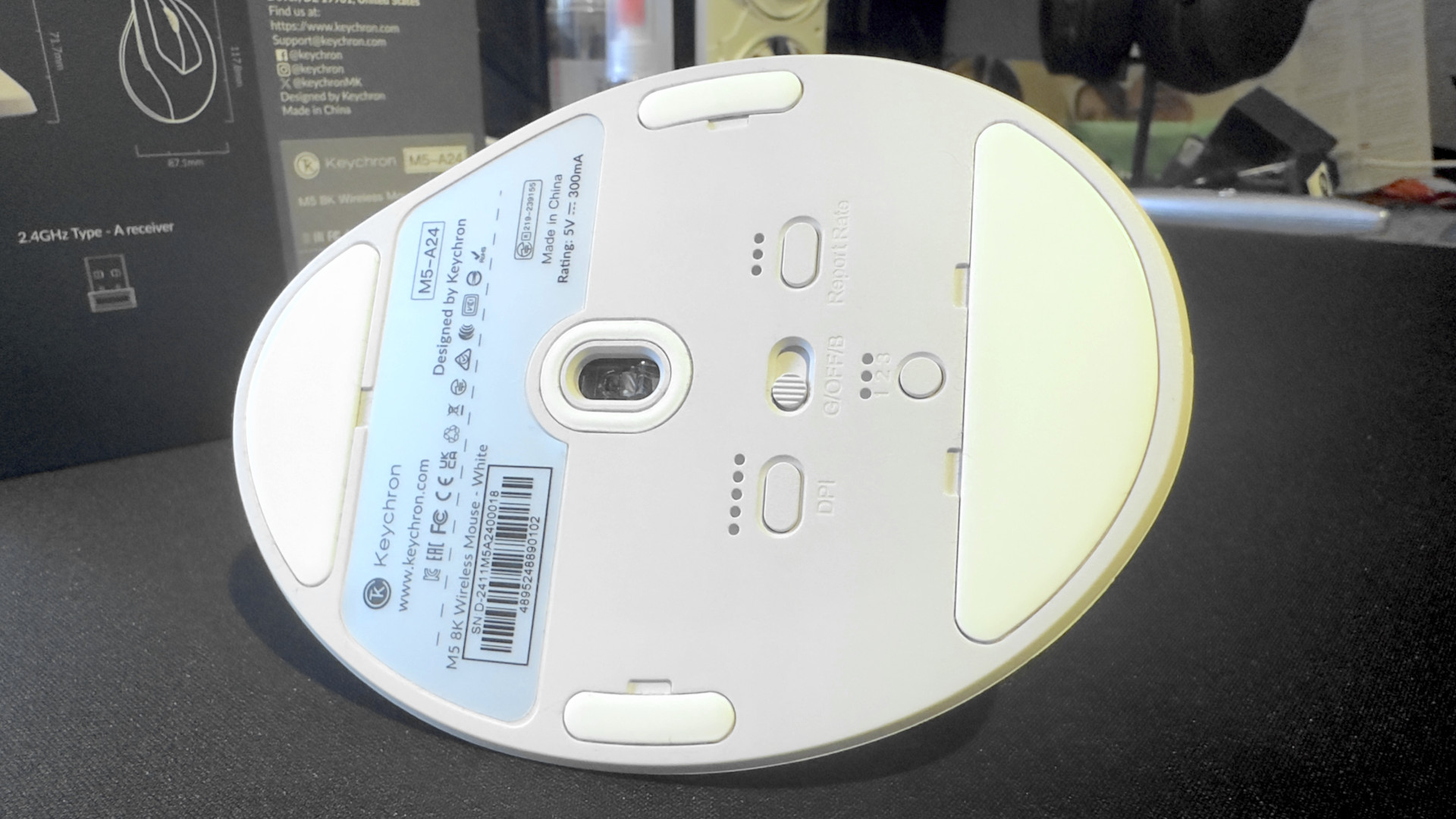
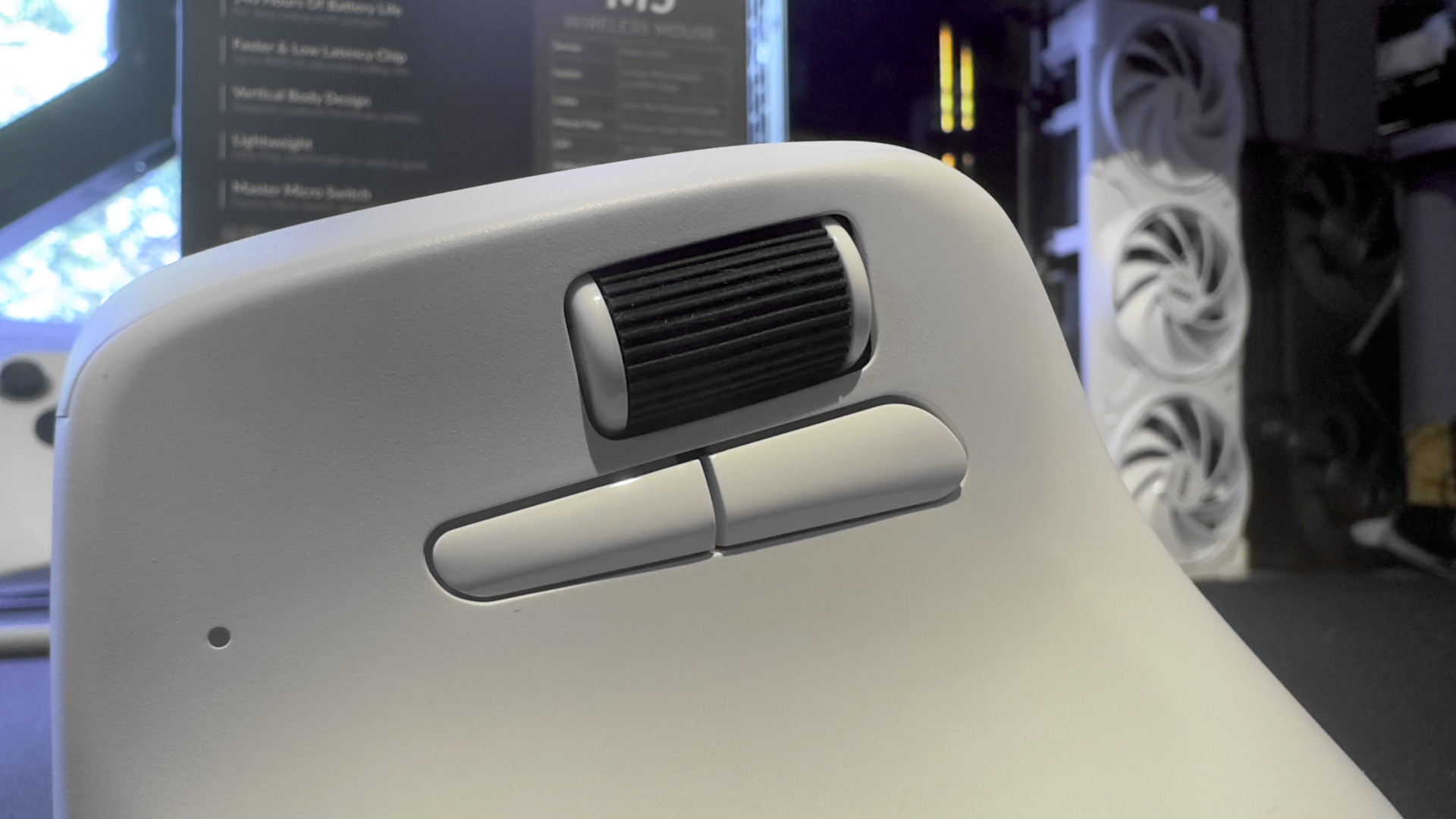
Specifications
Reasons to buy
Reasons to avoid
✅ You use your gaming PC for other things: If you spend a lot of time using your PC—for work or study, for instance—there's a lot of a value to using an ergonomic mouse to help prevent injury.
❌ You mainly play fast-paced shooters: While the M5's sensor is good for gaming, it's still a vertical mouse and these aren't the easiest to be accurate with during fast-paced gameplay.
Ergonomic mice don't tend to get a lot of air time in the PC gaming sphere, and that's because there are few that have the gaming chops in addition to the comfort chops. Not so with the Keychron M5, though. This mouse is the best ergonomic wireless gaming mouse primarily because it packs in a great, accurate sensor alongside that vertical shape.
One of the main benefits to using a vertical mouse is that it should go some way towards preventing problems such as repetitive strain injury (RSI). The idea is that your wrist is placed at a more comfortable and natural angle, and your fingers can easily squeeze to press the mouse buttons, and all of this is more natural than the usual mouse holding and clicking position.
The Keychron M5 combines all the benefits of this form factor with a genuinely impressive sensor that reaches up to 30,000 DPI and a polling rate of up to 8 kHz (although you'll probably want to keep it lower than that anyway for battery life and system use). During his testing, our Nick found the sensor to be very accurate for a vertical mouse in practice, too, although it doesn't quite keep up with the best of the best of dedicated gaming mice.
And to be clear, while Keychron isn't marketing this specifically as a gaming mouse, the sensor and polling rate are certainly in line with an accurate gaming rodent. The question is to what extent a vertical mouse can be a gaming mouse at all, and the answer seems to be: to some extent, but not completely.
It's definitely easier to make small, accurate movements with a standard mouse, and a vertical mouse can nudge around a bit when you press its buttons. That's especially true for the M5, which has slippery mouse feet. It does have a wide base, though, which makes it a little more stable and less likely to topple. You probably won't want to use it for fast-paced shooters, but for slower games that require less quick accuracy, it does just fine.
At 95 g it's not the heaviest mouse in the world, either, though it doesn't keep up with the latest batches of lightweight gaming mice such as the Turtle Beach Burst Air II. In fact, despite the rough surface texture initially rubbing him the wrong way, Nick says this is "one of the most comfortable mice I have used for a very long time. So much so that using a traditionally designed mouse just feels quite painful after long use, in comparison."
And that's the rub, really: It's not the best pick for fast-paced gaming performance, but it's incredibly comfy and ergonomic and it does what it says on the tin incredibly well. Throw in the fact that it has two scroll wheels for better productivity and quad (yes, quad) wireless connectivity—three Bluetooth, one 2.4 GHz—for a very reasonable price and you have a winner. If ergonomic credentials is the name of the game, look no further than the Keychron M5.
Read our full Keychron M5 review.
Best customizable gaming mouse
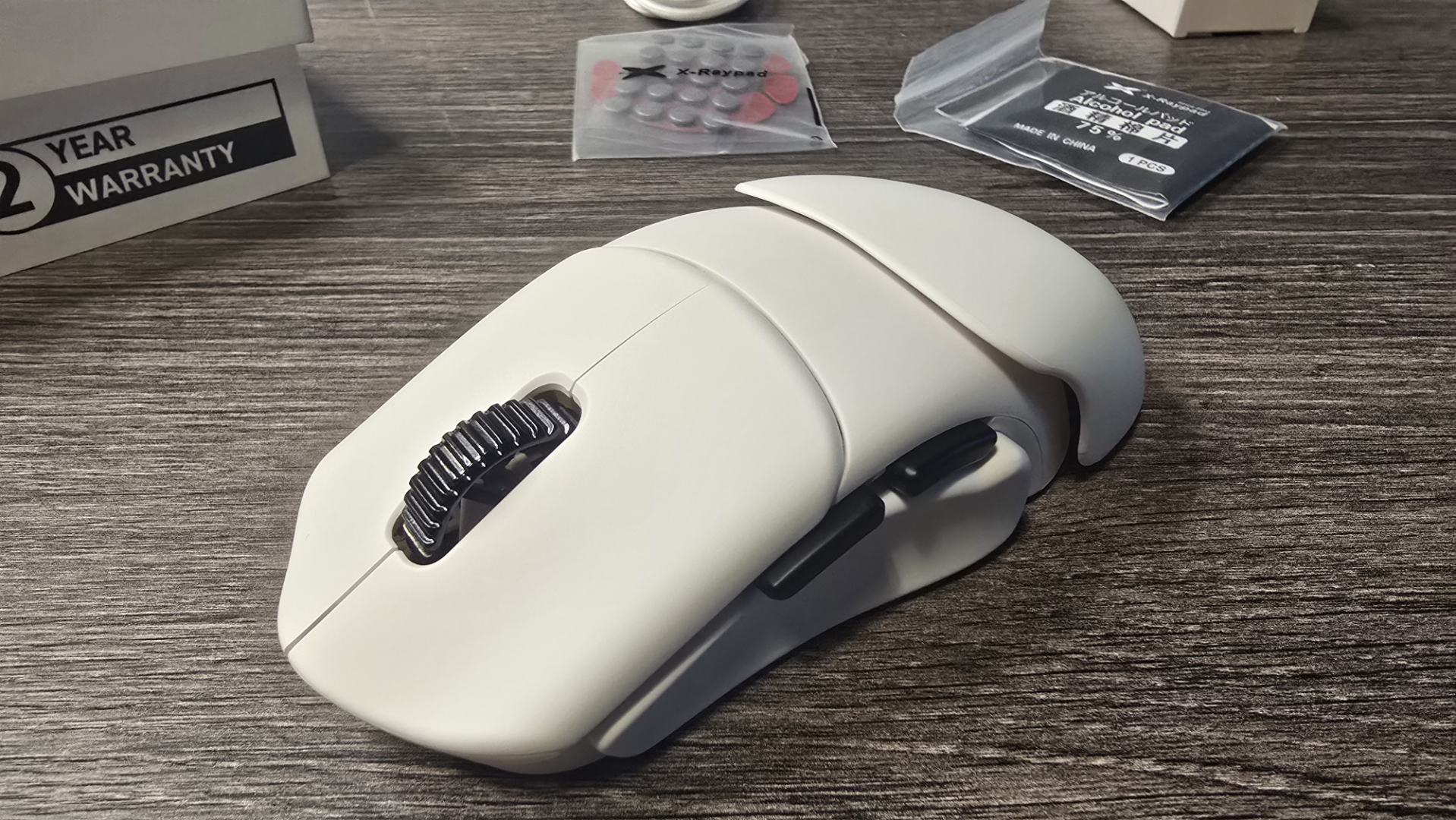
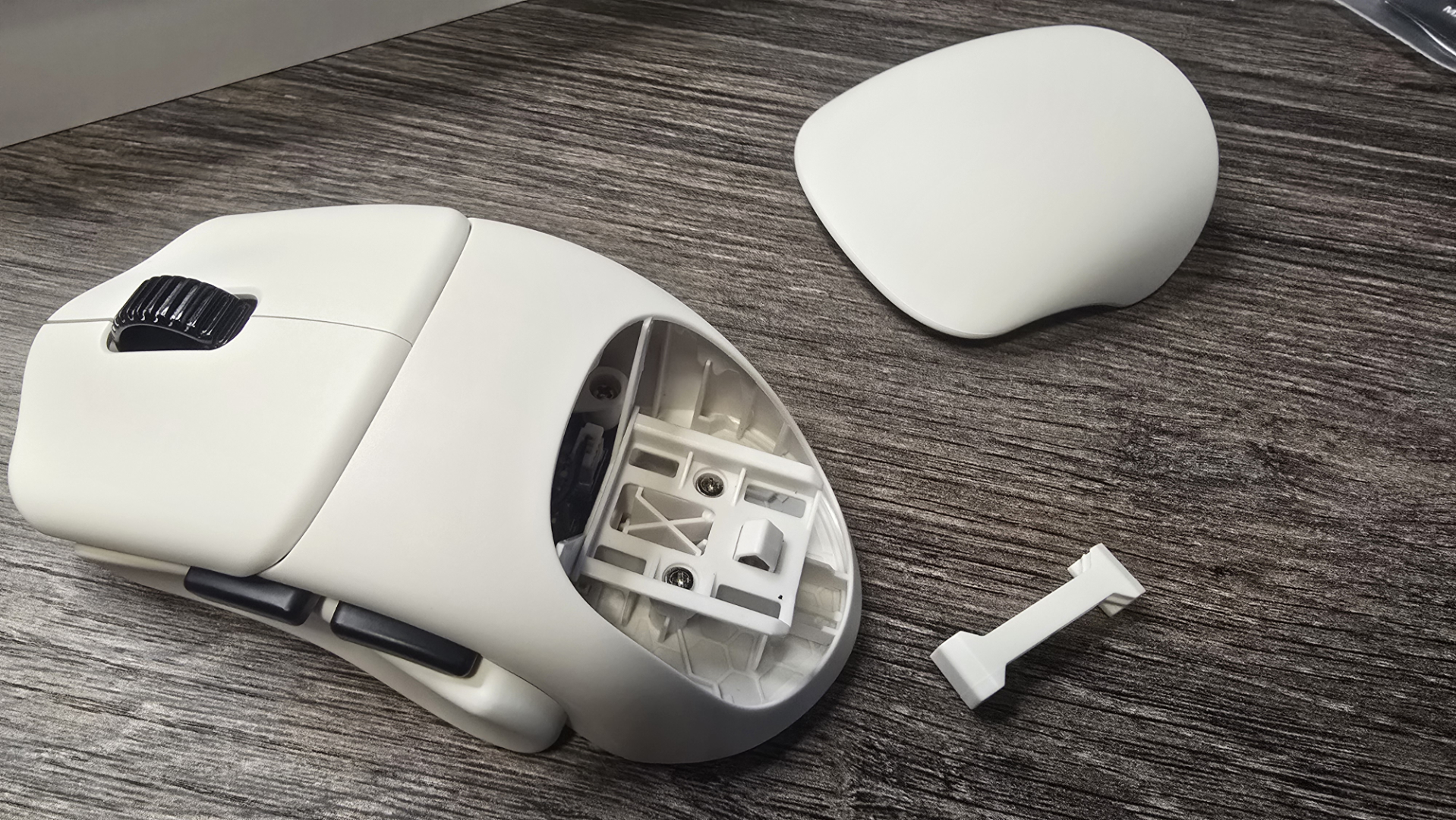
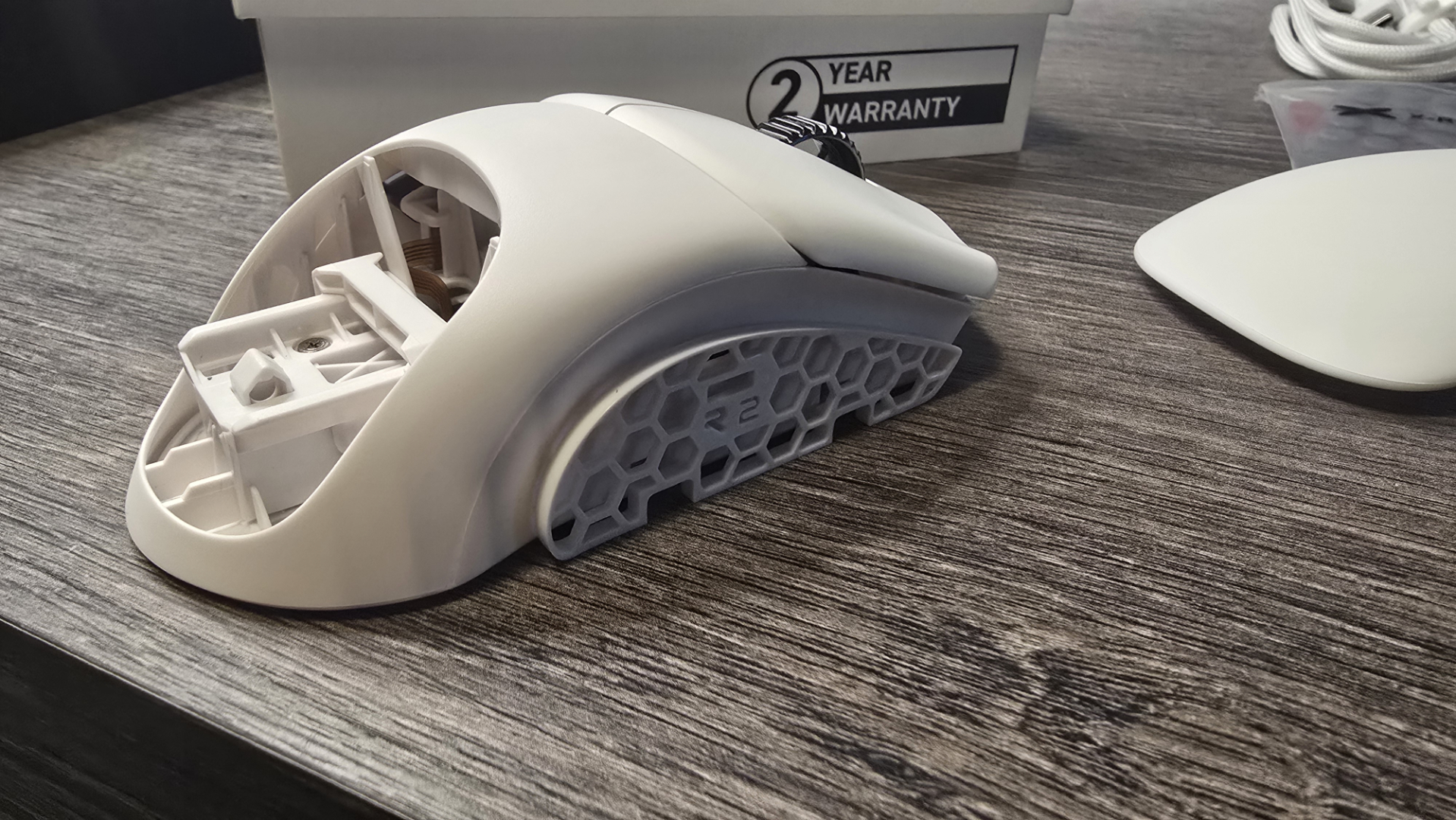
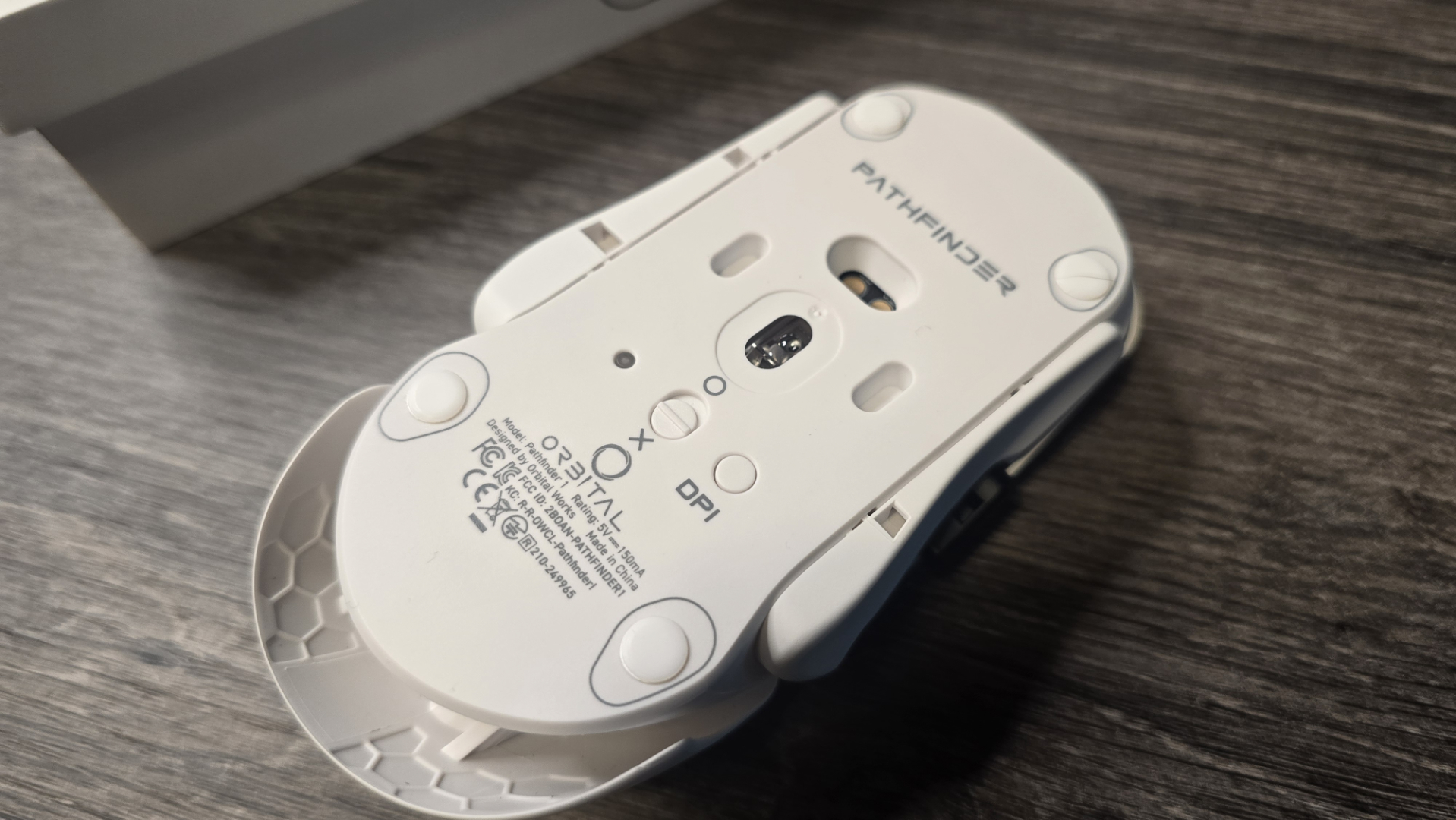
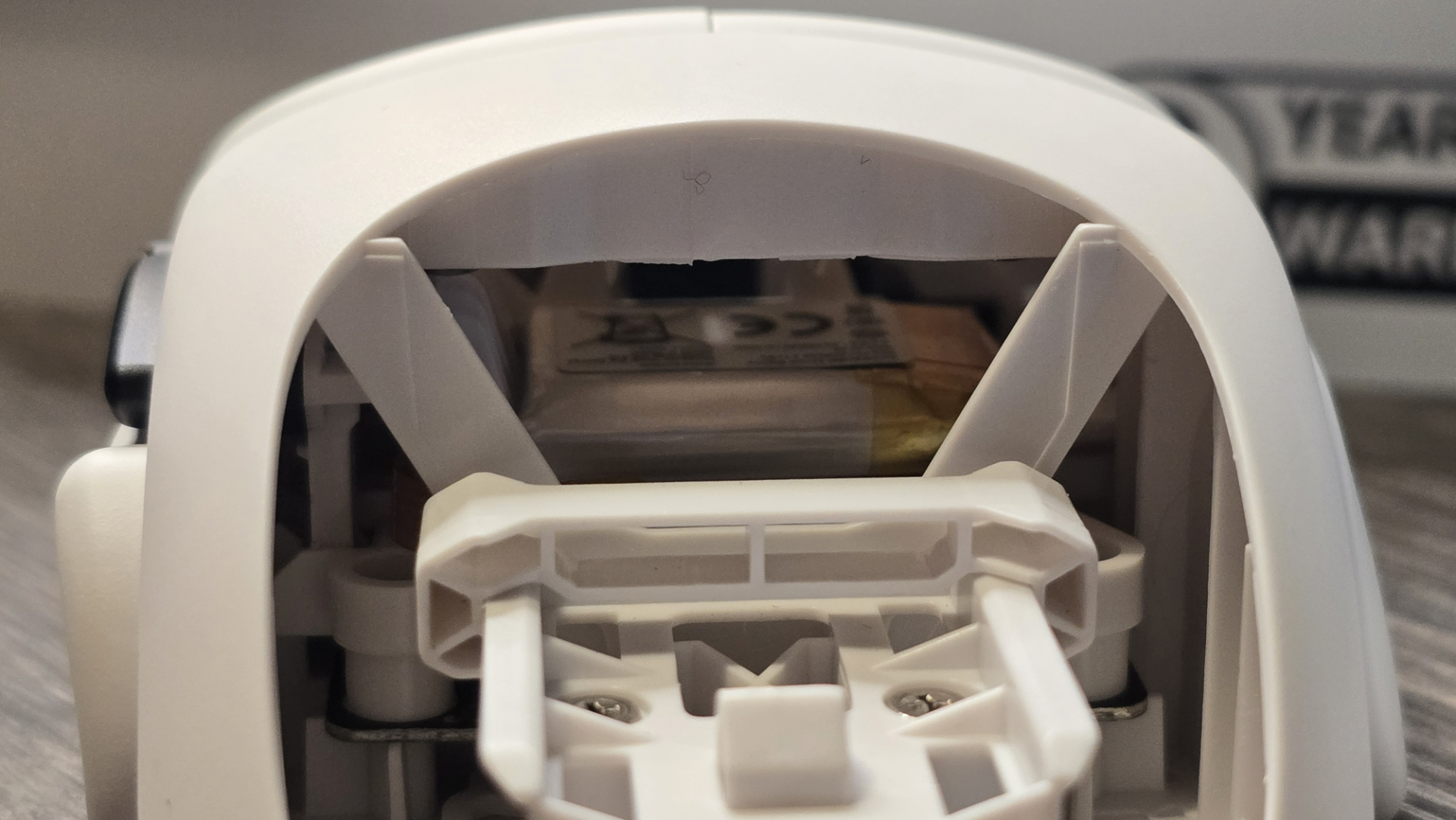
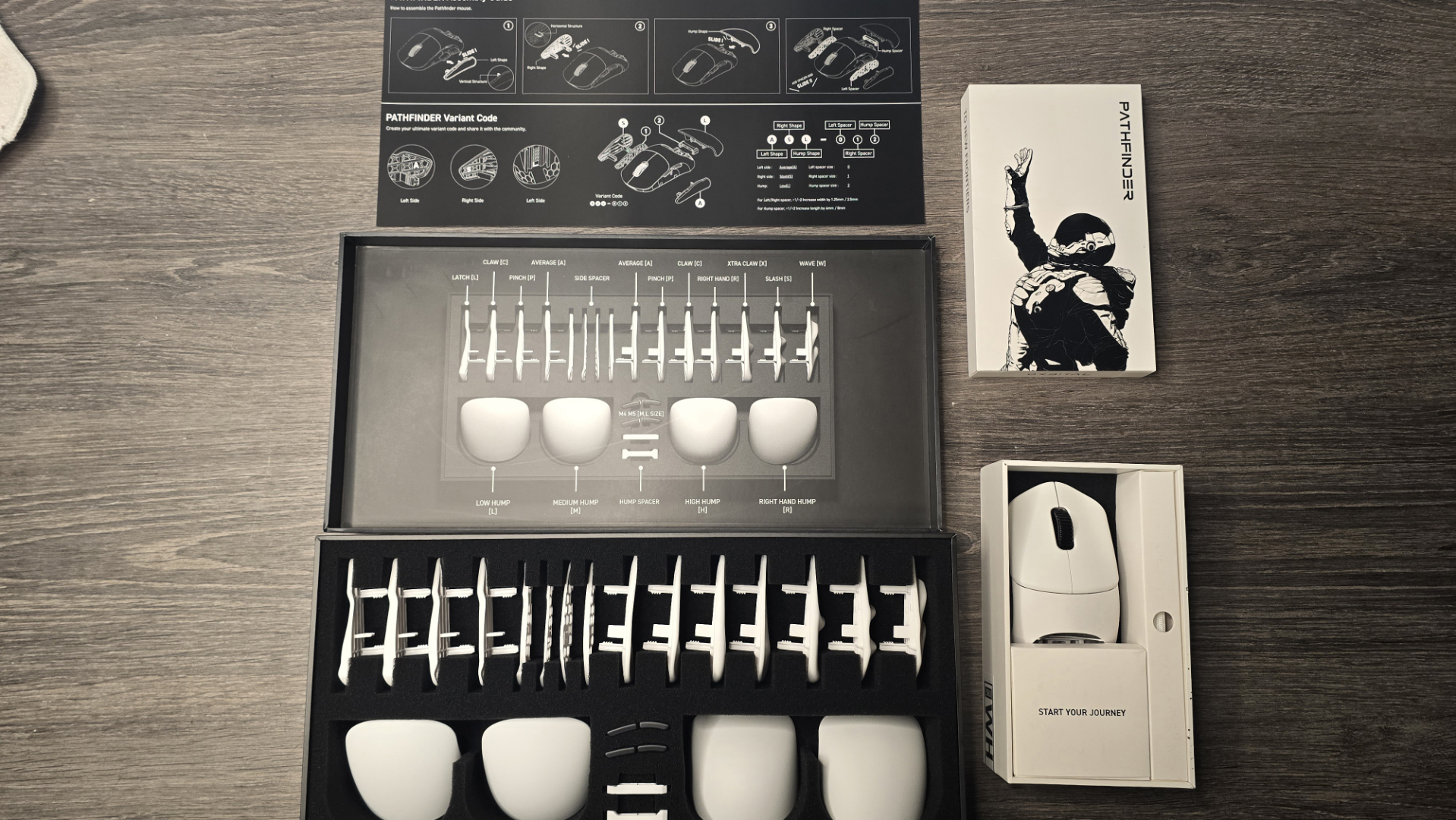
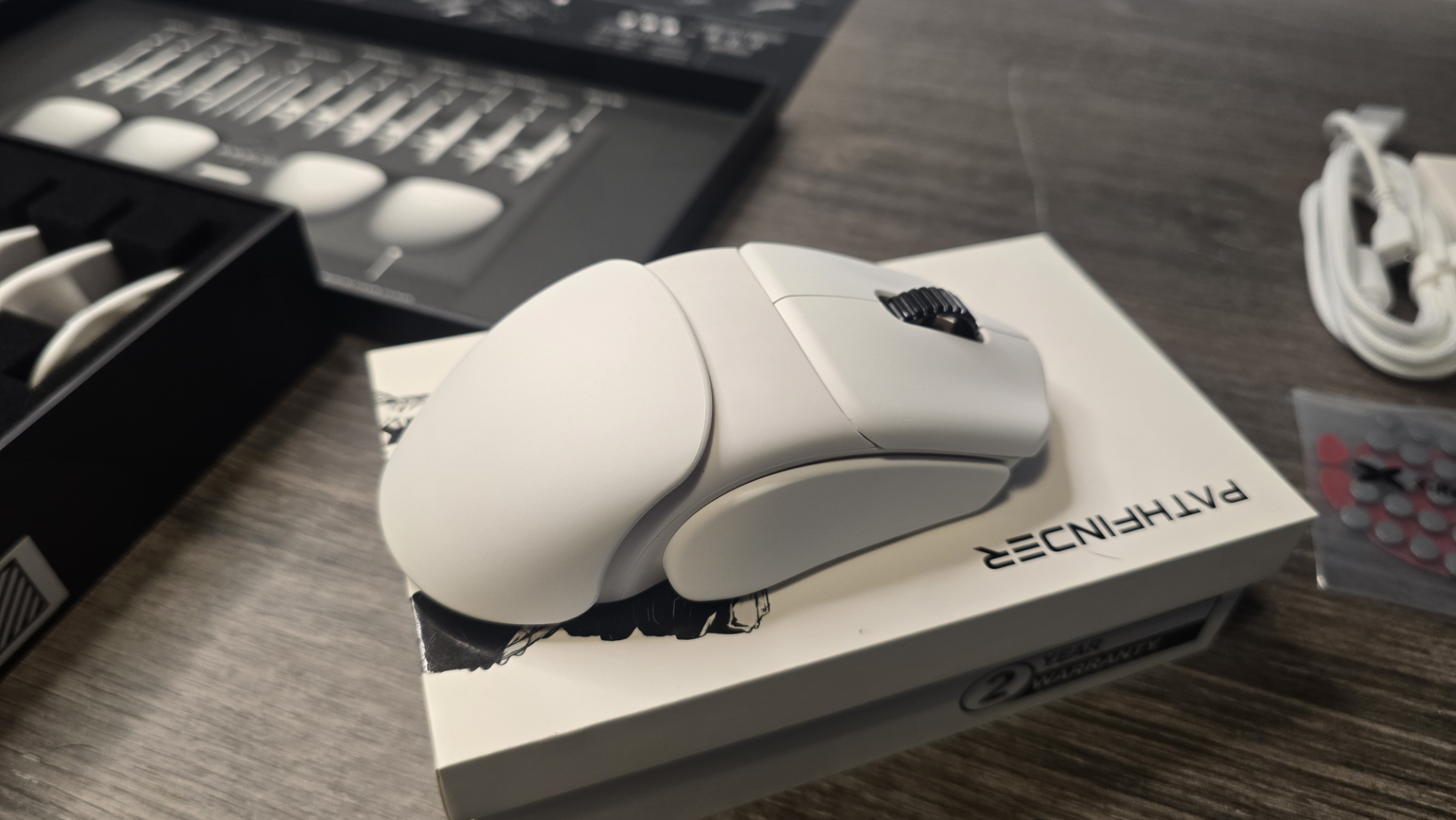
Specifications
Reasons to buy
Reasons to avoid
✅ You want to build your own mouse: If you're after the ultimate lightweight gaming mouse complete with a top-tier sensor and your own custom fit, then there's no mouse that does it better than this.
❌ You want 8,000 Hz polling wired: Sadly, that's only reserved for the wireless mode, and it'll run out of juice in a day if you do use it that way.
Ever wondered what it would be like to have a top-tier gaming mouse that fits your hand perfectly? That's exactly what the Orbital Pathfinder lets you do, thanks to its wealth of swappable plates and rear panels, which is why it's the best customizable gaming mouse you can buy right now.
The Pathfinder's technical specifications are par for the course with the best gaming mice around. It sports PixArt's PAW3950 sensor, which boasts a maximum sensitivity of 30,000 DPI, a top tracking speed of 750 IPS, and a peak acceleration of 50G. Other mice might be a little better in these aspects, but few gamers will be left wanting.
As is rapidly becoming the norm, the Pathfinder uses a wireless 2.4 GHz dongle that supports up to 8 kHz polling. However, like all such mice with this kind of capability, it will quickly drain the battery life in a matter of hours. You can use it wired, though the mouse's USB controller limits the polling rate to 1 kHz.
While the Pathfinder's low weight (between 52 and 55 grams) isn't the lightest you can come across, it still feels very airy and breezy, and fast gaming will not be an issue of any kind. However, Orbital isn't marketing the Pathfinder as being the quickest or most lightweight mouse on the market.
What makes the Pathfinder special is the vast array of customization options. In the box, there are multiple rear and side panels to swap about. For example, if you need a bulkier mouse that fills your hand, then fitting the 'high hump' rear panel and the 'claw' side panels will tick that box.
The main drawback to this freedom of choice is the price tag, and the Pathfinder currently sells for almost $190. That makes it one of the most expensive gaming mice around, though it's only $30 more than Razer's Viper V3 Pro, which has very similar specs and no options for changing its shape.
So while the Orbital Pathfinder is very pricey, you are getting a top-spec gaming mouse with more customization options than pretty much any other mouse you can buy.
Read our full Orbital Pathfinder review.
Also tested
Logitech MX Master 4
The latest iteration of Logitech's classic ergonomic mouse for office work and gaming now offers haptic feedback, more weight, and a bigger price tag. Little of which is welcome, so you might as well just stick with the MX Master 3.
PC Gamer score: 78%
Read our full Logitech MX Master 4 review.
8BitDo Retro R8
If you want to have a classically-styled mouse in your life, but don't want any of the horrors that ancient mice had, then 8BitDo's Retro R8 could just be the thing for you. It's very niche, but in a good way.
PC Gamer score: 87%
Read our full 8BitDo Retro R8 review.
Turtle Beach Burst II Air
At first glance, you would be forgiven for thinking the Turtle Beach Burst II looks and feels cheap. However, thanks to its ultra-lightweight design, incredible battery, and software that makes personalising the mouse’s settings a breeze, it’s honestly one of the best competitive gaming mice we've tried in a long time. But the new Corsair Sabre V2 is just that much lighter and has pipped it.
PC Gamer score: 85%
Read our full Turtle Beach Burst II Air review.
Razer Naga Pro
A fantastic wireless update to an already excellent MMO/MOBA mouse. That chunky housing contains high-end performance, great battery life, and supreme versatility.
PC Gamer Score: 90%
Read our full Razer Naga Pro review.
Razer DeathAdder V3 HyperSpeed
No, you're not experiencing déjà vu, this is a very, very similar chassis to the top gaming mouse in this guide, the Razer DeathAdder V4 Pro. You'll find this V3 model for a lot cheaper, and it's still truly excellent, but the V4 does enough to earn the new top spot instead.
PC Gamer score: 91%
Read our full Razer DeathAdder V3 HyperSpeed review.
Razer Pro Click V2 Vertical Edition
As vertical mice go, this new entry into the field by Razer is a very nice affair, with superb comfort and stability. It is very heavy, though, and less than ideal for fast gaming.
PC Gamer score: 80%
Read our full Razer Pro Click V2 Vertical Edition review.
Keychron M7 8K Wireless
A solid gaming mouse with a competitive price and an 8,000 Hz dongle for the esporters. The shape won't be to everyone's taste, though.
PC Gamer score: 81%
Read our full Keychron M7 8K Wireless review.
Razer Basilisk Mobile
This dinky version of Razer's classic Basilisk gaming mouse is decent enough, but it's far too expensive for what you're getting, and there are smaller and cheaper mice on the market.
PC Gamer score: 55%
Read our full Razer Basilisk Mobile review.
Endgame Gear XM2w 4K
Lovely to use for long gaming sessions, Endgame's XM2w 4K superb comfort is spoiled by its relatively short battery life. If you don't mind frequently charging your mouse, it might be worth considering.
PC Gamer score: 83%
Read our full Endgame Gear XM2w 4K review.
Endgame Gear OP1w 4K
Lightweight and super accurate, this could be an ideal pick for any esports fan. However, the battery life is worse than other gaming mice at this price, and the software is very dated.
PC Gamer score: 73%
Read our full Endgame Gear OP1w 4K review.
PowerColor Alphyn AM10 Wireless review
This mouse has a lot to like about it: fast, accurate, and comfortable. Unfortunately, the battery life is quite poor, and there are better mice around for the same money. And less, for that matter.
PC Gamer score: 75%
Read our full PowerColor Alphyn AM10 Wireless review.
SteelSeries Rival 3 Gen 2 Wireless
This mouse is great if you want a reasonably priced Jack of all trades, thanks to its compatibility with removable, rechargeable batteries and dual Bluetooth and 2.4 GHz connectivity. Unfortunately, however, it's a little too weighty and has a mushy, squeaky scroll wheel, which, when combined with its mediocre sensor, makes it a less-than-ideal pick for gaming.
PC Gamer score: 66%
Read our full SteelSeries Rival 3 Gen 2 Wireless review.
NZXT Lift Elite
Boasting lightweight but quality construction, plus a high polling rate to boot, the NZXT Lift Elite does so much right. Unfortunately, we're already spoiled for choice when it comes to the best wireless gaming mice, and this contender does little to stand out among the competition.
PC Gamer score: 74%
Read our full NZXT Lift Elite review.
Glorious Series 2 Pro
The Series 2 Pro feels very accurate and has some great specs, but it's quite expensive, especially for a stripped-down squeaker with clunky software.
PC Gamer score: 72%
Read our full Glorious Series 2 Pro review.
Asus ROG Harpe Ace Mini
Super fast and accurate, the ROG Harpe Ace Mini might be all the mouse you need, but not if you're on a tight budget. Or have large hands. Or you hate ultra-light mice.
PC Gamer score: 83%
Read our full Asus ROG Harpe Ace Mini review.
Logitech G Pro 2 Lightspeed
The Logitech G Pro 2 Lightspeed is a very comfortable and smooth mouse that feels in no way necessary. It is a good reason to replace the previous Pro on Logitech's site, but not a reason to sell off your old model.
PC Gamer score: 80%
Read our full Logitech G Pro 2 Lightspeed review.
⬇️ Click to load more tested gaming mice⬇️
Lemokey G1
The Lemokey G1 is a great little mouse that only slightly over-reaches in its pursuit of an 8,000 Hz polling rate, as it's both dubious in its implementation and has questionable necessity. As a standard 1,000 Hz mouse, however, it's a responsive, speedy wireless gaming mouse and a great value option.
PC Gamer score: 81%
Read our full Lemokey G1 review.
Logitech Pro X Superlight 2 Dex
The Superlight 2 Dex feels like a very insular design for Logitech. Being basically the Superlight 2 but with a different shape, it doesn't feel very aware of its competition, but it's a light change on an already great mouse.
PC Gamer score: 84%
Read our full Logitech Pro X Superlight 2 Dex review.
Turtle Beach Kone II Air
The Kone 2 Air improves tenfold on its predecessor, bringing Bluetooth, better ergonomics and a fantastic scroll wheel to the design. It feels like a premium mouse, and it delivers on battery life as well as supporting software. You couldn't ask for much more from a heavy, wireless gaming mouse.
PC Gamer score: 89%
Read our full Turtle Beach Kone II Air review.
Razer DeathAdder V3 Pro
This brilliant rodent was previously our pick for the best wireless gaming mouse, but we reckon the HyperSpeed version is better value. If you don't mind flashing a little extra cash, though, the V3 Pro is still a fabulous choice.
PC Gamer score: 89%
Read our full Razer DeathAdder V3 Pro review.
Glorious Model O 2 Wireless
A snappy sensor and great response make this mouse a great choice for competitive gamers who are looking for a little extra aesthetically and feature-wise. It's surprisingly reasonable price tag doesn't go amiss, either.
PC Gamer score: 84%
Read our full Glorious Model O 2 Wireless review.
Glorious Model D 2 Pro 4K/8KHz Edition
This mouse is comfy, lightweight, and has a good sensor. However, in our testing, we experienced some dropouts with the wireless connection.
PC Gamer score: 66%
Read our full Glorious Model D 2 Pro 4K/8KHz Edition review.
Razer Viper V3 Pro
The Viper V3 Pro is a superb pick for esports gaming, given its 54 g weight and up to 8 kHz polling. It's a bit of a fingerprint magnet, though, and it isn't as light as our pick for best competitive wireless gaming mouse.
PC Gamer score: 84%
Read our full Razer Viper V3 Pro review.
Glorious Model D 2
Featuring an updated sensor, the second iteration of Glorious's Model D mouse is similarly comfy and performs well. However, it isn't the lightest, and we think there are better lightweight options, such as the Superlight V2.
PC Gamer score: 75%
Read our full Glorious Model D 2 review.
Corsair M75 Wireless
The Corsair M75 Wireless is a great mouse for lefties. It's genuinely ambidextrous because you can move its buttons from one side to the other. Apart from that, though, it's nothing to write home about.
PC Gamer score: 83%
Read our full Corsair M75 Wireless review.
Alienware Pro Wireless
It's certainly a competent effort from Alienware, but really, you're paying a lot of money for a speedy mouse with flimsy side buttons. That's simply not the play as far as we're concerned. Shame, as it's pretty slick otherwise.
PC Gamer score: 73%
Read our full Alienware Pro Wireless gaming mouse review.
Where to find the best deals
Where are the best gaming mouse deals?
In the US:
Amazon - Often some savings on PC gaming peripherals
Walmart - Usually some good savings on mice
Newegg - Big brand gaming mice for cheap
Best Buy - Great place to look for a cheap gaming mouse
In the UK:
Overclockers - Plenty of peripherals to choose from
Wireless gaming mouse FAQ
Best wireless gaming mouse FAQ
PC Gamer's got your back
What's the main reason to choose wireless over wired?
Today, most of the conventional critique about wireless gaming mice is plain out of date. The best wireless gaming mice perform almost indistinguishably from wired ones, without a hint of perceptible lag or stutter to be found. Wired mice are sometimes cheaper, but great budget wireless mice are readily available, so really, it's a personal preference choice at this point.
Do pro gamers use wireless gaming mice?
Modern wireless connections, such as those created by Logitech and Razer, deliver no discernible difference between their wired and wireless mice brethren when it comes to gaming latency. Reportedly, both Ninja and Shroud use a Logitech G Pro X Superlight mouse, so there's clearly nothing wrong with the fact that it's wireless.
How does a wireless mouse connect to my PC?
Most wireless mice offer both 2.4G wireless connections, which will most often require a dedicated USB device, or they'll use Bluetooth. Bluetooth is more widely compatible with a range of devices, however, it usually adds latency to the connection, whereas a 2.4G wireless connection has next to none. This makes it the preferred connection method for gaming.
How we test gaming mice
We've used enough gaming mice to have a good feel for build quality, button placement, and shape. Our opinions on those aspects of mouse design are naturally subjective, but they're also well-informed. The tricky part of testing gaming mice is analyzing the other part of the equation: tracking performance, jitter, angle snapping, acceleration, and perfect control speed, and determining how each of those issues affects the experience of using a mouse.

For that, applications such as Mouse Tester come in handy. We use this software to see if we can spot any glaring issues with the mice we review. In every gaming mouse we test, though, angle snapping and acceleration are disabled in the mouse drivers by default.
For gaming, we primarily test mice with Destiny 2 and Apex Legends and twitchier shooters like Quake Champions to see how our performance stacks up against other mice. We scrutinize the cursor movement and responsiveness for lag, jitter, and other issues.
We use each mouse with its wireless receiver plugged into a nearby USB port, giving it the best possible wireless situation to work with. We also test the wireless receivers plugged into our test system a few feet away, increasing the opportunity for lag and interference.
Wireless gaming mouse jargon buster
Grip refers to how you hold a mouse. The most common grips are palm, claw, and fingertip. Here's a good example of how each grip works.
CPI stands for counts per inch, or how many times the mouse sensor will read its tracking surface, aka your mousepad, for every inch it’s moved. This is commonly referred to as DPI, but CPI is a more accurate term. The lower the CPI, the further you have to move the mouse to move the cursor on the screen.
Jitter refers to an inaccuracy in a mouse sensor reading the surface it’s tracking. Jitter often occurs at higher mouse movement speeds or higher CPIs. Jitter can make your cursor jump erratically, and even slight jitter could wreck a shot in an FPS or make you misclick on a unit in an RTS.
Angle snapping, also called prediction, takes data from a mouse sensor and modifies the output to create smoother movements. For example, if you try to draw a horizontal line with your mouse, it won’t be perfect—you’ll make some subtle curves in the line, especially at higher sensitivities. Angle snapping smooths out those curves and gives you a straight line instead. This is generally bad because it means your cursor movements won’t match your hand’s movements 1:1, and angle snapping will not be useful in most games. Thankfully, almost all gaming mice have angle snapping disabled by default.
Acceleration is probably the most reviled, most scrutinized issue with gaming mouse sensors. When a mouse sensor exhibits acceleration, your cursor will move faster the faster you move the mouse; this is often considered bad because moving the mouse slowly six inches across a mousepad will move the cursor differently than moving the mouse rapidly the same distance. This introduces variability that can be hard to predict.
Perfect control speed, or malfunction rate, refers to the speed at which the mouse can be moved while still tracking accurately. Most gaming mice will track extremely accurately when moved at slow speeds, but low CPI players will often move their mice large distances across the mousepads at very high speeds. At high speeds, especially at high CPIs, not all mouse sensors can retain their tracking accuracy. The point at which the sensors stop tracking accurately will differ between CPI levels.
IPS measures inches per second, and the effective maximum tracking speed of any given sensor is rated too. Not to be confused with the gaming monitor panel type by the same name, the higher the IPS of any given mouse, the better it can keep up with high-speed movement and maintain accuracy.
Lift-off distance is still a popular metric in mouse enthusiast circles, though it does not affect most gamers. LOD refers to the height a mouse has to be raised before the sensor stops tracking its surface. Some gamers prefer a mouse with a very low lift-off distance because they play at very low sensitivity and often have to lift their mouse off the pad to "reset" it in a position where they can continue swiping. With a low LOD, the cursor will not be moved erratically when the mouse is lifted.
Keep up to date with the most important stories and the best deals, as picked by the PC Gamer team.

Dave has been gaming since the days of Zaxxon and Lady Bug on the Colecovision, and code books for the Commodore Vic 20 (Death Race 2000!). He built his first gaming PC at the tender age of 16, and finally finished bug-fixing the Cyrix-based system around a year later. When he dropped it out of the window. He first started writing for Official PlayStation Magazine and Xbox World many decades ago, then moved onto PC Format full-time, then PC Gamer, TechRadar, and T3 among others. Now he's back, writing about the nightmarish graphics card market, CPUs with more cores than sense, gaming laptops hotter than the sun, and SSDs more capacious than a Cybertruck.
- Kizito Katawonga
- Jorge JimenezHardware writer, Human Pop-Tart
- Hope CorriganHardware Writer
- Jacob RidleyManaging Editor, Hardware
- Jacob FoxHardware Writer
- Nick EvansonHardware Writer
